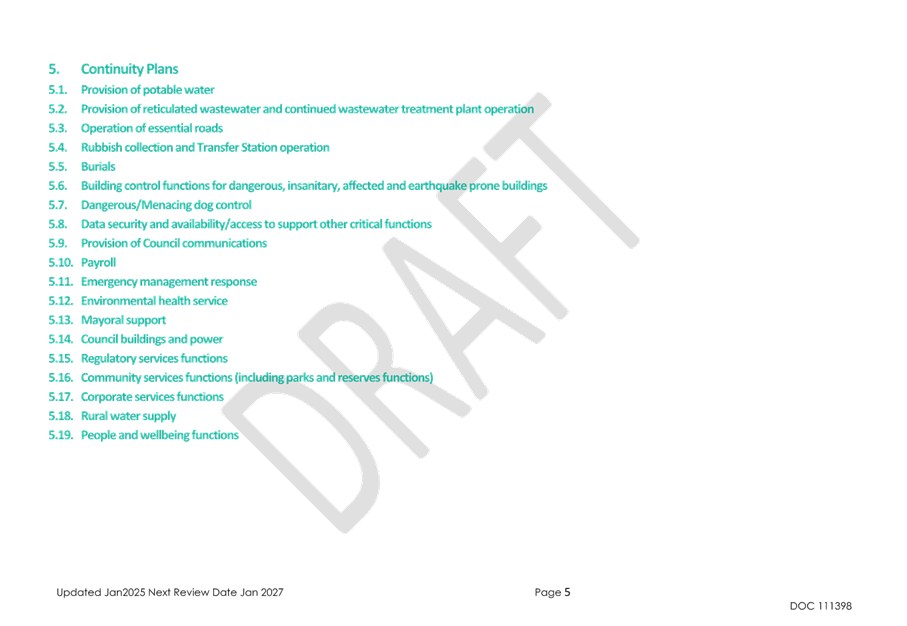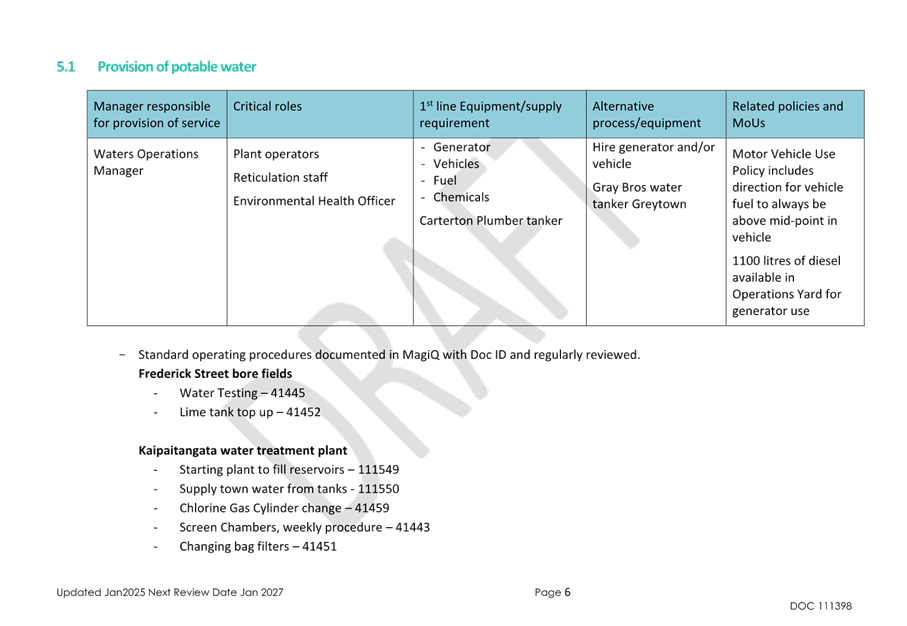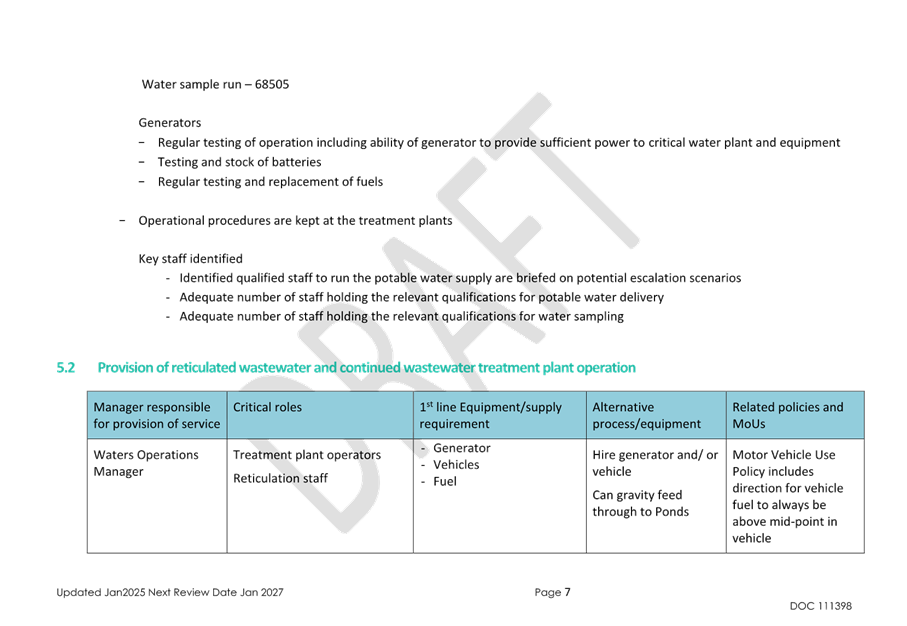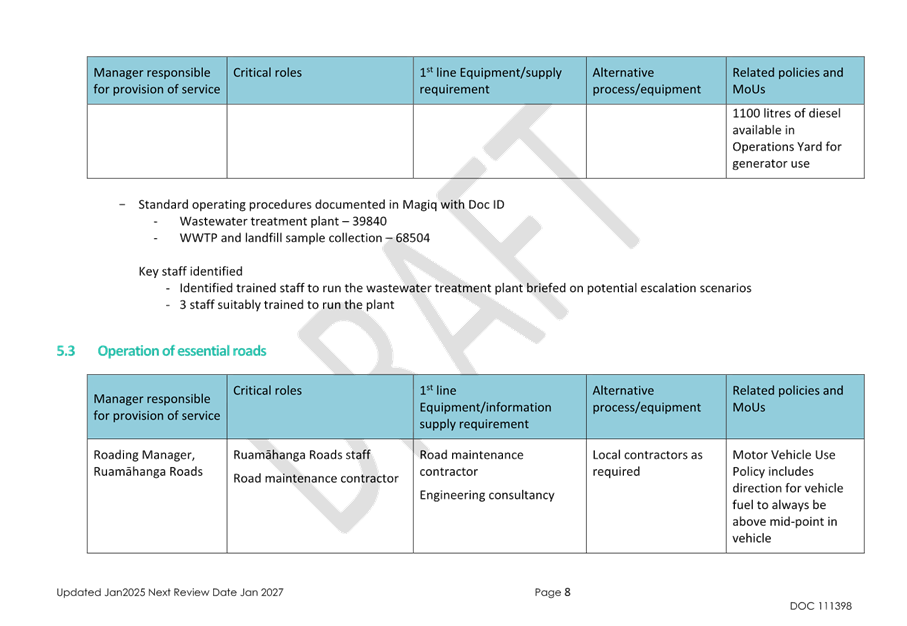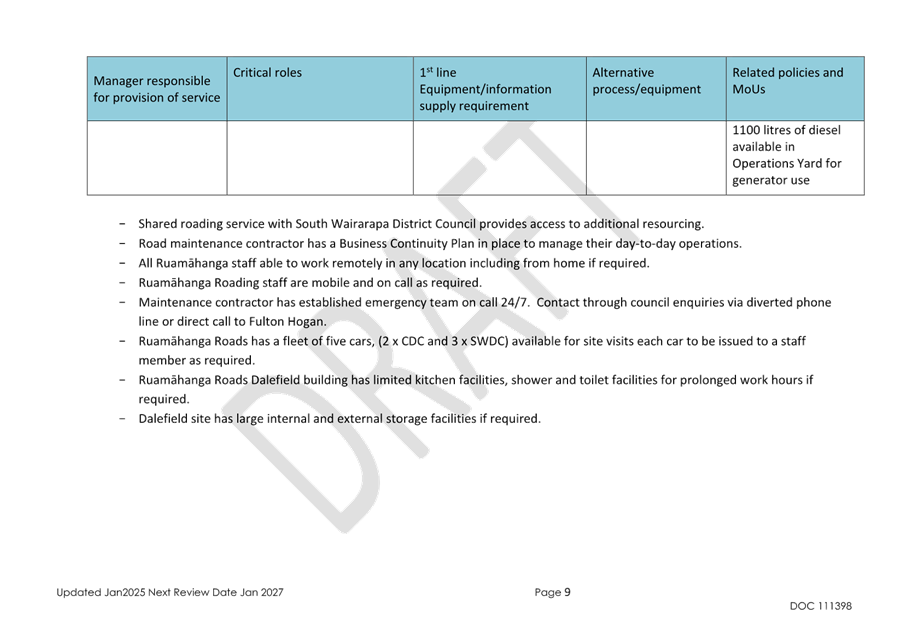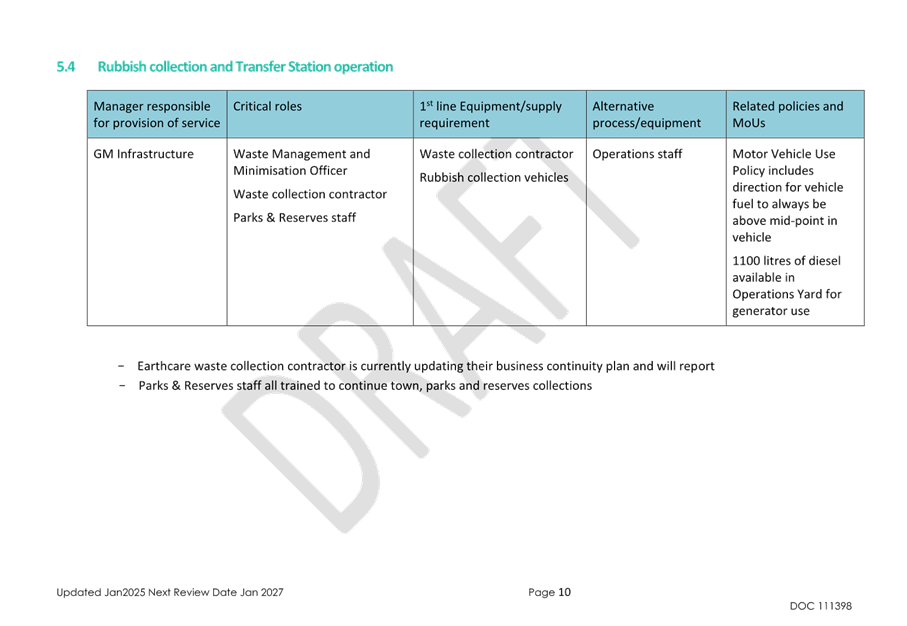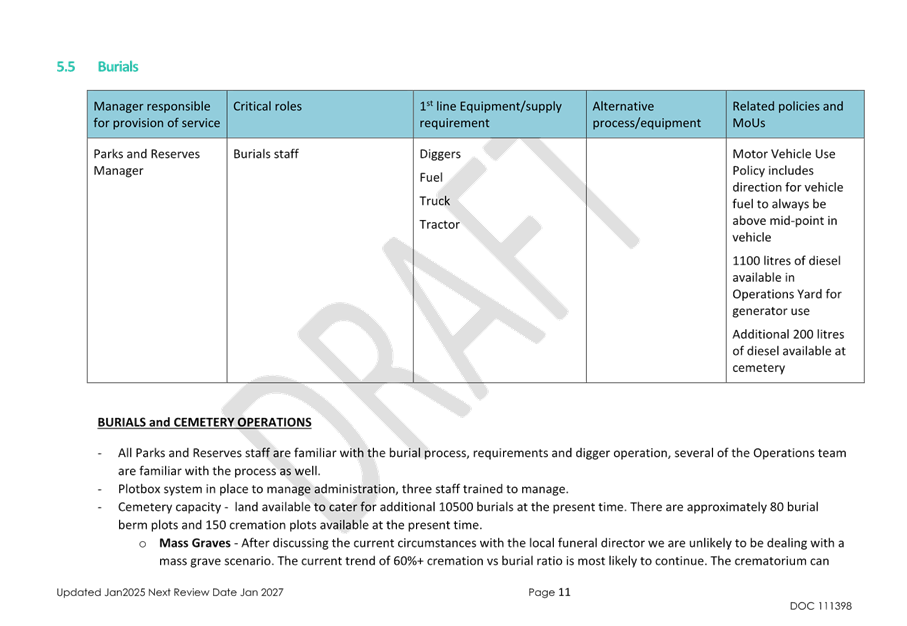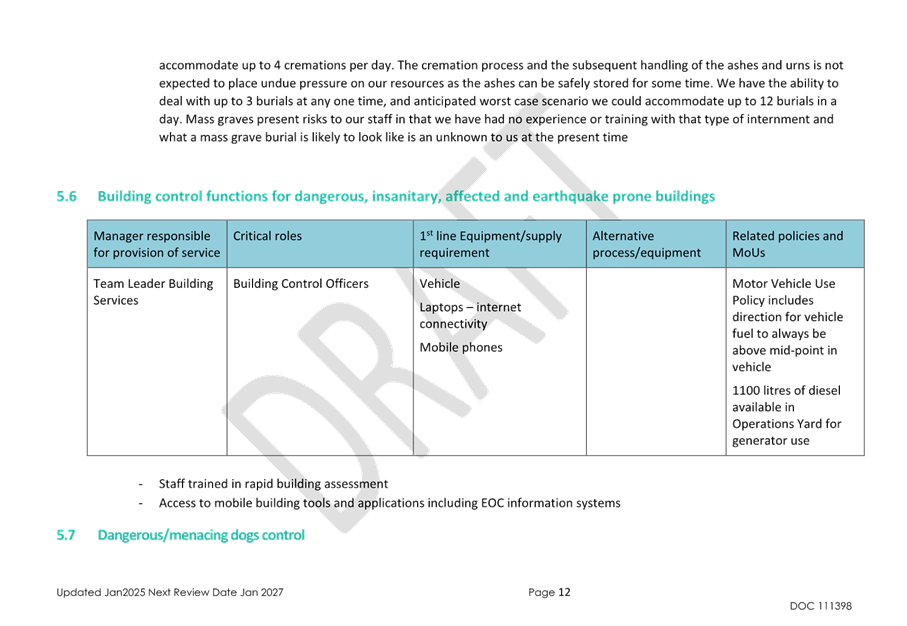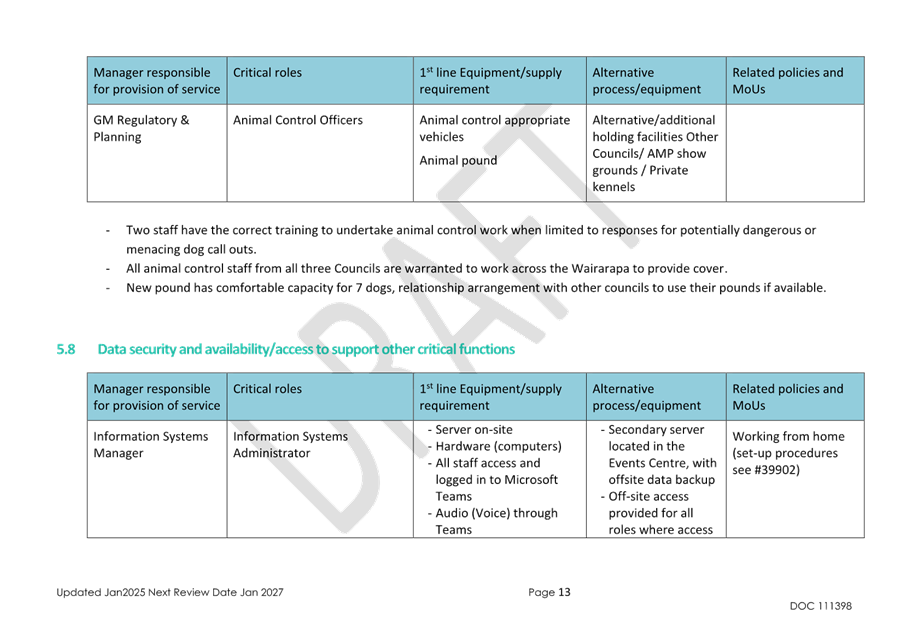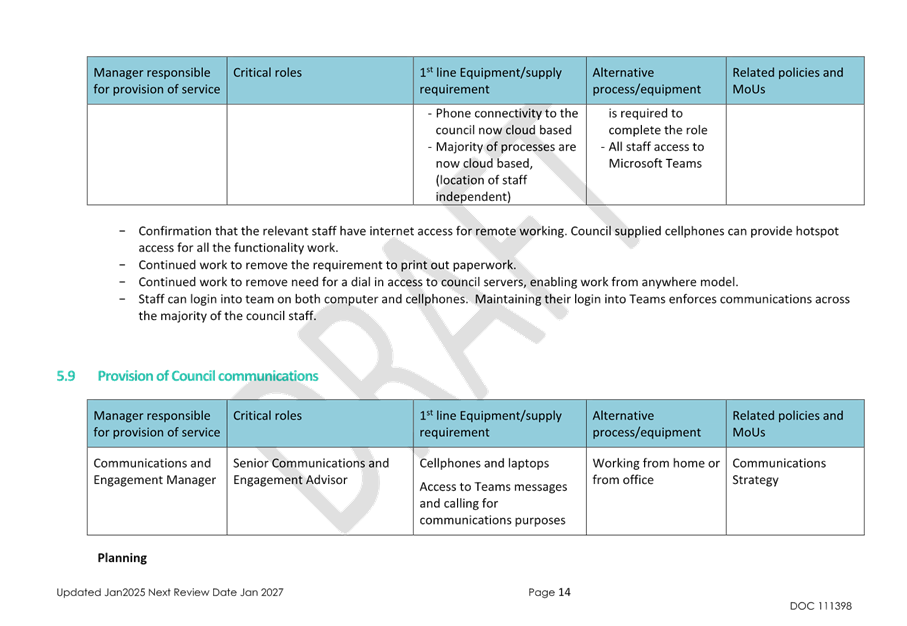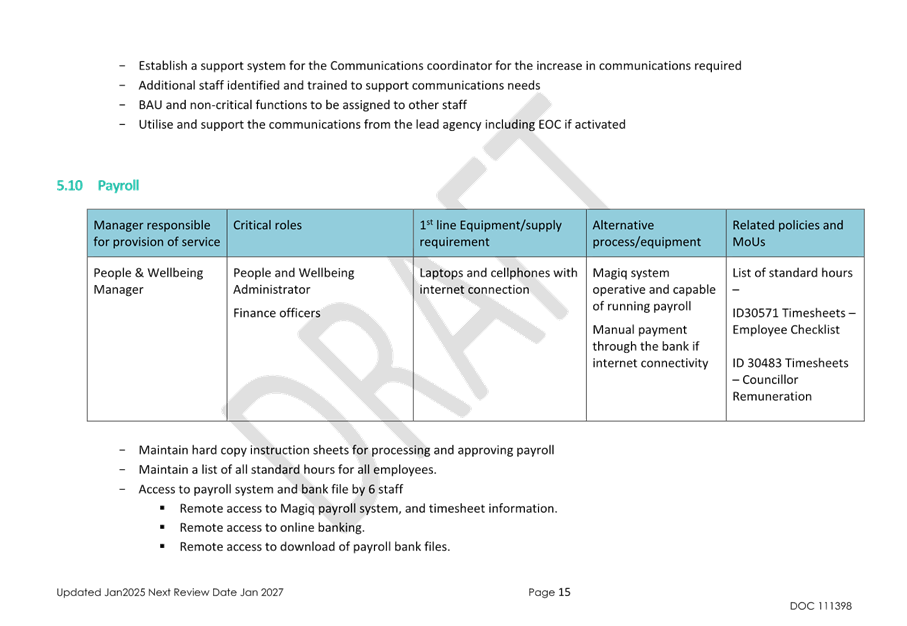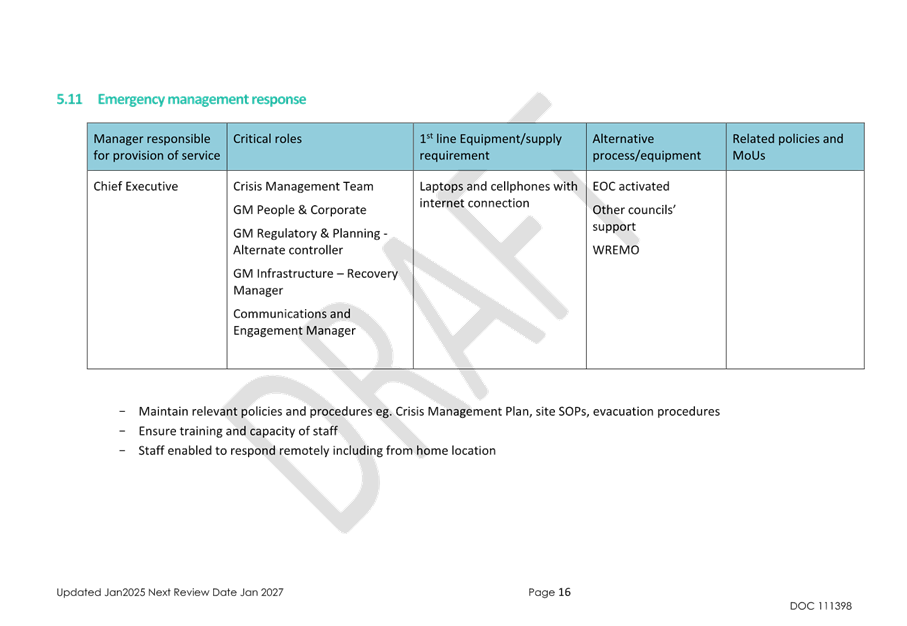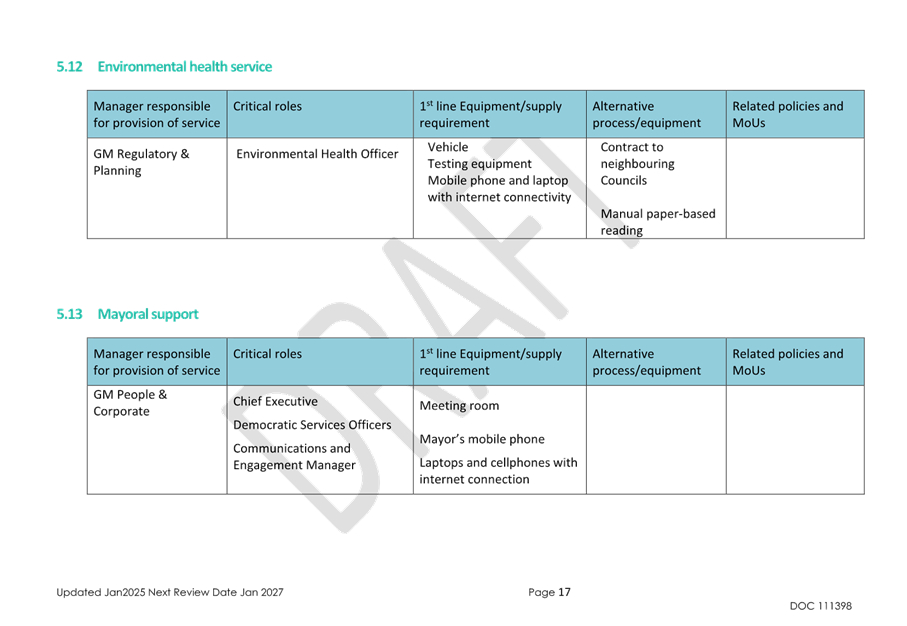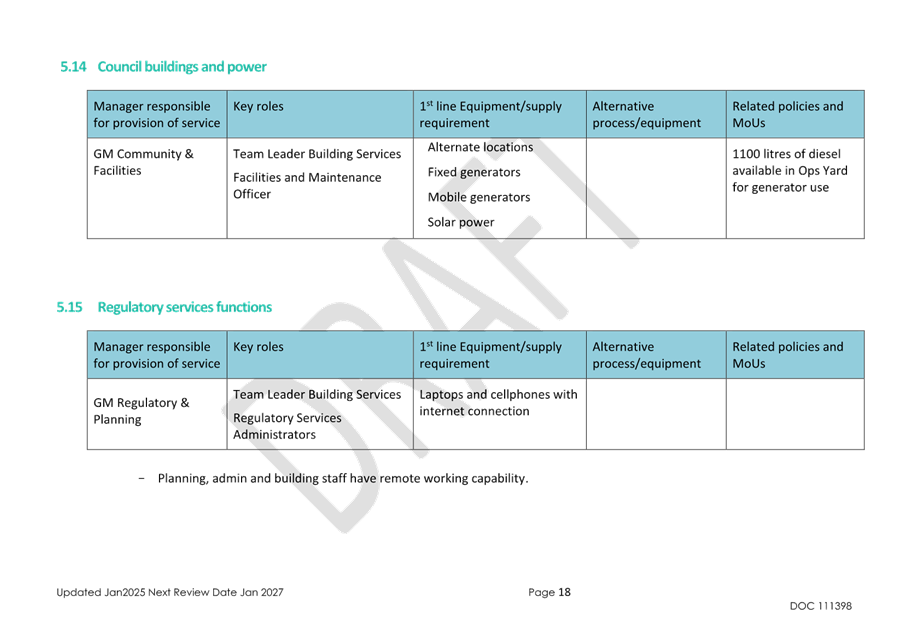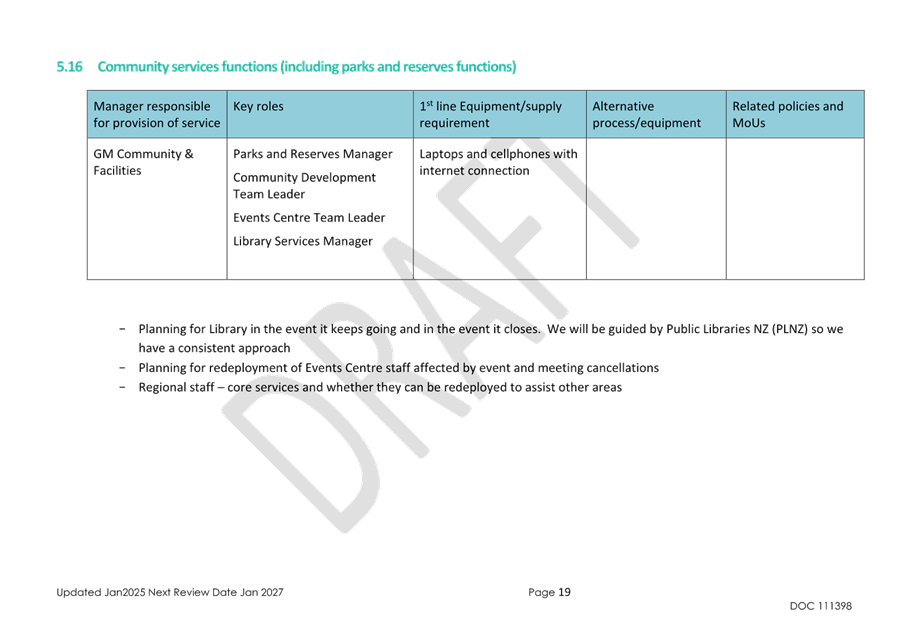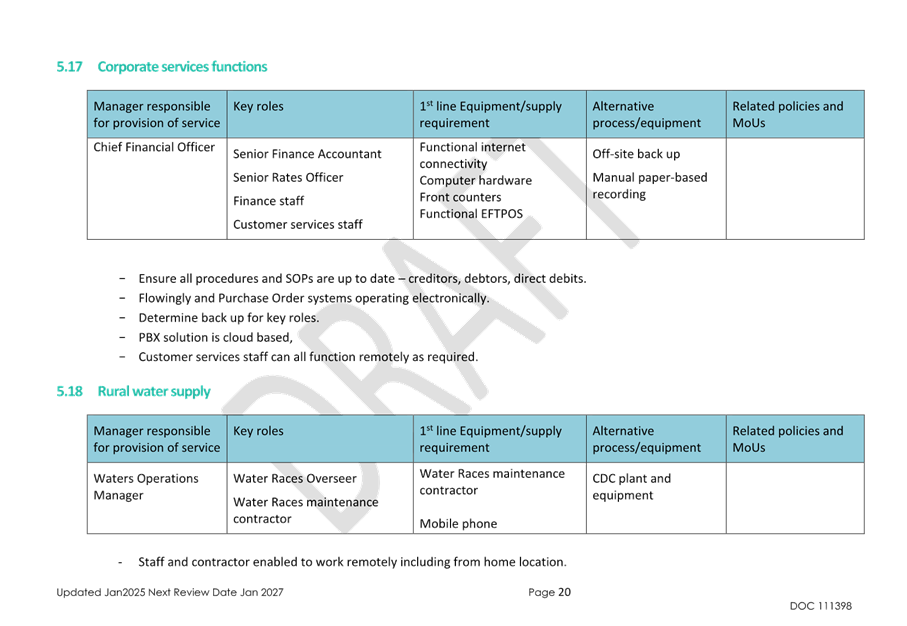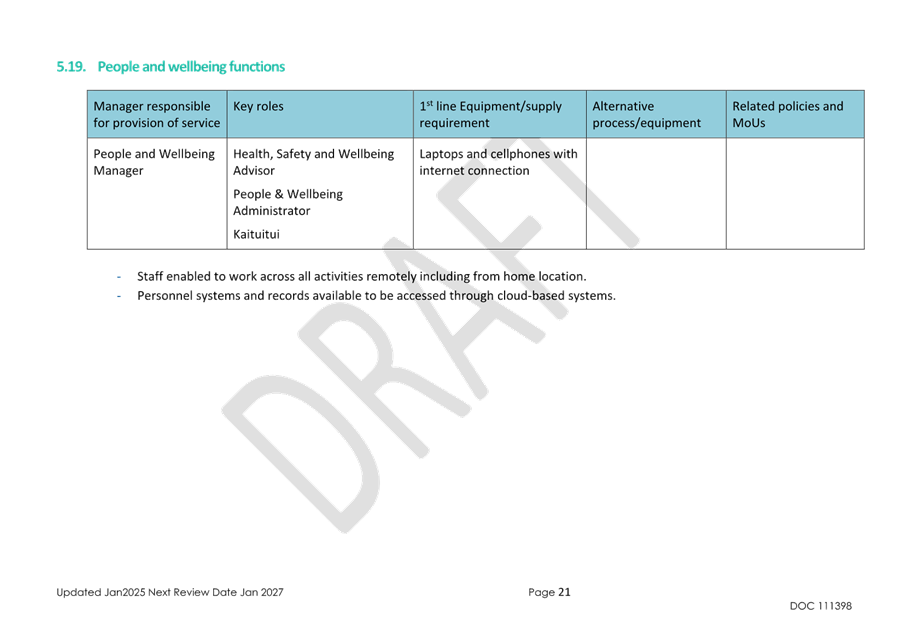|

|
|
AGENDA
Policy and Projects Committee meeting
|
|
Date:
|
Wednesday, 18 June 2025
|
|
Time:
|
9:00 am
|
|
Location:
|
Carterton Events Centre
50 Holloway St
Carterton
|
|
Deputy Mayor S
Cretney
Cr S Gallon
Mayor R Mark
Cr D Williams
Cr B Deller
|
Cr R Cherry-Campbell
Cr L Newman
Cr S Laurence
Cr G Ayling
|
|
Policy and Projects Committee meeting Agenda
|
18 June 2025
|
6 Confirmation
of the Minutes

6.1 Minutes
of the Policy and Projects Committee Meeting held on 9 April 2025
1. Recommendation
1. That
the Minutes of the Policy and Projects Committee Meeting held on 9 April 2025
are true and correct.
File
Number: 453113
Author: Katrina
King, Democratic Services Officer
Attachments: 1. Minutes
of the Policy and Projects Committee Meeting held on 9 April 2025
|
Policy
and Projects Committee meeting Minutes
|
9
April 2025
|

MINUTES OF Carterton District Council
Policy and Projects Committee meeting
HELD AT THE Carterton Events Centre, 50
Holloway St, Carterton
ON Wednesday, 9 April 2025 AT 9:00 am
PRESENT: Deputy Mayor Steve Cretney (Chair), Cr Steve Gallon (Deputy
Chair), Cr Brian Deller, Cr Robyn Cherry-Campbell, Cr Lou Newman, Cr Steve
Laurence, Cr Grace Ayling (via videoconference)
IN ATTENDANCE: Staff
Geoff Hamilton (Chief Executive), Karon Ashforth (Corporate
Services Manager), Solitaire Robertson (Planning and Regulatory Services
Manager), Geri Brooking (People and Wellbeing Manager), Johannes Ferreira
(Infrastructure Services Manager), Glenda Seville (Community Services and
Facilities Manager), Lawrence Stephenson (Water Services Manager), Sarvesh
Tiwari (Waste Management and Minimisation Officer), Jeet Kiran (Waters
Compliance and Monitoring Officer), Becks Clarke (Community Development
Team Leader), Marcus Anselm (Communications and Engagement Manager), Sara
Renall (Senior Communications and Engagement Advisor), Katrina King (Democratic
Services Officer), Ricky Utting (Climate Change Advisor), Anna Tulloch
(Communications and Engagement Advisor)
1 Karakia
Timatanga
The meeting opened with a karakia
by all members.
2 Apologies
MOVED
That
apologies be received from Cr Dale Williams and Mayor Ron Mark.
Cr L
Newman / Cr S Gallon
CARRIED
3 Conflicts
of Interests Declaration
There were no conflicts of
interest declared.
4 Public
Forum
There was no public forum.
5 Confirmation
of the Minutes
|
5.1 Minutes
of the Policy and Projects Committee Meeting held on 19 February 2025
|
|
MOVED
1. That
the Minutes of the Policy and Projects Committee Meeting held on 19 February
2025 are true and correct.
Cr
R Cherry-Campbell / Cr B Deller
CARRIED
|
6 Reports
|
6.1 Waste
Management and Minimisation Update
|
|
1. Purpose
For the Committee to be updated on Carterton
District’s Waste Management & Minimisation overview.
|
|
MOVED
That the Committee:
1. Receives
the report.
Cr
S Laurence / Cr S Gallon
CARRIED
|
|
6.3 Positive
Ageing Strategy update
|
|
1. Purpose
For the Policy and Projects Committee to receive the
six-monthly report on Te Hōkai Nuku Wairarapa Region Positive Ageing
Strategy for Carterton District Council.
|
|
MOVED
That the Committee:
1.
Receives the report.
Deputy
Mayor S Cretney / Cr R Cherry-Campbell
CARRIED
|
|
6.4 Māori
Responsiveness Action Plan Update
|
|
1. Purpose
For the Committee to receive an update on the Māori Responsiveness Action Plan
2024/2025.
|
|
MOVED
That the Committee:
1. Receives
the report.
2. Notes
the progress towards the delivery of the Māori Responsiveness Action
Plan objectives.
Cr
R Cherry-Campbell / Cr L Newman
CARRIED
|
|
6.5 Major
Projects Update
|
|
1. Purpose
To update the Committee on the progress of major
projects.
|
|
MOVED
That the Committee:
1. Receives
the report.
Deputy
Mayor S Cretney / Cr B Deller
CARRIED
|
|
6.6 Ruamāhanga
Roads and Corridor Access Report
|
|
1. Purpose
For the Committee to be updated on Ruamāhanga Roads
and Corridor Access activities.
|
|
MOVED
That the Committee:
1. Receives
the report.
Deputy
Mayor S Cretney / Cr R Cherry-Campbell
CARRIED
|
|
6.7 Water
Operations Report
|
|
1. Purpose
For the Committee to be updated on the water operations.
|
|
MOVED
That the Committee:
1. Receives
the report.
Cr
R Cherry-Campbell / Cr B Deller
CARRIED
|
|
6.8 Update
on Operational Consents
|
|
1. Purpose
To update the Committee on the status of the existing consents.
|
|
MOVED
That the Committee:
1. Receives
the report.
Deputy
Mayor S Cretney / Cr S Gallon
CARRIED
|
|
6.9 Carterton
District Council Speed Review
|
|
1. Purpose
For the Committee to consider advice on the next steps
following receipt of a response from NZTA regarding CDC’s Speed Review.
|
|
MOVED
That the Committee:
1. Receives
the report.
Deputy
Mayor S Cretney / Cr S Laurence
CARRIED
MOVED
2.
Notes the proposed next steps.
Cr R Cherry-Campbell / Cr S Laurence
CARRIED
|
|
6.10 Update
on Planning Resource Consents
|
|
1. Purpose
The purpose of this report is to update the Committee on
the resource consents issued since the previous update.
|
|
MOVED
That the Committee:
1. Receives
the report.
Cr
B Deller / Cr S Gallon
CARRIED
|
|
6.11 Advisory
Group Updates
|
|
1. Purpose
For the Committee to be updated on activities and
highlights from the Advisory Group meetings.
|
|
MOVED
That the Committee:
1. Receives
the draft meeting notes from the People and Places, and Rural Advisory
Groups.
Cr
R Cherry-Campbell / Cr S Laurence
CARRIED
|
7 Karakia
WhakamUtunga
The meeting closed with a karakia
by all members.
The meeting closed at 10.51 am
Minutes confirmed:
……………………………………
2025
Date: ...................................................
|
Policy and Projects Committee meeting Agenda
|
18 June 2025
|
7 Reports

7.1 Community
Grants and Funding Framework and Policy
1. Purpose
For the Committee to
adopt the Community Grants and Funding Framework and Policy.
2. Significance
The
matters for decision in this report are not considered to be of significance
under the Significance and Engagement Policy.
3. Background
Carterton
District Council administers and distributes several funding streams that
provide significant support to our community. These funds help achieve the
outcomes outlined in CDC’s Long-Term Plan.
As
the funding opportunities available are expanded, the need to better organise
funding information and ensure it aligns with our strategic direction and
priorities as a Council is recognised.
4. Discussion
A workshop with
elected members was held in November 2024, during which the proposal was made
to create a unified document: the Community Grants and Funding Framework and
Policy. Discussions also included making amendments to existing grants
policies to better align with the Council’s objectives.
This new document aims
to enhance the clarity of information and communication regarding the grants
that CDC manages and distributes. The consensus was to consolidate all relevant
details—policies, eligibility criteria, application information, and
grant purposes—into a single resource: the Community Grants and
Funding Framework and Policy.
A desktop review was
conducted to inform this project, examining how other councils communicate
their grants and funding programmes. Additionally, we reviewed the various
strategies, legislations, and plans that guide our work and shape the services
CDC delivers.
5. NEXT
STEPS
This
document will be on the CDC website alongside other relevant information ion
grant funding managed by Council.
It
will also be distributed to our community database and will be a useful
resource for the annual Funders Forum.
6. CONSIDERATIONS
6.1 Climate
change
Through Councils
administration of grants, we encourage applicants to have Climate Change
consideration, specifically aligning with the Carterton District Council
Climate Change Strategy. Council officers provide advice and support to help
ensure this alignment.
6.2 Tāngata whenua
There are no specific tāngata whenua considerations associated with this report.
6.3 Financial
impact
Matters in the report
are covered by existing budgets or by funds that the Council manages on behalf
of external parties.
6.4 Community
Engagement requirements
The Framework was
created with feedback from grant applicants in mind, aiming to provide clear
and concise information. The goal is to save applicants time, allowing them to
focus on their core activities instead of reading long documents.
6.5 Risks
There
are no risks associated with this report.
6.6 Wellbeings
All
funds managed by Council consider the wellbeings and there are a variety of
grants to suit the community and the services that are delivered.
7. Recommendation
That the Committee:
1. Receives
the report.
2. Adopts
the Community Grants and Funding Framework and Policy.
3. Notes
that minor editing and changes in formatting may occur prior to public release
of the document.
File
Number: 464228
Author: Becks
Clarke, Community Development Team Leader
Attachments: 1. Community
Grants and Funding Framework and Policy ⇩
|
Policy and Projects Committee meeting Agenda
|
18 June 2025
|























|
Policy and Projects Committee meeting Agenda
|
18 June 2025
|

7.2 Carterton
District Council Climate Change Implementation Plan 2025-2026
1. Purpose
For the committee to
endorse the 2025/26 climate change implementation plan.
2. Significance
The
matters for decision in this report are not considered to be of significance
under the Significance and Engagement Policy.
3. Background
The
Carterton District Council Climate Change Strategy 2025-2030 was adopted
in April 2025. The strategy outlines the vision, shifts, objectives and actions
for the council over five years. The strategy specifies that it will be
supported with annual implementation plans aligned with the Council’s
financial year, and will build on the feedback received through the engagement
process while developing the strategy.
This is the first of
the implementation plans and covers the 2025/26 financial year. It is
intended as a consolidation of the work already underway by Council as the
foundation to enable the Strategy’s three shifts to take place.
4. Discussion
As a small district
with limited resources, we must be pragmatic and innovative in addressing
barriers to climate action.
In
this first implementation plan we will focus on Shift One (Enhancing knowledge
and understanding) and Shift Two (Organisational direction and building a
culture of change), so that by the end of the financial year we will be well
progressed against the actions under Objective Three (As an
organisation, Council leads by example).
We
will do this by recognising and celebrating the climate change adaptation and
mitigation work undertaken across the Council, and informing and empowering
Council staff to integrate climate change considerations in their work.
We will also compile
our emissions inventory reports for 2022 and 2023, and analyse the findings
ahead of completing the 2024 emissions inventory report, and implementation
plan for 2026/27.
This
Implementation Plan is in narrative form, covering all the action areas in the
strategy in a way and that enables tracking and reporting against the strategy.
5. Options
Consideration
was given to how fast and ambitious the implementation should be. There
are many changes being considered to climate related legislation (e.g. Waste
Minimisation, Resource Management), a proposed new Wairarapa Combined District
Plan, Local Water Done Well, and Council elections in the 2025/26 financial
year. These combined suggest a measured approach is taken while still
progressing the strategy.
6. NEXT
STEPS
In
the next quarter we intend to:
· Publish the CDC Climate Change Strategy-on-a-page and implementation
plan
· Work with CDC managers to support positive climate change in their
areas
· Begin work on the 2022 and 2023 emission inventory reports and
summary analysis
· Continue climate related community engagement and events
7. CONSIDERATIONS
7.1 Climate change
The
work outlined in the implementation plan should lead to:
· Reduced greenhouse gas emissions by the Council
· An increasingly informed, resilient and adaptive Council staff
· A better informed community
7.2 Tāngata whenua
The
activities in the implementation plan will indirectly be of interest to local
Māori.
7.3 Financial impact
The activities
in the implementation plan are covered within existing budgets.
7.4 Community Engagement
requirements
The
community was engaged in the development of the Climate Change Strategy.
7.5 Risks
There
are no additional risks identified in relation to this implementation plan.
7.6 Wellbeings
Social
The
plan could positively influence social wellbeing, through staff and the community
being involved in climate action for their own and wider benefits.
Cultural
The
plan should bring about a change in the relationship between climate change and
the role our people play in their work, and also positively influence the
community culture.
Environmental
The
plan should make a positive change to environmental well-being through actions
that value the natural environment.
Economic
Economic
well-being benefits will be indirect and longer term (e.g. reduced energy usage
and costs)
8. Recommendation
That the Committee:
1. Adopts
the Climate Change Strategy 2025/26 Implementation Plan.
File
Number: 453297
Author: Ricky
Utting, Climate Change Coordinator
Attachments: 1. Climate
Change Implementation Plan 2025_26 ⇩
|
Policy and Projects Committee meeting Agenda
|
18 June 2025
|











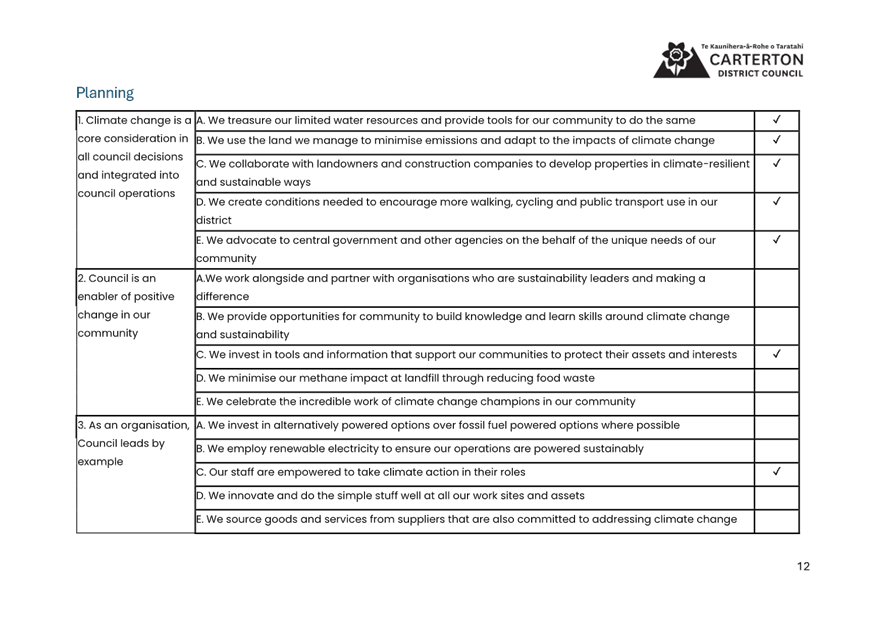
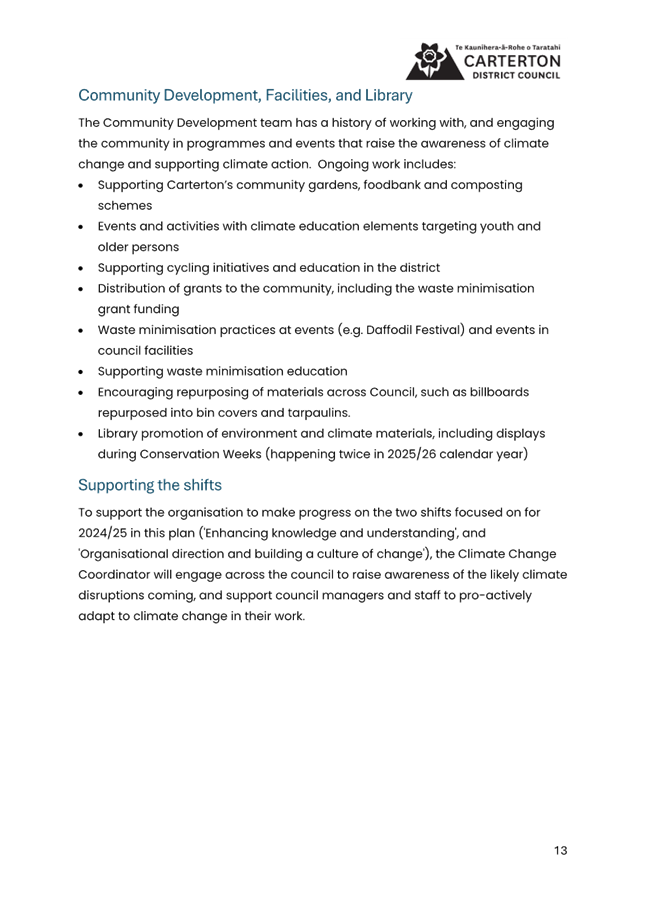


|
Policy
and Projects Committee meeting Agenda
|
18
June 2025
|

7.3 Update
on Operational Consents
1. Purpose
To update the
Committee on the status of the existing consents.
2. Significance
The
matters for decision in this report are not considered to be of significance
under the Significance and Engagement Policy.
3. Discussion
A resource consent is
permission from the Regional Council for an activity that might affect the
environment or the community, and that isn’t allowed ‘as of
right’ in the regional plan. Councils are required to
have resource consents to regulate activities that could potentially impact the
environment and the surrounding community.
4. Consents
The
main consents currently being worked on are the Water Race consent renewals and
the Kaipaitangata water take consent. A new landfill consent is also required
for GWRC to process. To achieve this, the advice from GWRC is that a new
Assessment of Environmental Effects (AEE) needs to be undertaken.
The waters team
manages 8 different consents, summarised in the table below:
|
Policy
and Projects Committee meeting Agenda
|
18
June 2025
|
|
Consent
|
Expiry
|
Status
|
Risks
|
|
Kaipaitangata Surface Water Take
|
2013
|
Updated AEE discussed with GWRC and stakeholders.
Ongoing discussion. The submission is planned for this year.
Staff started to engage with various stakeholders. The 2012
application is on hold. We are reapplying with updated information for the
Natural Resources Plan.
Te Tini o Ngāti Kahukuraawhitia engagement is in progress and
awaiting response.
|
Low flow restrictions
We are requesting a 20-year consent; however are
still awaiting a decision on this.
|
|
Carterton Landfill
|
2016
|
The 2014 application is on hold.
Staff contacted GWRC to discuss the pond desludging requirements
over the next 3 years.
Communication with GWRC has indicated that an updated AEE is
required.
|
Restrictions on sludge disposal.
Unknown risk for unlined cells and what may be required for
monitoring.
Potentially, a new AEE is required, as the last AEE was undertaken in 2015.
The reasons for the new AEE are:
- Regulatory and Policy Framework Updates since 2015.
- Changes in Environmental Conditions and Risks
- Best Practice and Technical Advancements.
- Actual and potential effects are difficult to
ascertain, given the lack of information supplied and the inconsistencies
within the 2015 AEE document.
Officers have engaged a consultant; however, their availability to
begin work on the AEE is expected to be at least two months away. The
preferred approach is not to develop an entirely new AEE from scratch, but
to review and update the existing AEE against the now-operational NRP. If
feasible, this approach may satisfy GWRC’s requirement for a new AEE
while avoiding unnecessary duplication of work.
|
|
Consent
|
Expiry
|
Status
|
Risks
|
|
Taratahi
Water Race
|
30
June 2023
|
The
2023 application with updated questions has been returned to GWRC officers.
Meetings
are planned with GWRC to discuss the further information they have
requested.
Currently in the process of
addressing the outstanding information and assessment
deficiencies. Discussion with experts is ongoing. A Principal Ecologist
(Consultant) has been engaged to conduct ecological surveys of the water races
for the purpose of consent renewal.
Due to the fact that the
budget were set in the previous LTP and increased cost for providing
information, officers will have to request an increase in project budget at
the next council meeting.
|
Restrictions
during low flow and the amount of monitoring required.
We
are requesting a 20-year consent and are still awaiting a decision on this.
The
costs for consenting.
|
|
Carrington
Water Race
|
30/6/2023
|
See
above
|
|
|
Frederick
St groundwater take
|
30/9/2034
|
Current
|
Nitrate
levels are still within limits. However, a change in legislation could
compromise this.
|
|
Waingawa
swamp cleaning
|
3/9/2023
|
Expired;
included in the Water Race consent application
|
|
|
Wastewater
discharge
|
17/1/2053
|
Current;
multiple consents
|
· Capacity for population growth
|
|
Stormwater
|
15/8/2027
|
Current;
Monitoring consent to create stormwater management strategy
|
Roading
run-off treatment
|
|
Policy
and Projects Committee meeting Agenda
|
18
June 2025
|
5. REnewal
Progress
There are currently four
consents progressing that are in different stages:
· The
water race consents (which are consented separately but being processed
concurrently) remain on hold under Section 92. The 2023 application, which
includes updated questions, has been returned to GWRC officers, and meetings
are planned with GWRC to discuss the further information they have requested.
GWRC officers have indicated that the effects of the takes from streams and
groundwater are likely to be more than minor, and the AEE submitted contains
deficiencies and is considered insufficient. The process of addressing the
outstanding information and assessment deficiencies is underway, with ongoing
discussions involving technical experts. A Principal Ecologist (Consultant) has
been engaged to conduct ecological surveys of the water races to support the
consent renewal process. The survey is yet to be executed once the desired
weather conditions and flow rate are achieved.
· The
updated application for the Kaipatangata has been on hold since 2015 while
different strategies were considered by the Council on the use of the Frederick
St Water Treatment Plant and the Kaipatangata supply. Council staff have
drafted a replacement AEE that is evaluated against the objectives, policies,
and rules of the Natural Resources Plan. Preliminary discussions with the
Regional Council were encouraging, however the last email correspondence
indicated the GWRC policy team had advised that because the Mangatarere is
over-allocated, that only a 5-year consent is possible. Te Tini o Ngāti Kahukuraawhitia engagement is in
progress and awaiting response.
· The landfill consent for the closed landfill relates to monitoring
of the groundwater around the site. GWRC has advised that a new AEE is needed
for the renewal of the landfill consent. Officers
have engaged a consultant; however, their availability to begin work on the AEE
is expected to be at least two months away.
· Treated wastewater discharge to the Mangatārere
Stream has commenced following the achievement of the required flow rate, which
resulted from recent heavy rainfall. Land irrigation has been suspended due to
saturated ground conditions. An appropriately qualified and experienced
ecologist has been engaged to undertake macroinvertebrate sampling and assess
compliance with the receiving water quality standards outlined in the consent.
The most recent ecological compliance monitoring survey was conducted on 24
April 2025, and the results confirm compliance with Conditions 11–15 of
consent WAR160341, which relates to the discharge of treated wastewater from the
Carterton Wastewater Treatment Plant to land adjacent to the Mangatārere
Stream. The survey findings demonstrate that the Carterton District Council
Wastewater Treatment Plant is meeting its in-stream ecological consent
conditions.
6. CONSIDERATIONS
6.1 Climate
change
N/A.
6.2 Tāngata whenua
One important stakeholder is mana whenua. Council officers are engaging
with Ngāti Kahukuraāwhitia to arrange a cultural impact assessment
for the diversion of water from the Kaipatangata stream for the town supply.
6.3 Financial
impact
All work relating to the renewal and maintenance of the consents is
provided for within approved budgets in the LTP and carry forwards.
7. Recommendation
That the Committee:
1. Receives
the report.
File
Number: 453035
Author: Jeet
Kiran, Waters Compliance and Monitoring Officer
Attachments: Nil
|
Policy
and Projects Committee meeting Agenda
|
18
June 2025
|

7.4 Waste
Management and Minimisation Update
1. Purpose
For the Committee to
be updated on Carterton District’s Waste Management and Minimisation
services.
2. Significance
The
matters for decision in this report are not considered to be of significance
under the Significance and Engagement Policy.
3. Background
CDC
delivers solid waste management and minimisation services and activities in
alignment with the Wellington Region Waste Management and Minimisation Plan
(WMMP), and the Wairarapa Local Action Plan.
The
WMMP outlines how Wellington Councils, mana whenua, community, industry, and
businesses can work together to transform how waste is generated, managed, and
minimised in the Region. Reflecting this collaboration is the vision for
this WMMP, which is “E mahi tahi ana ki te tiākinahia a
mātou rauemi – hei whakaiti para, ā, ki te whakanui ai te
wāhi - Working together to care for our resources - for less waste and a
greater place”.
The
objectives of the WMMP are:
1. Waste and resource recovery systems
support a reduction in greenhouse gas emissions from landfills and waste
collections.
2. There is collective responsibility
within the Wellington region for reducing our resource use and protecting our
natural environment.
3. The conditions are in place to support
everyone to use fewer resources and minimise waste.
4. Material circularity is increased
through reuse, resource recovery, waste infrastructure and services.
5. It is accessible and convenient to
reduce waste, reuse materials, and minimise disposal to landfill in line with
the waste hierarchy.
6. Waste and resource recovery data systems
are in place to track and monitor waste streams.
7. Resource recovery facilities and waste
systems are resilient and able to cope with emergency events.
8. Recovery of materials is maximised so
that landfills are used as a last resort.
9. Waste that cannot be prevented or
diverted from landfill is managed safely and effectively in accordance with
best practice.
4. Discussion
|
Month
|
Recycling
(kerbside and Transfer station)
|
Landfill
|
Glass
Recycling
|
E-waste/batteries
/other
|
Metal
recycling
|
Levy
(Exc. GST)
|
|
Apr ‘25
|
18,600 kg
|
12,765 kg
|
24,500 kg
|
1,920 kg
|
8,980 kg
|
$ 2,160.87
|
|
May ‘25
|
17,190 kg
|
13,280 kg
|
24,130 kg
|
1,400 kg
|
8,860 kg
|
$ 2,341.50
|
|

Project Update
|
|
|
· Awaiting CE and GM
review for Tyrewise Scheme officers' report for initiating the scheme at the
Carterton transfer station.
· Tonkin &
Taylor are expected to provide the first draft of the organics kerbside feasibility
report by the end of June 2025.
· New OfficeMax
rubbish bags are expected to go out in the market in July 2025.
· Packaging Forum
has been asked to interact directly with New World Carterton for a
cost-effective soft plastics scheme installation.
· Fulton Hogan has
finished chip sealing of the transfer station side pathways.
· A reminder that
from 1 July 2025, the waste disposal levy on the net tonnage of waste disposed
facility is increasing as follows:
o Class 1 Municipal disposal
facilities - $60 per tonne to $65 per tonne
o Class 2 Construction and
demolition disposal facilities - $30 per tonne to $35 per tonne
o Class 3 and 4 Managed or
Controlled disposal facilities - $10 per tonne to $15 per tonne
The Government’s waste and resource efficiency strategy
Under the current system,
50% of the total waste levy is returned to councils and distributed based on
population. However, the proposed legislation would change this distribution
model:
· 20% of the
returned levy would be split equally among all councils, and the
remaining 80% would continue to be distributed according to population.
If these changes are implemented, smaller councils like CDC & SWDC would
receive approximately $100,000 more per year.
Conversely, WCC would see
a reduction of around $500,000 annually due to the shift in allocation.
|
Service
Requests
|
Request
Details
|
Output
|
Date
|
|
25000596
|
54B Costley St: Yellow bin for newly
built
|
Bin delivered by Smart Env
|
02/04/2025
|
|
25000600
|
30 Richmond Rd: Yellow bin for newly
built
|
Bin delivered by Smart Env
|
03/04/2025
|
|
25000614
|
200
High St N: Damaged Bin
|
Bin
repaired by Smart Env
|
07/04/2025
|
|
25000663
|
9
Cliffton Ave: Missed kerbside collection
|
Unjustified
kerbside week
|
15/04/2025
|
|
25000680
|
65
Lincoln Rd: Yellow bin for newly built
|
Bin
delivered by Smart Env
|
17/04/2025
|
|
25000689
|
282
High St S: Damaged bin
|
Bin
repaired by Smart Env
|
22/04/2025
|
|
25000772
|
55
Lincoln Rd: Yellow bin not emptied
|
Unjustified
kerbside week
|
06/05/2025
|
|
25000885
|
PO Box 49:
Missed Rubbish bag collection
|
Collections
last till 7:00PM, collected later in the day
|
19/05/2025
|
|
25000901
|
15
Kakariki Cr: Yellow bin for new built
|
Bin
delivered by Smart Env
|
20/05/2025
|
|
25000919
|
16
Madison St: Yellow bin for new built
|
Bin delivered
by Smart Env
|
23/05/2025
|
|
25000936
|
3/7
Kent St: Yellow bin damaged
|
Bin
repaired by Smart Env
|
26/05/2025
|
|
25000938
|
47
Brooklyn Rd: Yellow bin damaged
|
Bin
repaired by Smart Env
|
26/05/2025
|
|
|
|
|
|
5. Next
Steps
The following
actions are still to be undertaken:
· Tracking waste and
data collection from Smart Environmental as per the new rules from the Online
Waste Levy System (OWLS).
· Soft plastics
trial at New World Carterton.
· Waste-ED with
Kate: 2025 Social Media Video Campaign for Carterton.
· Working with the
Communications Team for recycling week in September/October 2025.
· Monitoring and
reducing illegal litter dumping.
Carterton
Waste Transfer Station Chip Sealing Process:

Before Chipseal


After Chipseal
6. Recommendation
That the Committee:
1. Receives
the report.
File
Number: 461255
Author: Sarvesh
Tiwari, Waste Management and Minimisation Officer
Attachments: Nil
|
Policy
and Projects Committee meeting Agenda
|
18
June 2025
|

7.5 Water
Operations Report
1. Purpose
For the Committee to
be updated on the water operations.
2. Significance
The matters for
decision in this report are not considered to be of significance under the
Significance and Engagement Policy.
3. Service
Requests
Please
see a summary of the service request activity for the period below. The number
of water services for leaks has stabilised after the peak in summer.
There
have been a number of leaks recently occurring on the state highway in the live
lane. These are significantly more expensive to repair, due to the requirement
by Waka Kotahi for night works and that the whole width of the carriage way is
reinstated. The water team is also stood-down the next day to manage fatigue.


4. Wastewater
4.1 Operations reticulation team
The wastewater network
has been operating well. The recent wetter weather with winter has increased
the flows into the treatment plant increasing the average daily flow to
3,000m³/d over the last month, compared to an annual daily volume of
2,150m³/d.


A design has been
prepared for the upgrade at Fisher Place wastewater pump station. The upgrade
will install a standby pump within the wet well and improve access to the
valves for maintenance.
4.2 WWTP
The
wastewater treatment plant has been operating well. As mentioned above, the
daily flows have increased but the water has been easily stored in the
reservoirs to ensure supply to the irrigation areas.
The
grass re-sown in spring has improved the bailage harvested from the field,
increasing weights to 71 Tonnes, compared to 34 Tonnes last year.
5. water
5.1 Operations Reticulation Team
The team has been busy
with the number of leaks occurring, though they have been able to efficiently
manage the demand. The exception is leaks on the state highway. The water leaks
on the SH2 take much longer to repair because of the traffic management and
reinstatement requirements. The frequent requirement that the work is
undertaken overnight means the team to unavailable the next day to manage
fatigue.
5.2 Operational – Water
Treatment Plant
Water
demand has been below average, helped by the rainfall after Christmas, and
water demand has been steadily increasing with the dry February - March. The
graph below charts the monthly water demand and the split between the water
treatment plants. We have been on water restrictions of alternate days for
sprinklers since 10 December 2024, and the current setting is a sprinkler ban,
which is reflective of the low river levels at the moment. It is important to
note that the water restrictions are a resource consent requirement, though it
helps us manage the water demand in the town.
Graph
of monthly water demand (12 months)
Both the Kaipaitatanga
Water Treatment Plant (WTP) and the Frederick St WTP have been running
regularly. The Kaipaitangata is preferred because the gravity supply can cope
with high fire-fighting flows in an emergency.
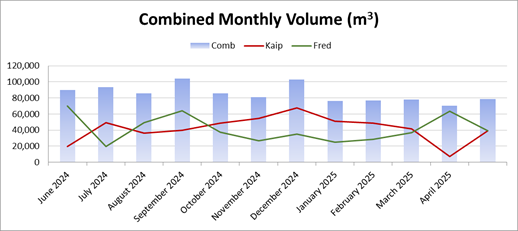
6. water
RACES
6.1 Operational Update
The
water races have been at low flow conditions regularly since the start of the
year, but with the higher rainfall at the end of autumn. The overseer and
contractor worked hard to maintain flow to the end of the network and there is
a section in Kokotau Rd that needs to be piped to stabilise the water race
wall.


7. CONSIDERATIONS
7.1 Climate change
There are no direct climate change
issues relating to the decisions in this paper.
7.2 Tāngata whenua
There
are no issues in this paper that impact on tāngata whenua.
7.3 Financial impact
The
system is operating within budget and the decisions in this report have no
financial impacts.
7.4 Community Engagement
Requirements
There
are no community engagement requirements relating to the decisions in this
paper.
7.5 Risks
There
are no risks associated with the decisions in this paper.
7.6 Wellbeings
Economic
Wellbeing
· Quality,
fit-for-purpose infrastructure, and services that are cost-effective and meet
future needs
Cultural
Wellbeing
· Te Āo
Māori/Māori aspirations and partnerships are valued and supported.
Social
Wellbeing
· A strong and
effective council providing trusted leadership
· A caring community
that is safe, healthy, happy and connected.
Environmental Wellbeing
· Safe and resilient
water supply, wastewater, and stormwater systems
· Healthy,
sustainable waterways.
8. Recommendation
That the Committee:
1. Receives
the report.
File
Number: 461181
Author: Lawrence
Stephenson, Waters Operations Manager
Attachments: Nil
|
Policy
and Projects Committee meeting Agenda
|
18
June 2025
|

7.6 Waste
Water Treatment Plant Sludge Removal Project Scope Update
1. Purpose
For the Committee to
be updated on the project scope development of the Wastewater Treatment Plant
(WWTP) Sludge removal project.
2. Significance
The
matters for decision in this report are not considered to be of significance
under the Significance and Engagement Policy.
3. Background
Officers have been
developing the scope of the WWTP Sludge removal project to align with the
Long-Term Plan and Infrastructure Strategy:
“Council's
most significant project is the renewal of critical and ageing infrastructure
at the Dalefield Wastewater Treatment Plant’s intake area and the removal
of biosolids (sludge) from the oxidation ponds to improve the quality and efficiency
of the treatment output.” - CDC Long Term Plan 2024-2035
“A
sustainable solution for biosolids management needs to be developed within the
next ten years, which is championed district-wide, environmentally sound,
economically viable, and socially accepted. This will be a medium to Long-Term
focus for Carterton District Council in partnership with various internal and
external stakeholders.”- CDC Infrastructure Strategy 2024 – 2054
4. Discussion
The primary challenge
councils face with sludge removal from wastewater treatment plants is the final
disposal of the sludge, which is commonly dried and then sent to a landfill, or
stored on site.
Officers have worked
with professional service advisors from Vitruvius to gain a better
understanding of the available options and service providers. Additionally,
they have collaborated with a local business, Composting NZ, to develop a
solution for the de-sludging, treatment, and disposal of the final
product.
At a high level,
the proposed solution includes the following steps:
a. De-watering
of sludge
b. Removing
sludge from the oxidation pond.
c. Composting
biosolids
d. Compliance
testing
e. Disposal
of compliant compost.
Due to the
commercial sensitivity of the solution and the fact that the supplier has not
been formally engaged for its delivery, we cannot disclose further details
about the process.
The proposed
solution could deliver the following benefits and possible future
opportunities:
i. Improvement
of health of pond by reducing the sludge content.
ii. Treatment
of sludge through composting.
iii. AA
Grade compost can be applied to agricultural land as fertiliser.
iv. Potential
revenue from the sale of compost to offset treatment cost.
v. Because
of the Council's earlier strategic decisions to acquire Daleton and Matarawa
Farm, there is now a new opportunity to accept sludge from other councils in
the future, provided the concept is validated. If successful, this initiative
could offer the Council an additional source of revenue.
One of the challenges
of the project is that the approved project budget will not be sufficient to
apply the solution to 100% of the sludge in the pond. Due to the cost of
Bio-solid treatment (Composting and Compliance testing), it is estimated that
only between 30% and 50 % of the sludge from pond 3 will be dealt with. Note
that we are using high level cost estimates with many unknown factors.
5. Options
Option 1 – Trial the full process cycle (preferred):
This
is the conservative option where the entire batch of sludge extracted will be
composted and tested to validate the quality of compost and prove the concept.
If
successful, an AA Grade compost can be achieved, and the council will be able
to dispose of the compost.
The
current approved budget will limit the batch size. Officers estimate that
roughly 800 – 1000 tons of sludge will be extracted.
Extracting
30 – 50% of the sludge from the pond will significantly improve the
health and effectiveness of the pond.
The
trial will provide the Council with valuable information on the future cost of
desludging as well as a potential business case to accept sludge from other
councils.
Option 2 – De-sludge only:
It is
possible to extract most of the ~2000 tons of sludge from the pond and stockpile on site. This option
will result in even greater improvement of the pond; however, this benefit is
challenging to quantify without significant modelling and testing.
Having
a 1000 (dried) -2000 ton stockpile on site without a detailed plan of how to
dispose is considered to be high risk and not ideal.
Option 3 – Full de-sludge and apply the full process cycle
Option
3 is a combination of options 1 and 2, however will require an increase in the
project budget, noting that the amount of increase required is unknown without
conducting the trial first. There is also a risk that the generated compost
does not meet the AA Grade compost, resulting in further disposal costs.
6. NEXT
STEPS
Council’s
preferred option is progressing with Option 1 – A trial of the full
process cycle. For this option, officers would engage Composting NZ as the
subject matter expert and service provider.
7. CONSIDERATIONS
7.1 Climate change
De-sludging the ponds
will improve the treatment process within the ponds, taking the balance more
towards an aerobic treatment process, which produces fewer greenhouse gases.
7.2 Tāngata whenua
While the current
treatment process is effective and produces compliant effluent, de-sludging
will further enhance the quality of the treated effluent. Higher quality
effluent will lead to less environmental impact, which could be of interest to
Māori.
7.3 Financial impact
The recommended Option
1 will be delivered within the approved budget, ensuring there is no unplanned
financial impact. However, due to the delayed start of the process, the project
will have an underspend. At the end of the financial year, officers will
request to carry forward the approved budget.
7.4 Community Engagement
requirements
The
matters for decision in this report are not considered to be of significance
under the Significance and Engagement Policy.
7.5 Risks
The
desludging process has multiple risks that will be managed throughout the life
of the project. The main risks are:
a. Odour – The extraction of sludge
could produce odours. This risk will be managed by adding stabilisers as and
when required.
b. Compost could fail to meet AA Grade quality. This risk will be managed through blending with stable materials.
c. Damage of pond clay liner. This risk
will be managed through on-site supervision and project management.
7.6 Wellbeings
Social
- A strong and
effective council providing trusted leadership.
Cultural
- Māori aspirations and partnerships are
valued and supported
Environmental
- An
environmentally responsible community committed to reducing our carbon
footprint and adapting to climate change.
Economic
- Quality
fit-for-purpose infrastructure and services that are cost-effective and meet
future needs.
8. Recommendation
That the Committee:
1. Receives
the report.
2. Endorses
Officers preferred option, namely proceeding with Option 1 – Trial of
the full process cycle.
File
Number: 461239
Author: Johannes
Ferreira, Infrastructure Services Manager
Attachments: Nil
|
Policy
and Projects Committee meeting Agenda
|
18
June 2025
|

7.7 Major
Projects Update
1. Purpose
To update the
Committee on the progress of major projects.
2. Significance
The
matters for decision in this report are not considered to be of significance
under the Significance and Engagement Policy.
3. Background
The
Infrastructure Services Team delivers multiple projects as part of the delivery
of the Long-Term Plan.
LTP
Master Programme
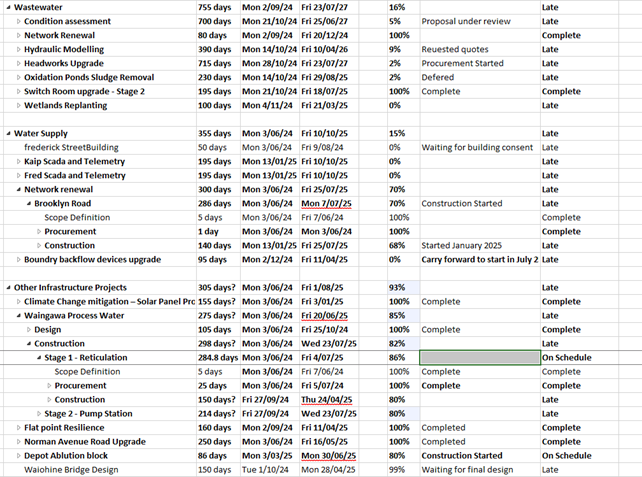
4. Discussion
4.1 Sewer
Network Renewals Lincoln Road
4.1.1
Progress:
CCTV
footage indicates some stone debris in the pipe. The pipe has been
cleaned and another check will be undertaken to ensure all debris has been
removed.
4.1.2
Finance
Final
costs were $2,376,386 ($102K below estimate of $2,478,474).
4.2 Waingawa
Process Water
4.3.1
Finance
Total
Budget $2,767,679
Cost to
Date $1,835,105
4.3.2
Program

4.3.3 Stage 2 - Reticulation
The Norman Avenue pipe extension has commenced.
4.3.4 Stage 3 - Pump
Station and Reservoir
Ordish & Stevens have started
the pump construction and it is 80% complete.
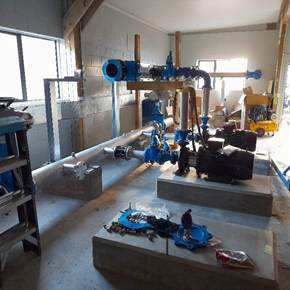
Image 1 – Pump Station (1)
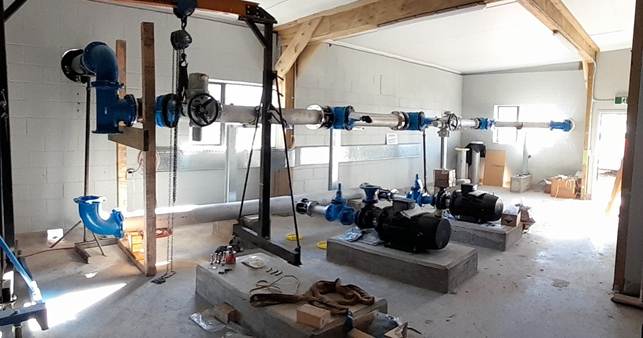
Image 2 –
Pump Station (2)
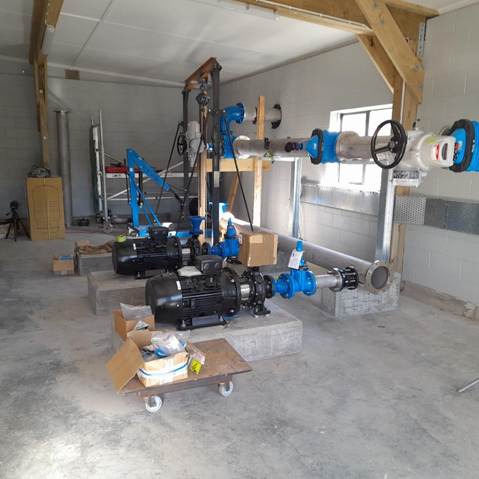
Image
3 – Pump Station (3)
4.3 Flatpoint
Flood Mitigation
4.4.1 Finances
Budget
$410,000
Cost
to date $317,952
4.4.32 Progress update
All
work has been completed

Image 4 - Stage 2 Complete
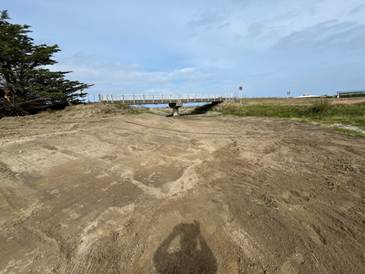
Image 5 - Stage 4 Complete
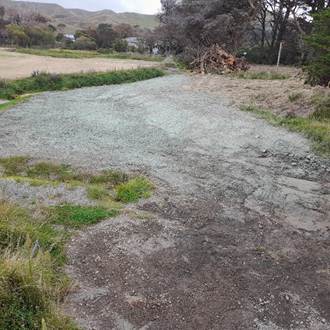
Image
6 - Stage 4 Complete with Hydroseed

Image 7 - Bund before topsoiling
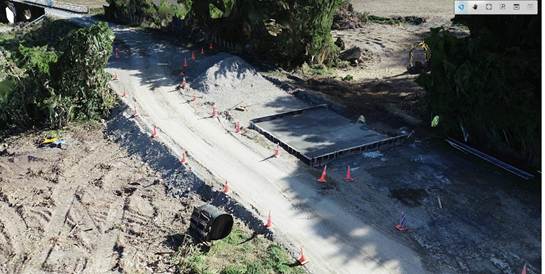
Image 8 - Ford under construction
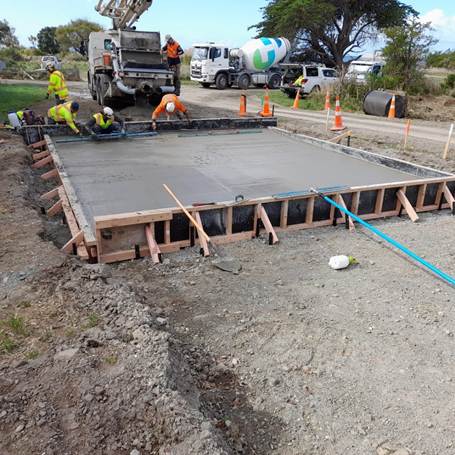
Image 9 - Ford under construction
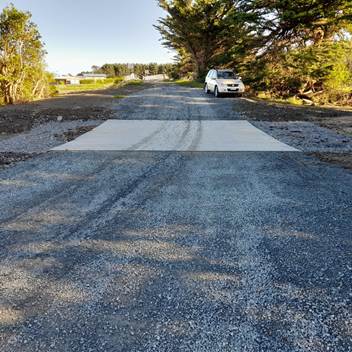
Image 10 - Ford complete
4.4 Brooklyn
Road Watermain Replacement
Progress
The main pipework and rider main
have been completed from High Street South to Lincoln Road.
Outstanding items:
Lincoln Road crossing and house laterals
Cost to date $1,578,268.11
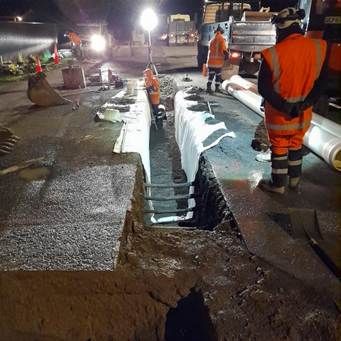
Image
11 - Brooklyn Road Water Main Replacement - High Street South Crossing
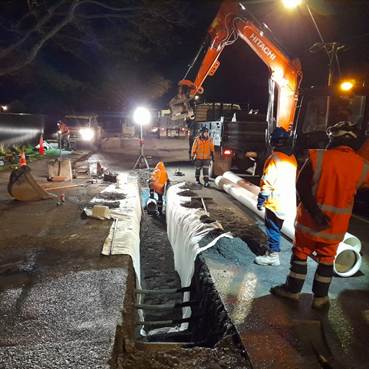
Image
12 - Brooklyn Water Main Replacement - High Street South Crossing
4.7
Waiohine Bridge Design
The
final design is expected to be completed 13 June 2025.
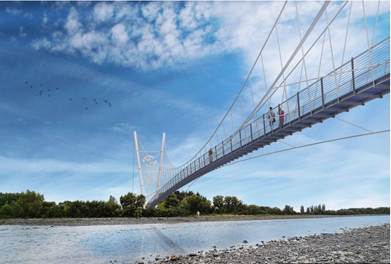
Image
13 - Waiohine Bridge Concept Design
4.8
Depot Ablution Block
A new relocatable
ablution block has been installed and is currently awaiting to be connected to
the power supply.
4.9
Frederick Street Treatment Plant Building Upgrade
The successful tenderer was Riggs-Zschokke for the
tender price of $203,641.68.
We are still waiting for Building consent and as
soon as this is granted construction will start.
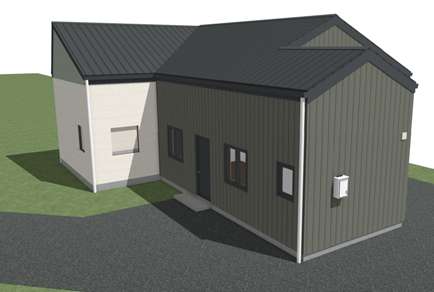
Image 14 - Frederick Street Concept
5. CONSIDERATIONS
5.1 Climate
change
This
report is a regular update which is of interest to all members of our
community, including iwi and hapū.
5.2 Tāngata whenua
This
report is a regular update which is of interest to all members of our
community, including iwi and hapū. However, there are no areas of interest
or concern contained within this report that require specific iwi or hapū
consideration.
5.3 Financial
impact
The financial matters in the report are
covered within existing budgets.
5.4 Community
Engagement requirements
There
are no community engagement requirements required for this report.
5.5 Risks
Project risks are
being managed and mitigated as and when required.
6. Recommendation
That the Committee:
1. Receives
the report.
File
Number: 463998
Author: Christo
Heyns, Project Manager
Attachments: Nil
|
Policy
and Projects Committee meeting Agenda
|
18
June 2025
|

7.8 Ruamāhanga
Roads and Corridor Access Report
1. Purpose
For the Committee to
be updated on Ruamāhanga Roads and Corridor Access activities.
2. Significance
The
matters for decision in this report are not considered significant under the
Significance and Engagement Policy.
3. Background
Ruamāhanga Roads is a shared service
between CDC and SWDC to deliver the Land Transport Programme in partnership
with the New Zealand Transport Agency Waka Kotahi (NZTA).
4. discussion
The
attached report relates to activities undertaken across the Carterton and South
Wairarapa Districts for March-April 2025.
5. CONSIDERATIONS
5.1 Climate change
Roading
activities have an impact on climate change however through the road
maintenance contract, efficiencies are strived for which relate to climate
change mitigation. This report does not have any climate change decision
implications.
5.2 Tāngata whenua
This
report is a regular update which is of interest to all members of our
community, including iwi and hapū. However, there are no particular areas
of interest or concern contained within this report that require specific iwi
or hapū input.
5.3 Financial
impact
All of
the roading activities are completed under approved budgets, and this report
does not have any additional financial impacts.
5.4 Community
Engagement requirements
There
are no additional community engagement requirements resulting from this report.
5.5 Risks
This
report is a regular update. It contains no specific or identified
decision risks which would require further attention or action.
6. Recommendation
That the Committee:
1. Receives
the report.
File
Number: 464248
Author: Graham
Carson, Roading Manager
Attachments: 1. Ruamahanga
Road Report June 2025 ⇩
|
Policy
and Projects Committee meeting Agenda
|
18
June 2025
|
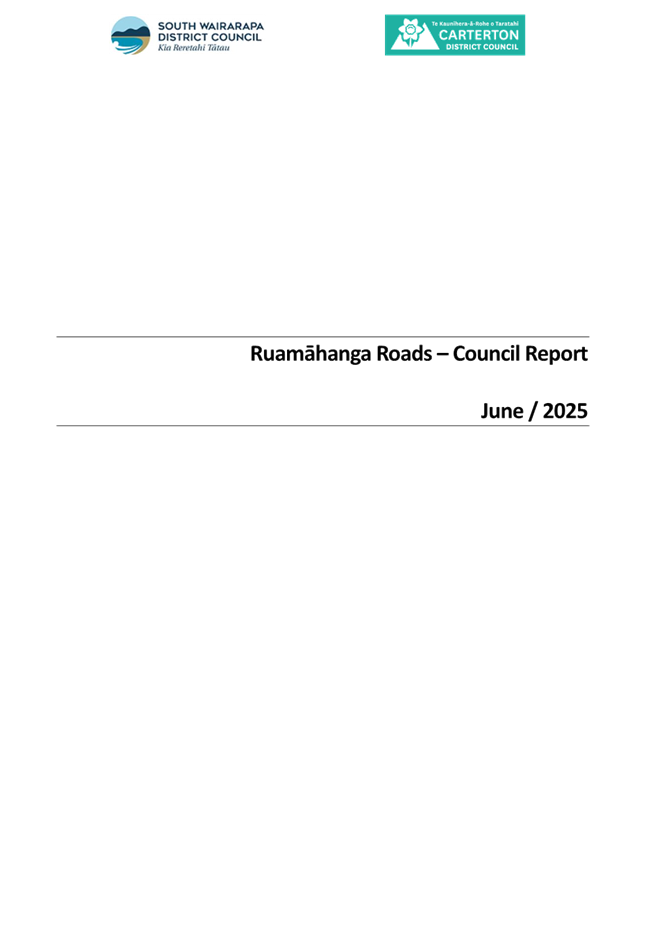
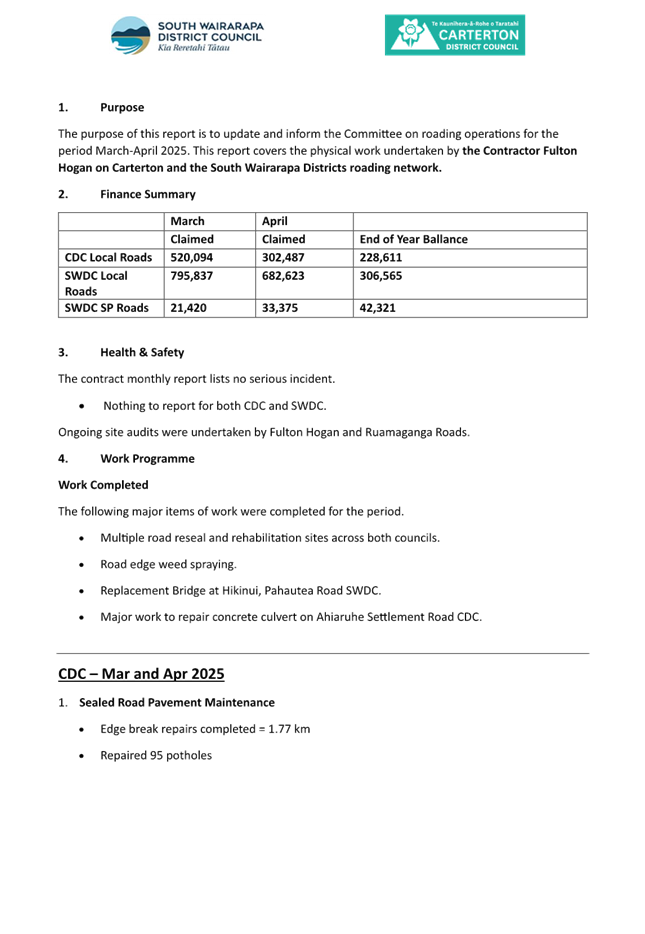
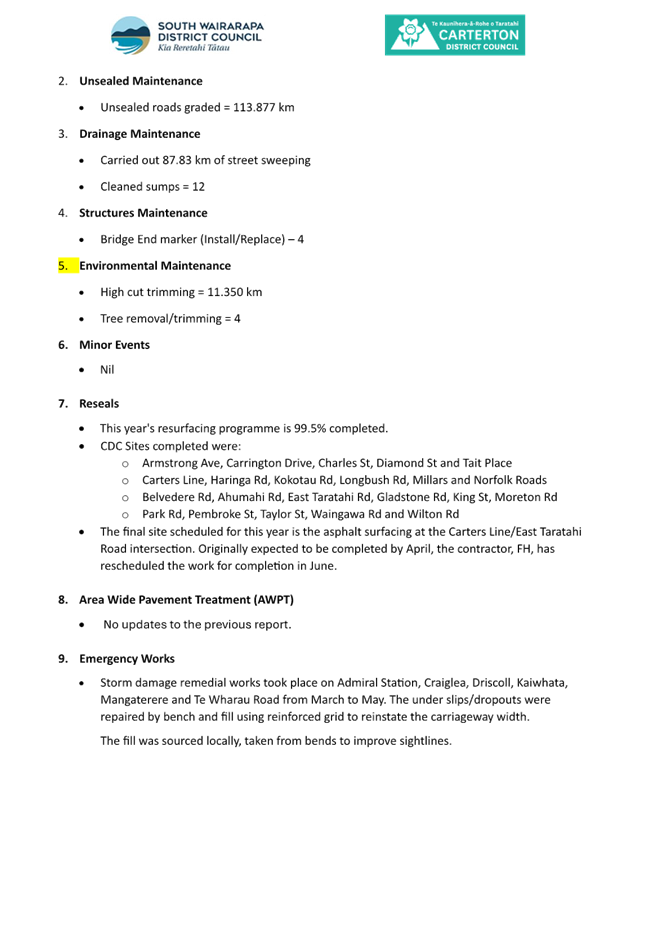
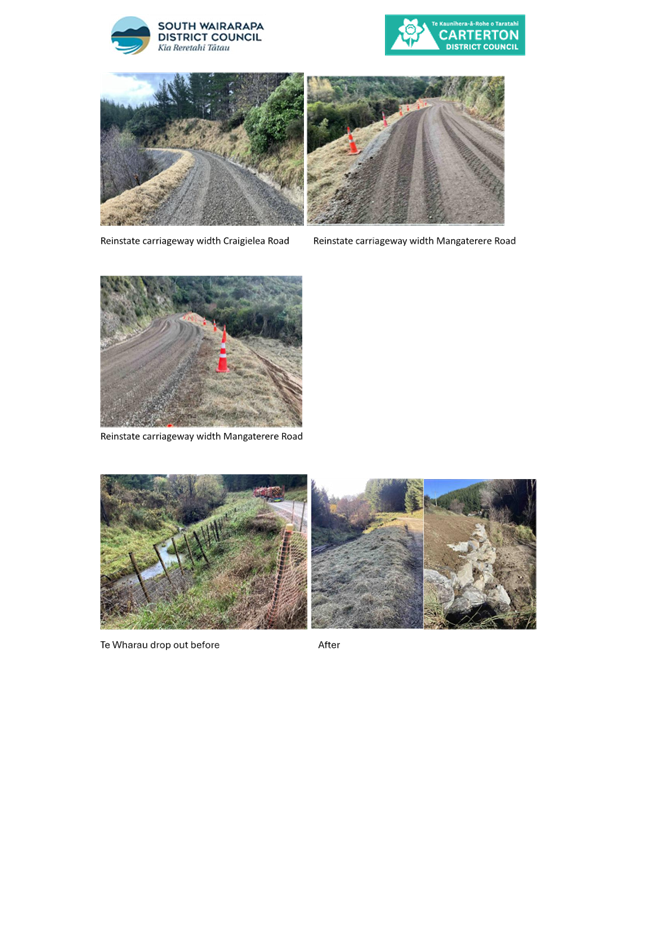
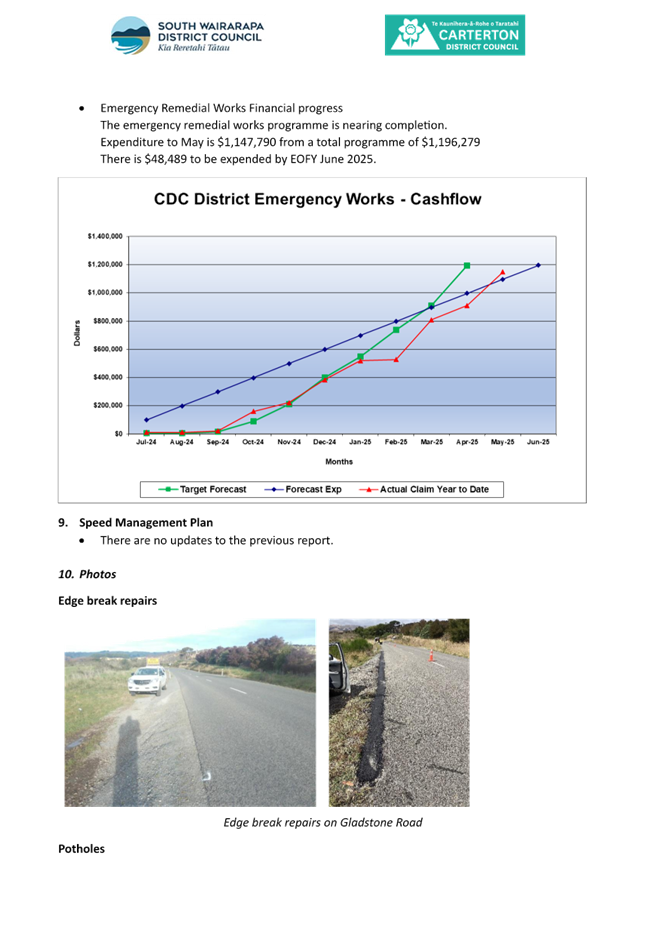
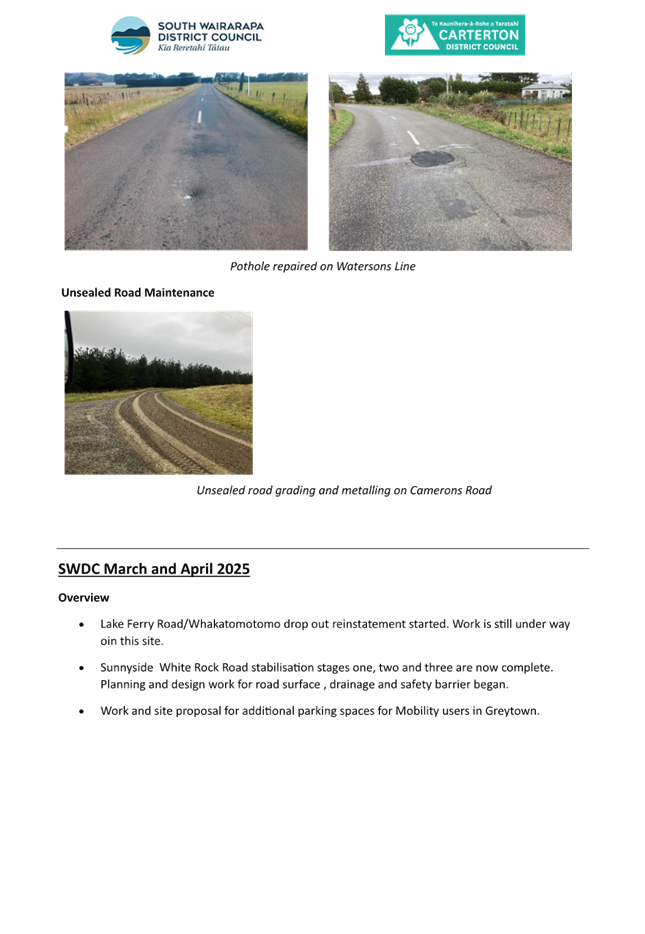
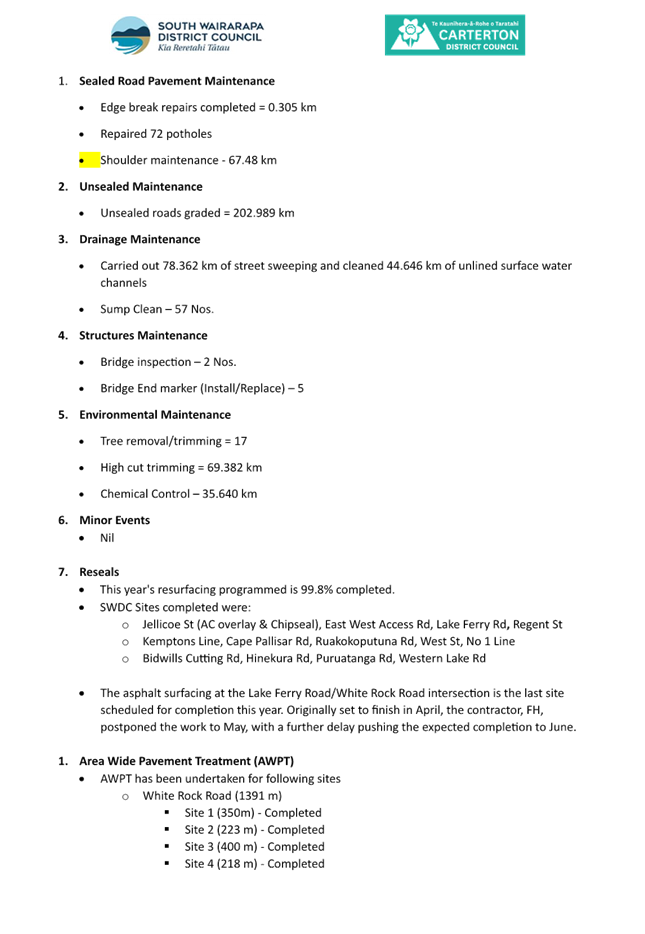
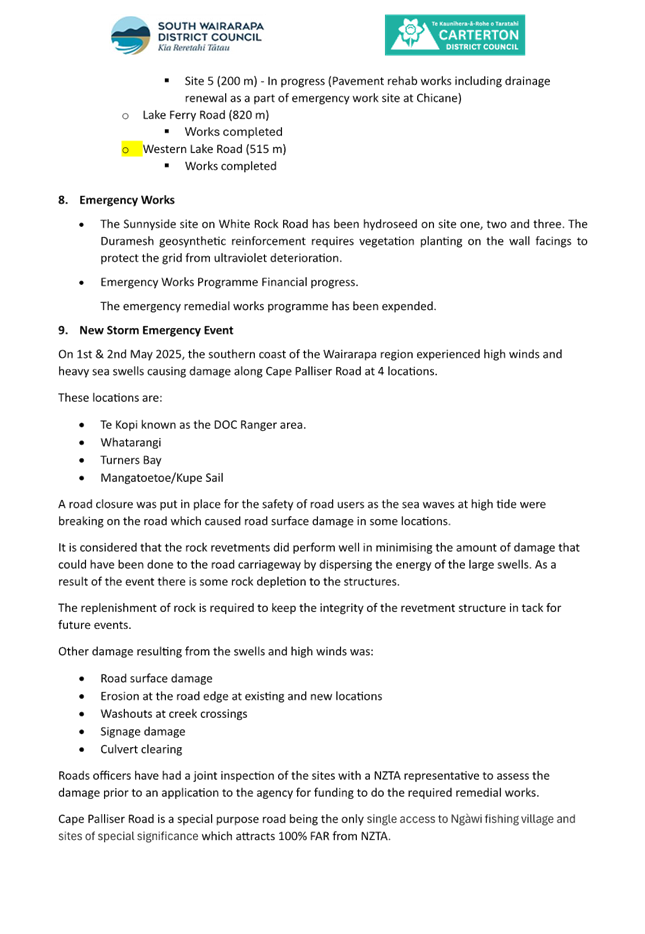
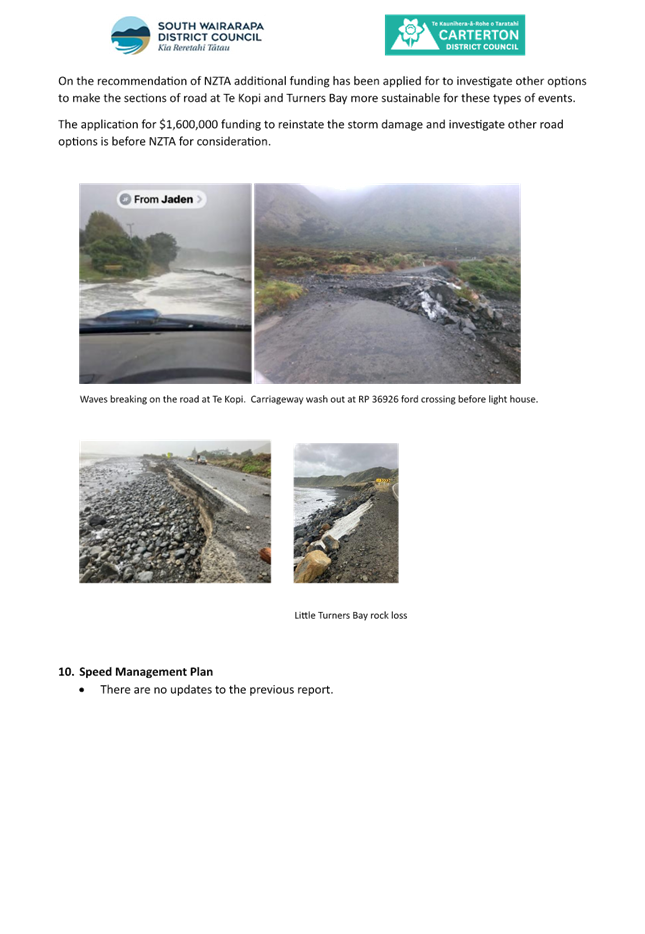
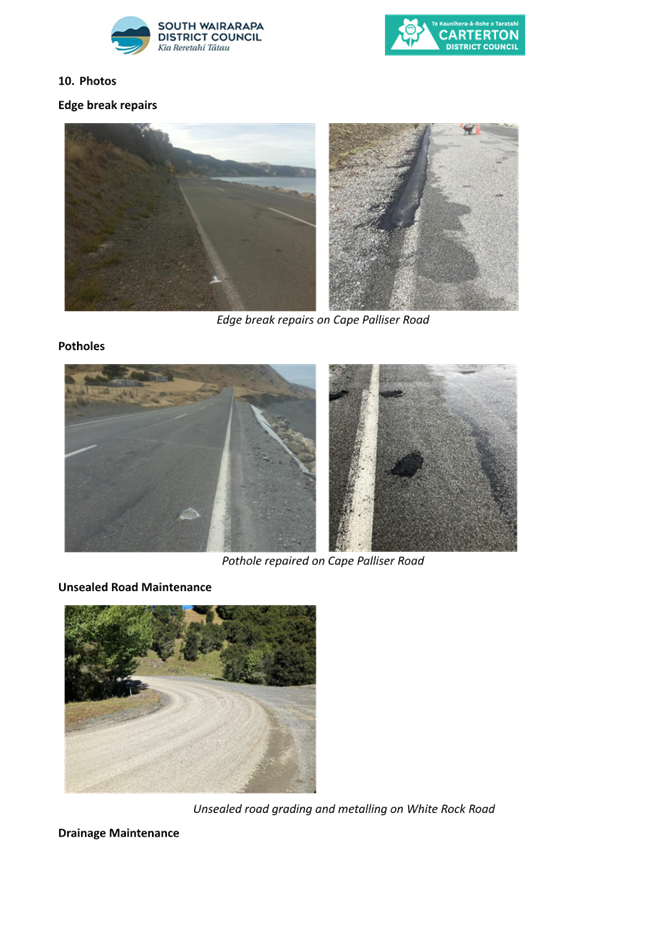
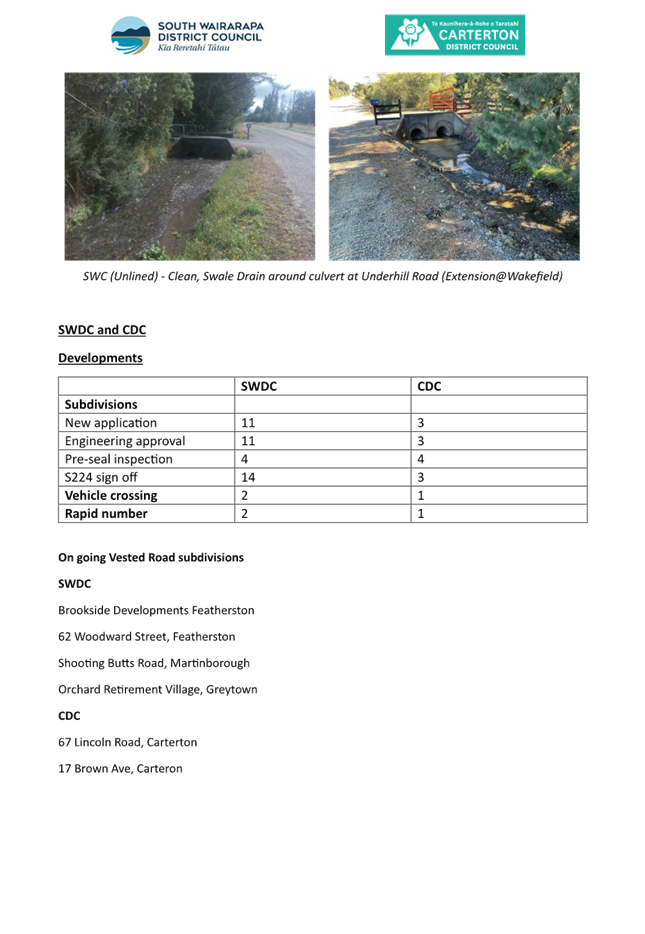
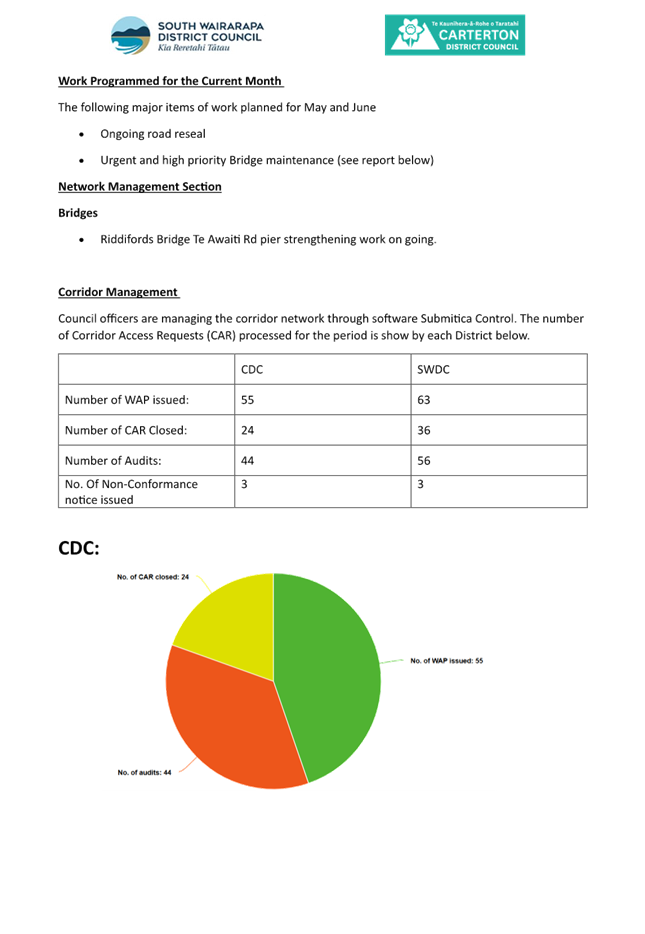
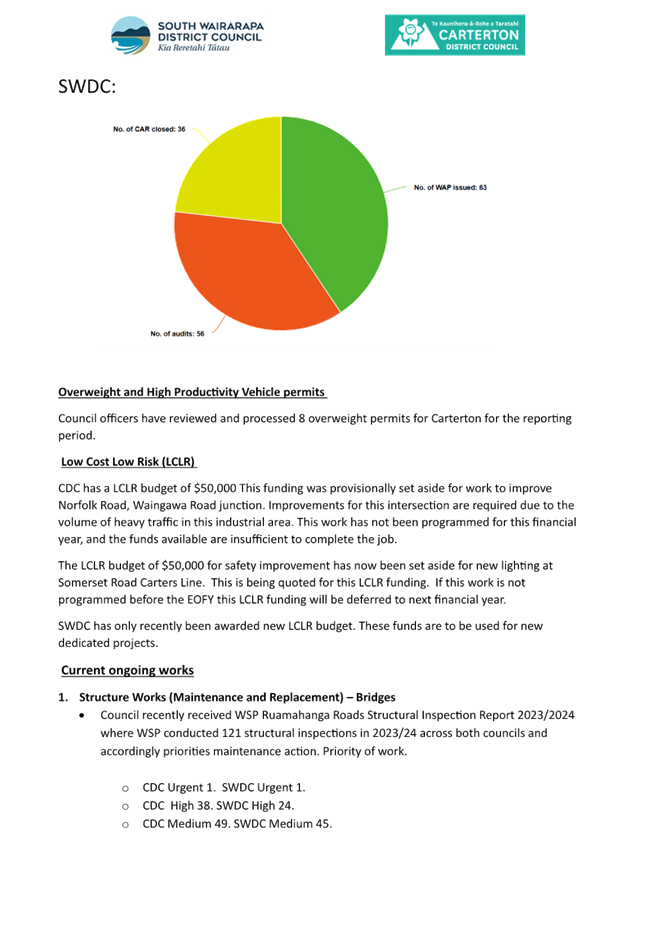
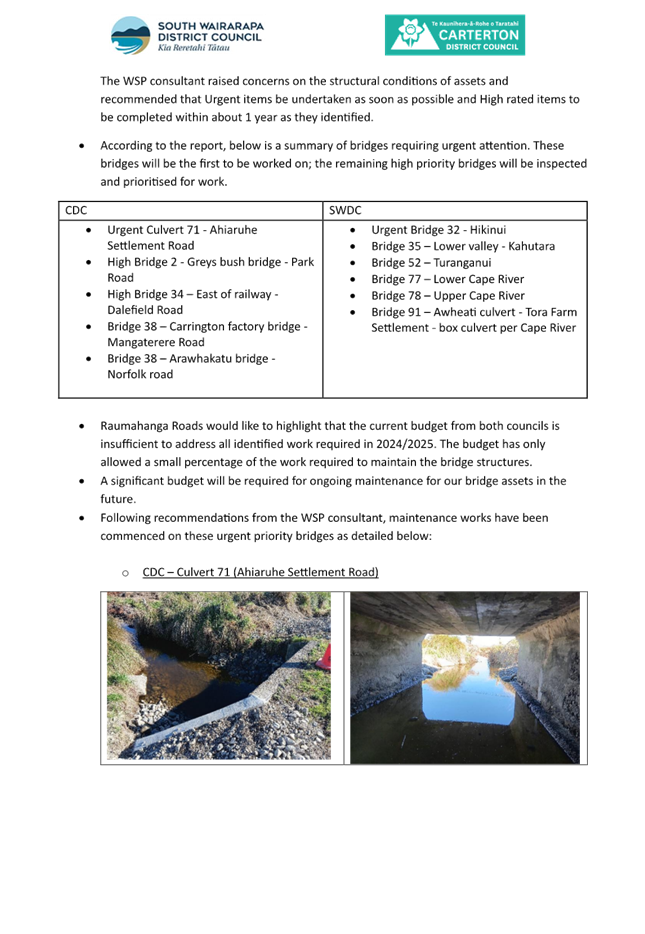
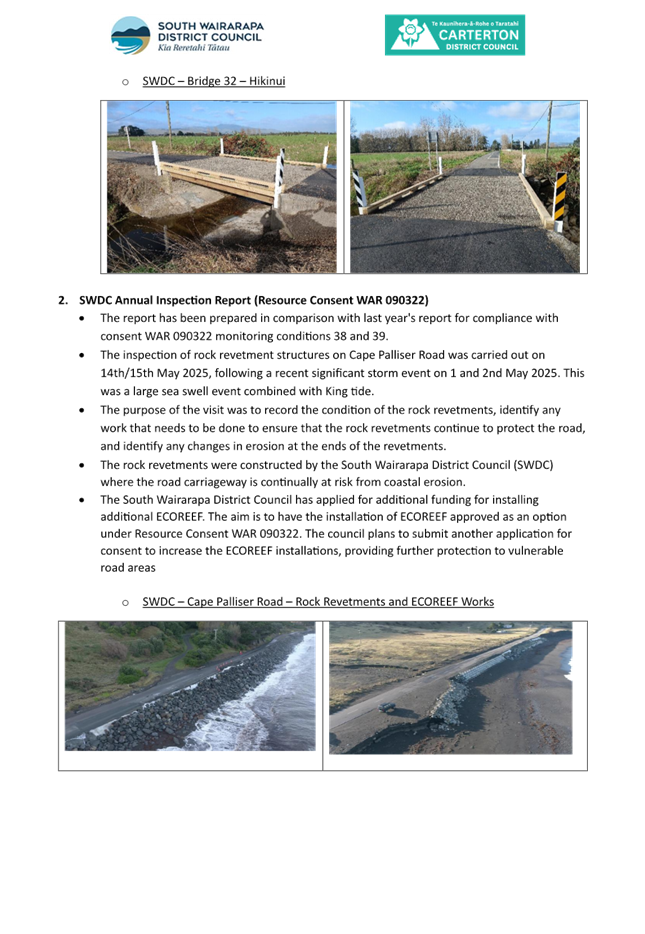
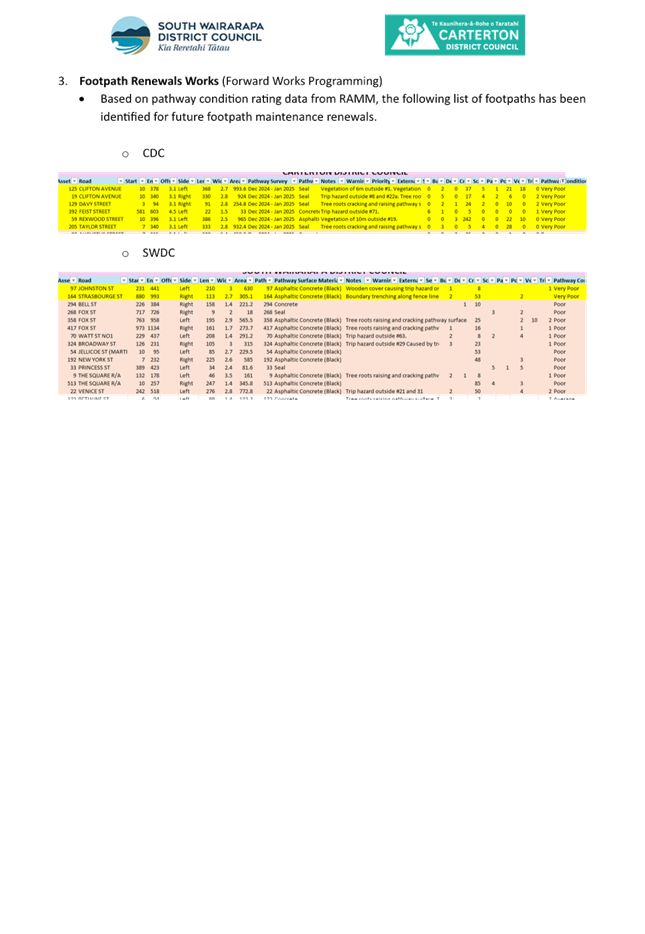
|
Policy
and Projects Committee meeting Agenda
|
18
June 2025
|

7.9 Changes
to the Delegations Manual
1. Purpose
For the Committee to
approve changes to the Delegations Manual for Carterton District Council
(Council).
2. Significance
The
matters for decision in this report are not considered to be of significance
under the Significance and Engagement Policy.
3. Background
The
Delegations Manual sets out the Council’s delegations to Council standing
committees, to the Chief Executive, and to other staff. Its purpose is to
clearly define the parameters under which Council committees and officers are
able to act and provides a mechanism to give effective management of
Council’s affairs.
Council’s
authority to delegate to officers comes from Schedule 7 Clause 32 of the Local
Government Act 2002:
Unless
expressly provided otherwise in this Act, or in any other Act, for the purposes
of efficiency and effectiveness in the conduct of a local authority’s
business a local authority may delegate to a committee or other sub-ordinate
decision-making body, a community board, or member or officer of the local
authority any of its responsibilities, duties, or powers.
The
same clause also lists a number of matters that Council cannot delegate. These
are detailed in the Delegations Manual.
4. PROPOSED
CHANGES
The Manual has been reviewed by
management, and the following changes are recommended:
· Clause 5.3.3
Purchase Orders
o Reflect updated processes of
the council’s automated Purchase Order System.
· Clause 5.3.6
Ruamāhanga Roads Shared Roading Service
o Remove
the specific reference to the ‘SWDC Roading Manager’ instead using
the neutral title of ‘Roading Manager’ which enables the manager to
be employed by either council of the shared service.
o Remove
the CDC Senior Roading Officer which is no longer a position.
· Clause
5.3.7 Financial delegations
o Changes
to the delegation brackets to increase the level for Tier 3 Managers and Team
Leaders from $1,000 to $5,000.
o Following
an organisational review of the Executive Leadership (ELT) and Finance Teams:
§ Include
the addition of a Chief Financial Officer position which will assume the
finance-related delegations of the current Corporate Services Manager position.
§ Include
the addition of a Group Manager People and Corporate position which will assume
other delegations of the current Corporate Services Manager position.
§ Change
other ELT manager title roles to Group Managers.
§ Remove
the Finance Team Leader position to be replaced by a Senior Financial
Accountant position.
o Make
other additions, deletions and title changes as outlined in the Version Control
table.
The
recommended amendments are detailed in the Delegations Manual (Attachment
1).
5. CONSIDERATIONS
5.1 Climate change
There
are no climate change considerations required.
5.2 Tāngata whenua
There
are no tāngata whenua considerations required.
5.3 Financial impact
There
are no financial considerations required.
5.4 Community Engagement
requirements
There are no community engagement considerations required.
5.5 Risks
There
are no risk considerations required.
5.6 Wellbeings
There
are no Community Wellbeings considerations required.
6. Recommendation
That the Committee:
1. Receives
the report.
2. Approves
the changes to the Delegations Manual, as outlined in Attachment 1.
File
Number: 464191
Author: Geri
Brooking, People and Wellbeing Manager
Attachments: 1. Delegations
Manual updated 18 June 2025 ⇩
|
Policy
and Projects Committee meeting Agenda
|
18
June 2025
|
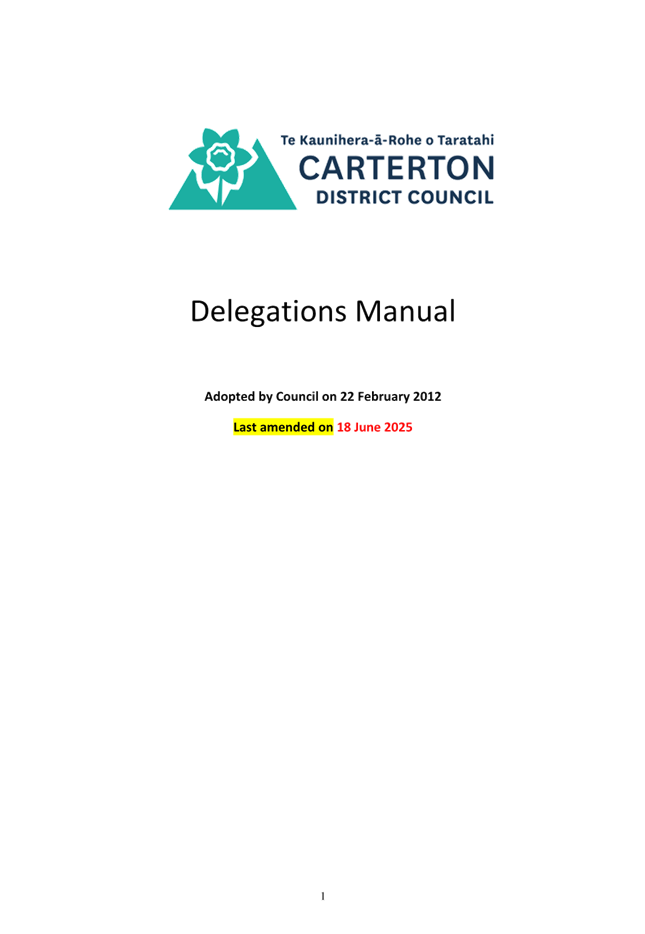
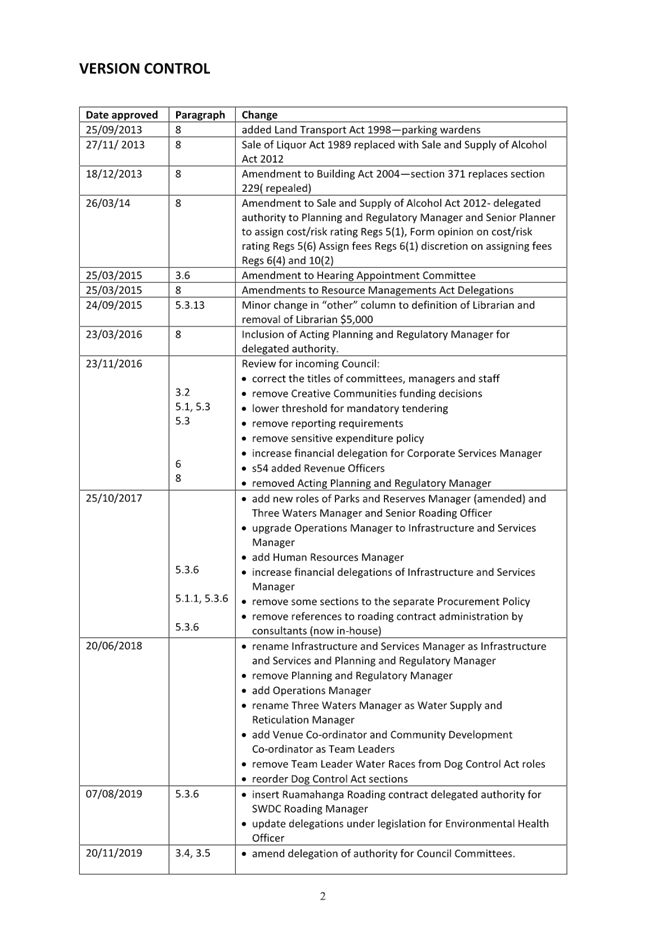
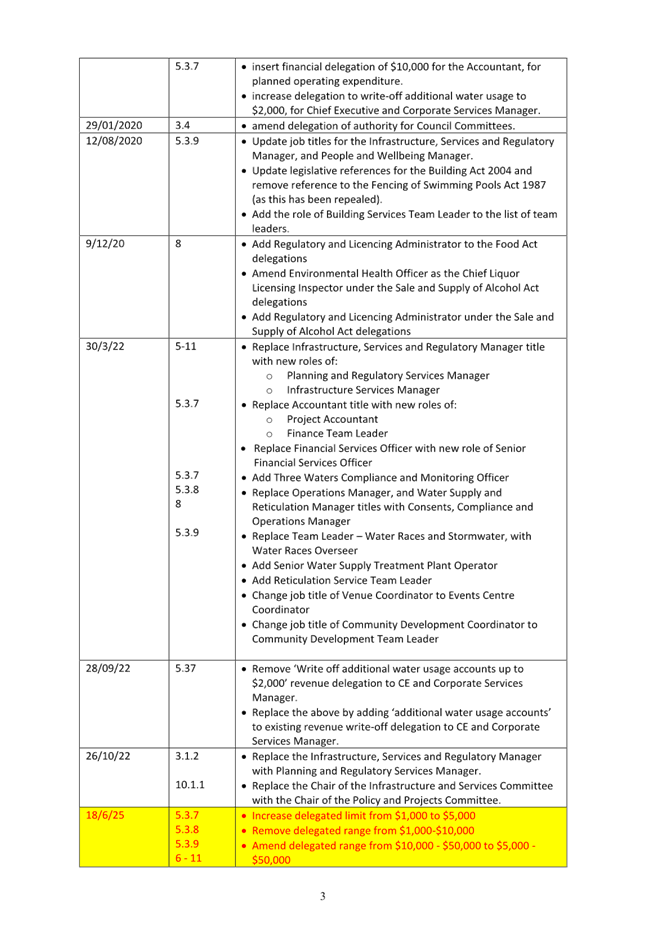
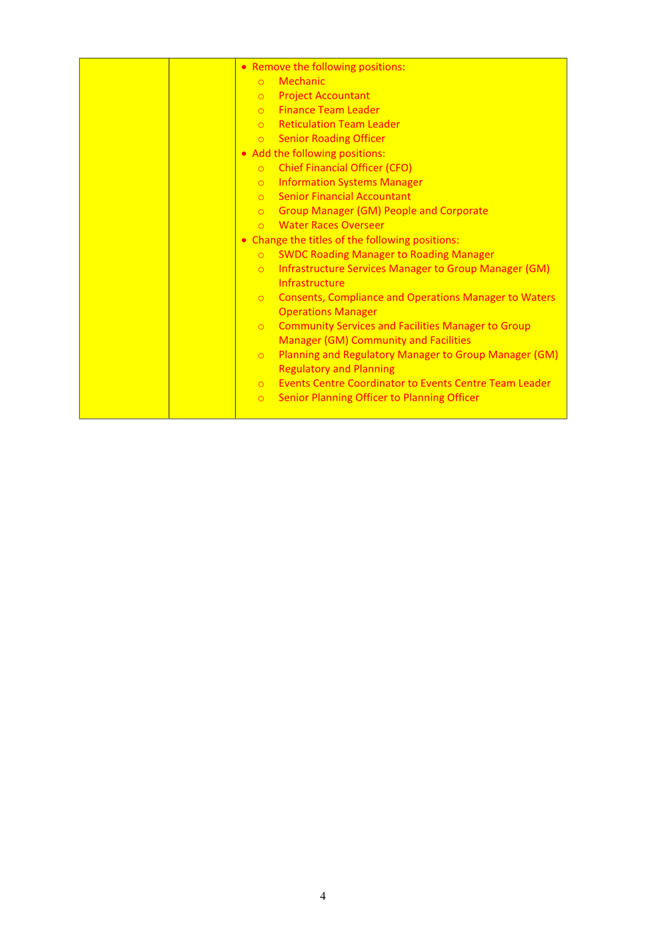
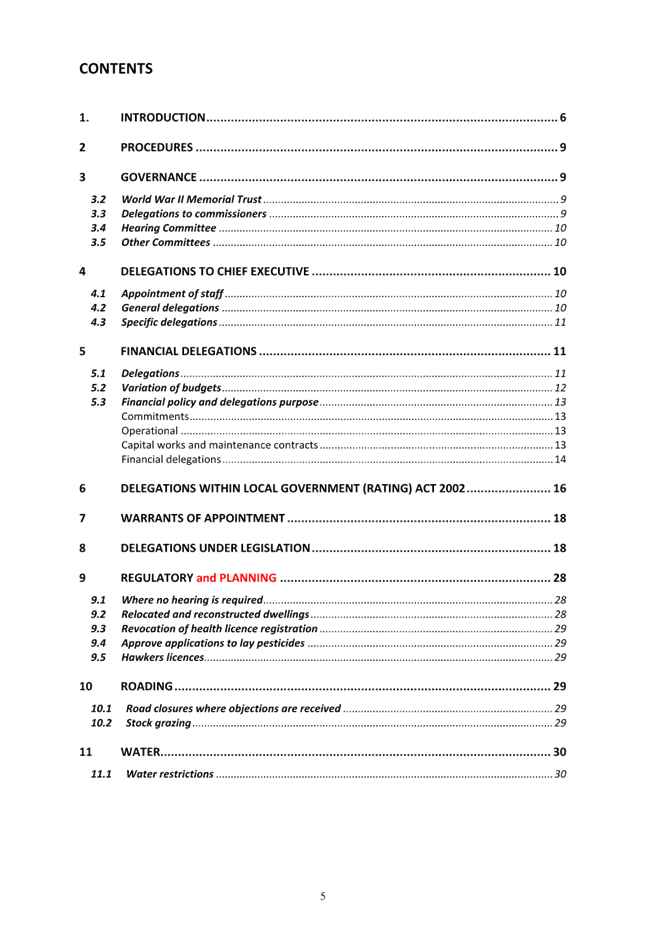
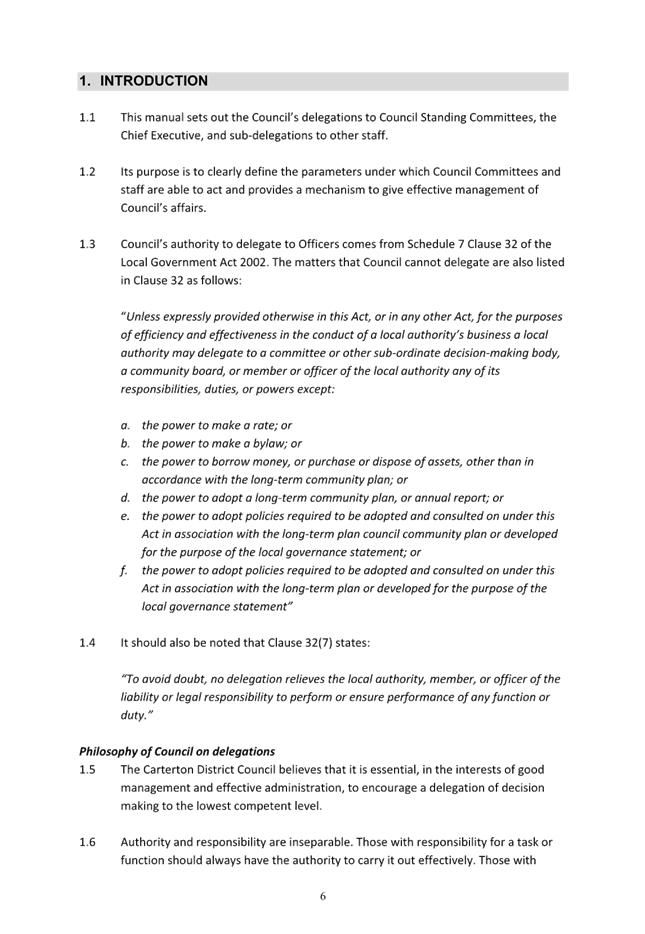
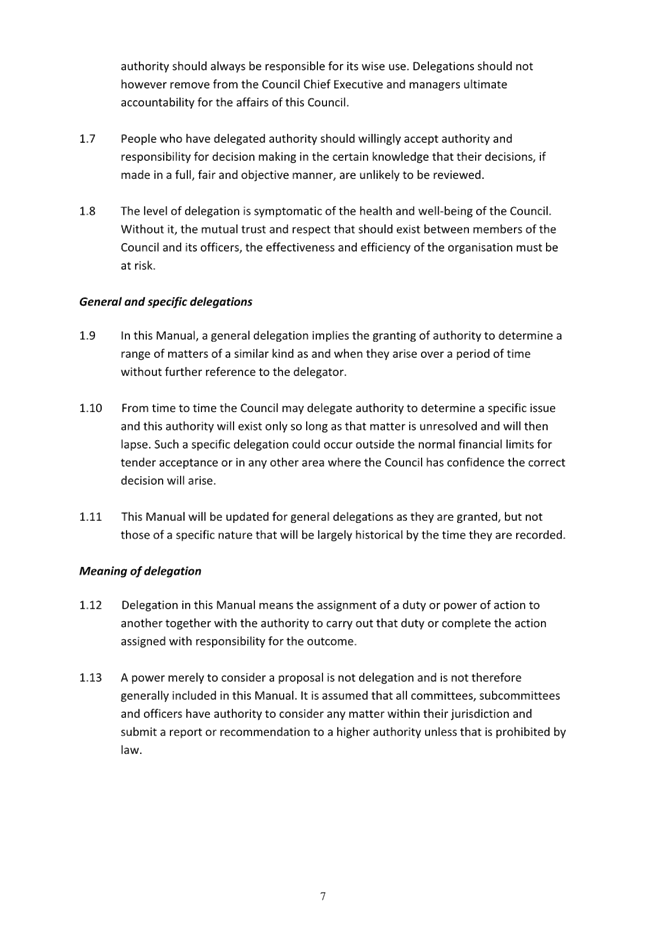
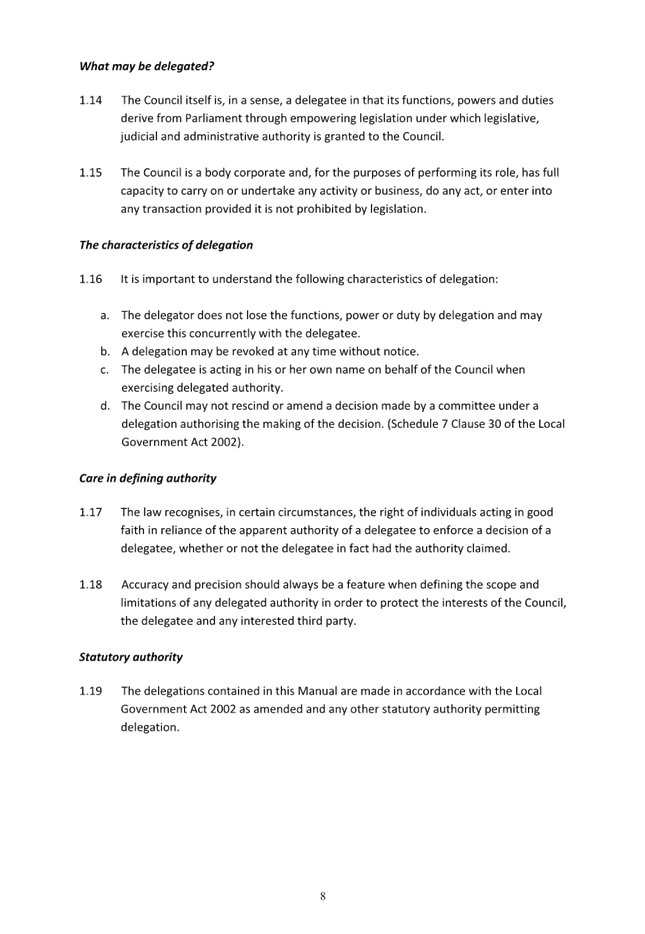
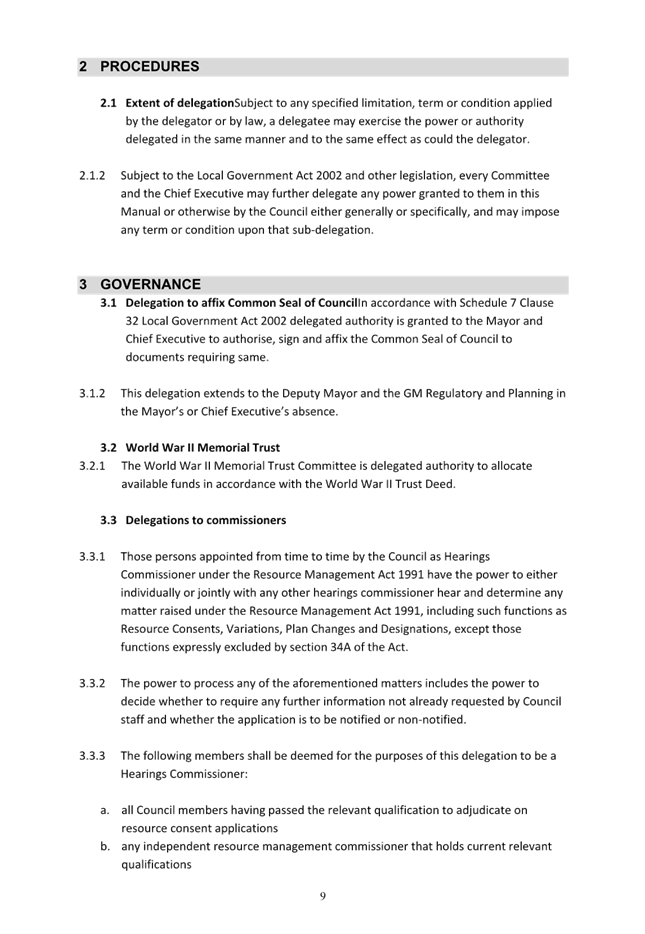
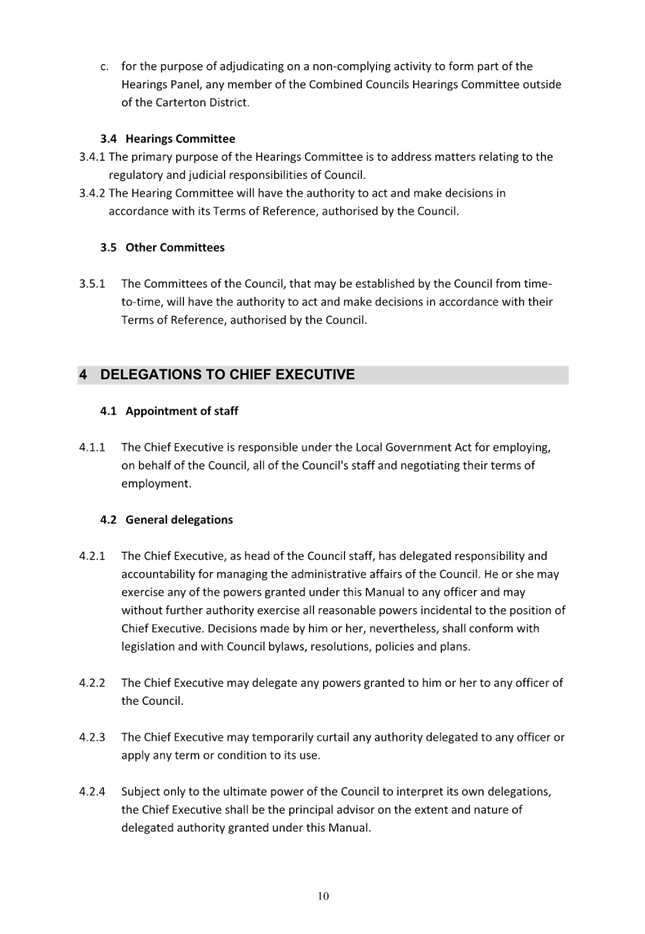
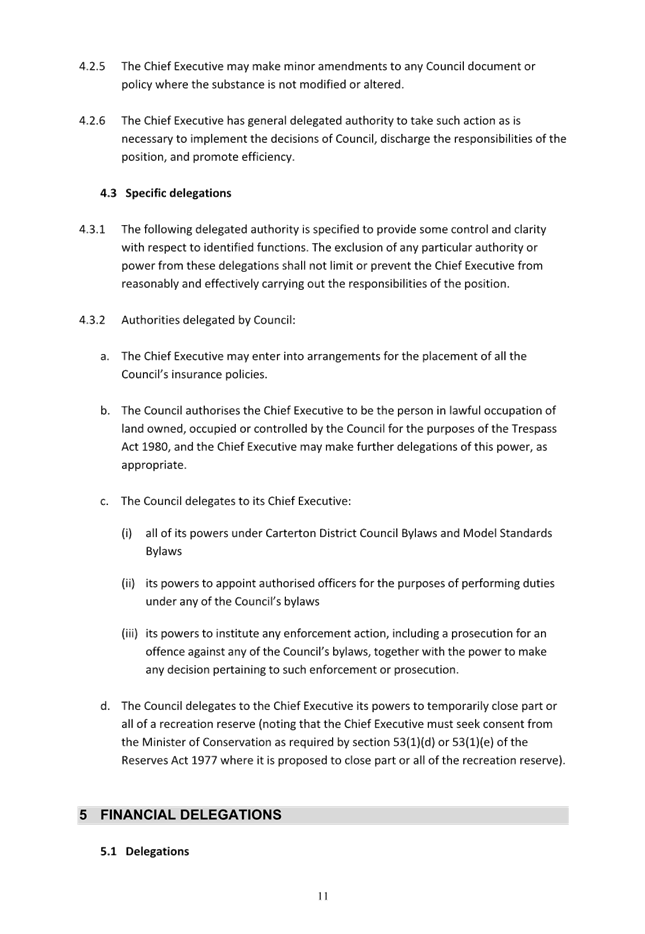
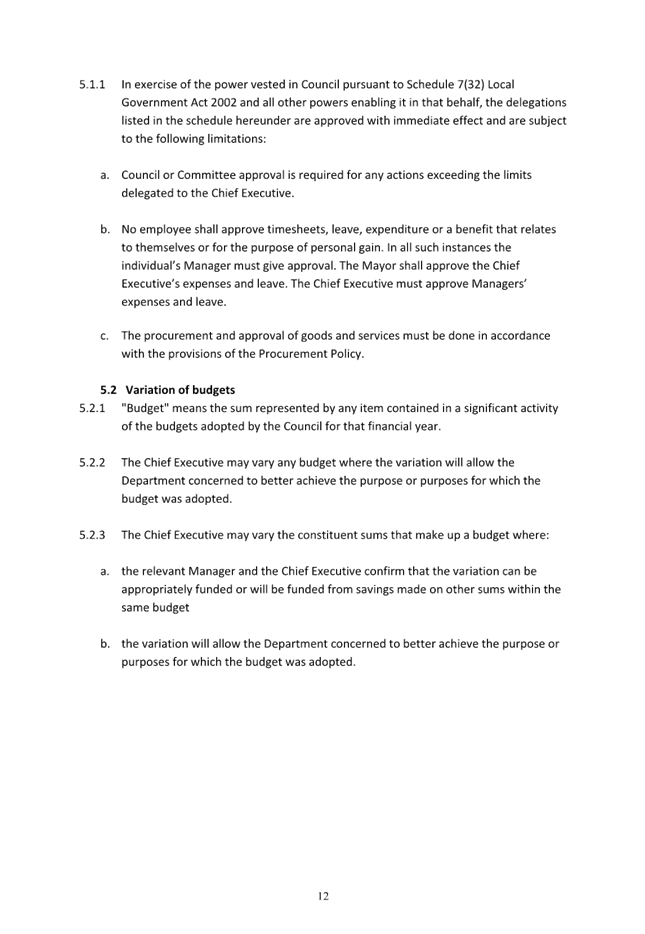
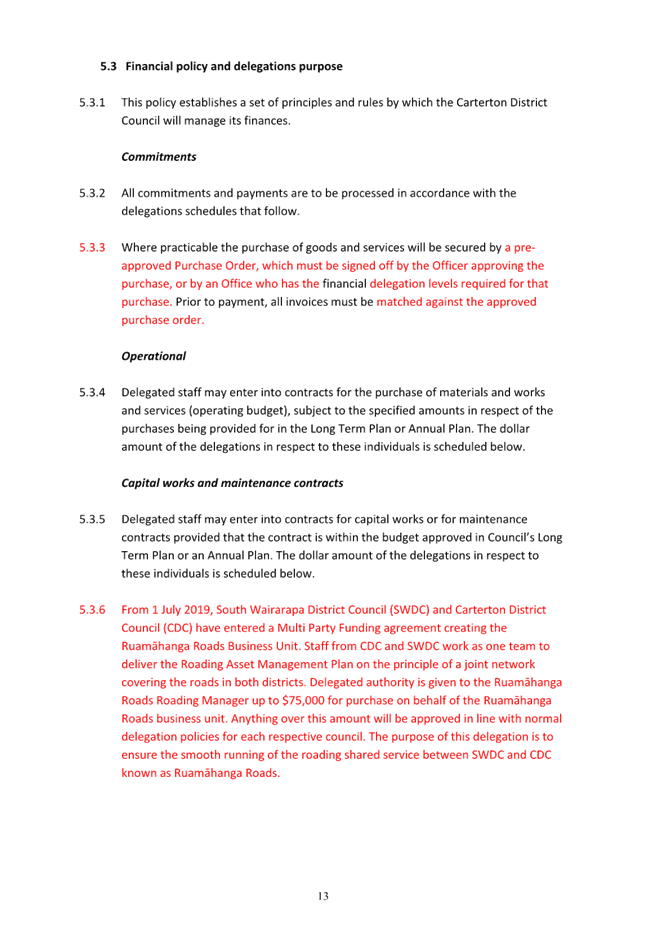
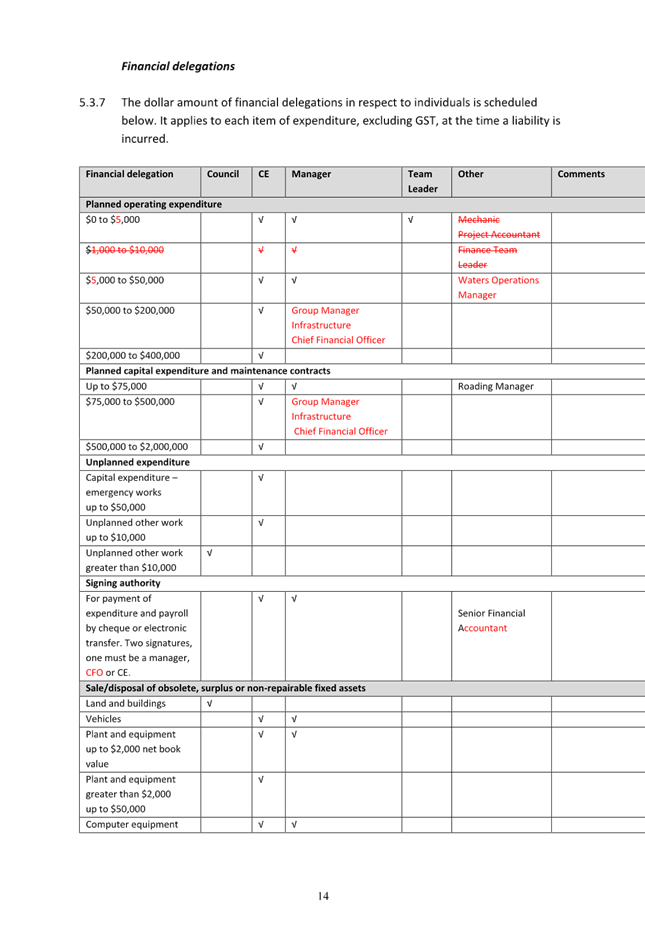
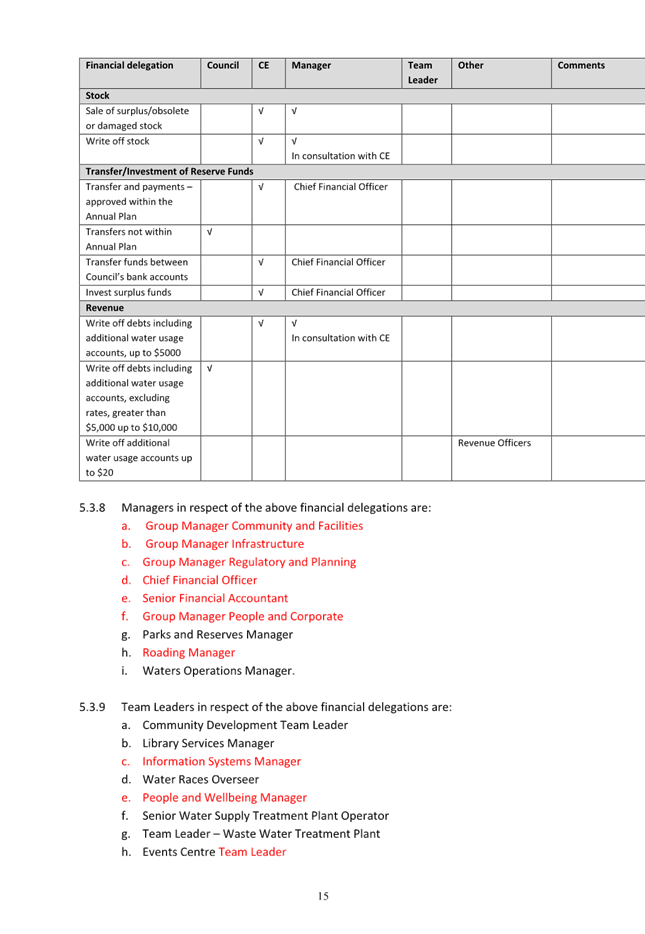
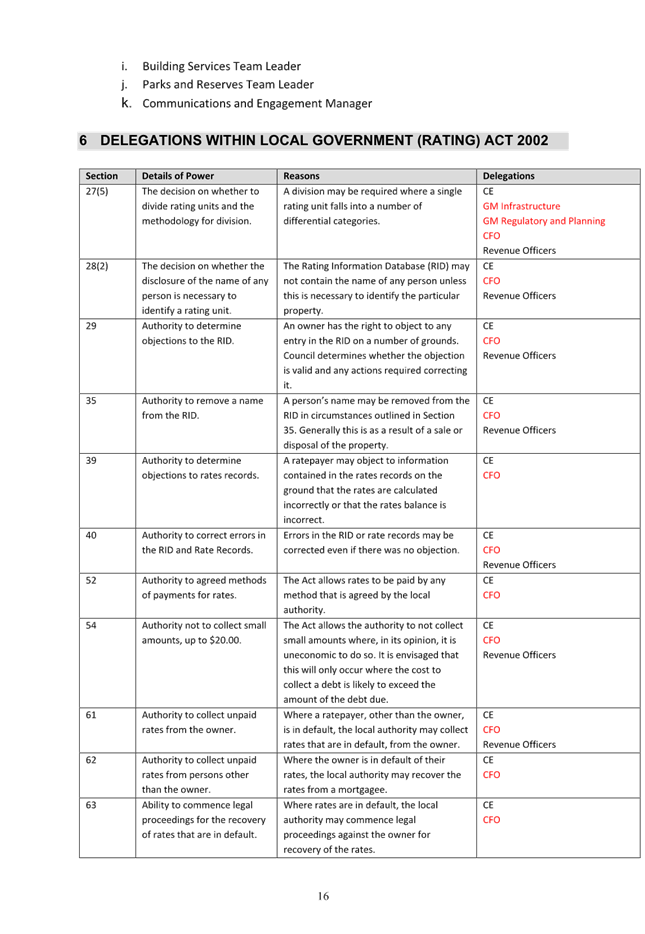
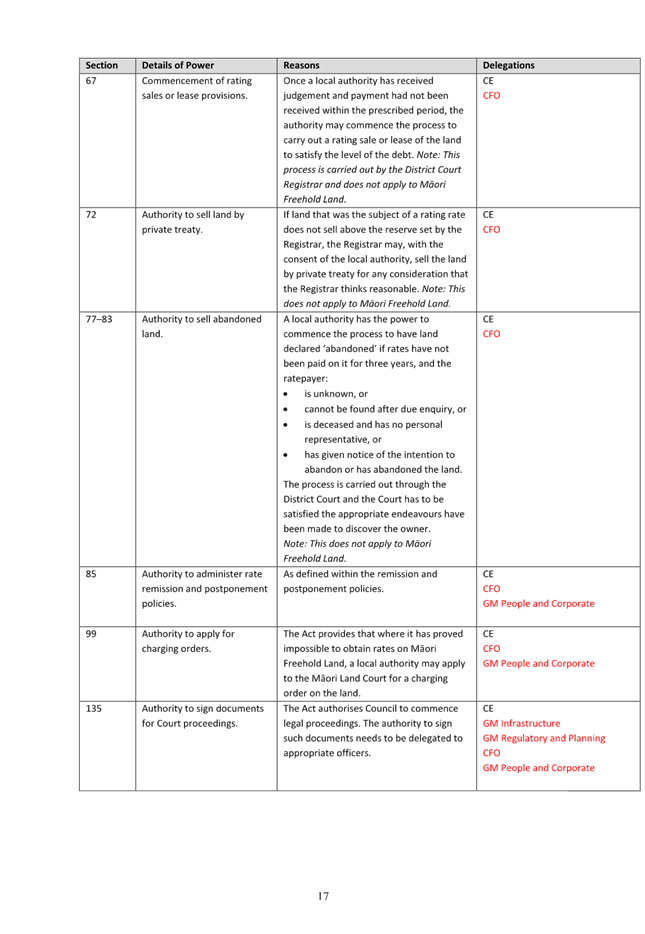
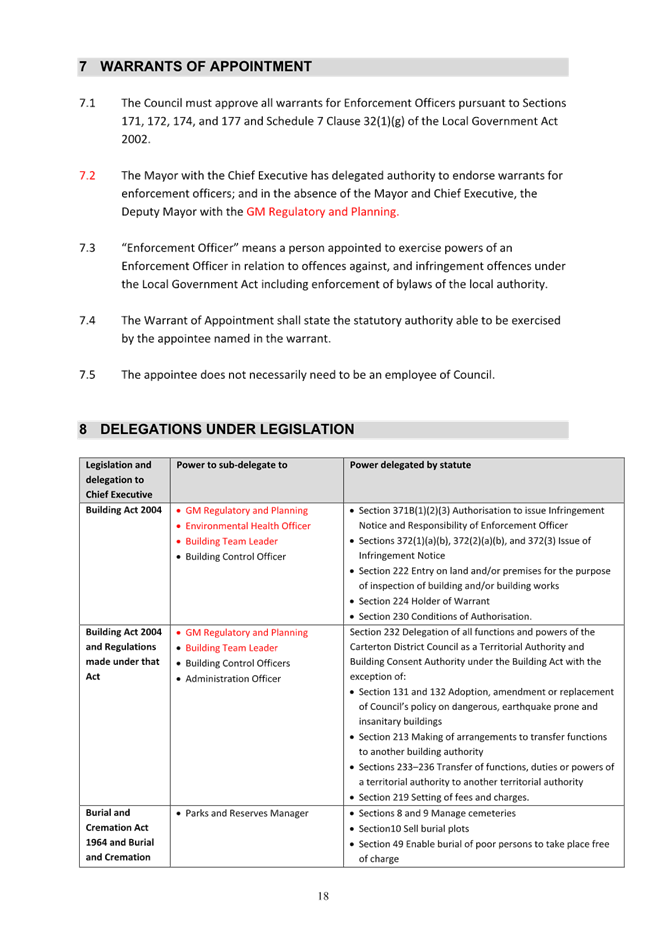
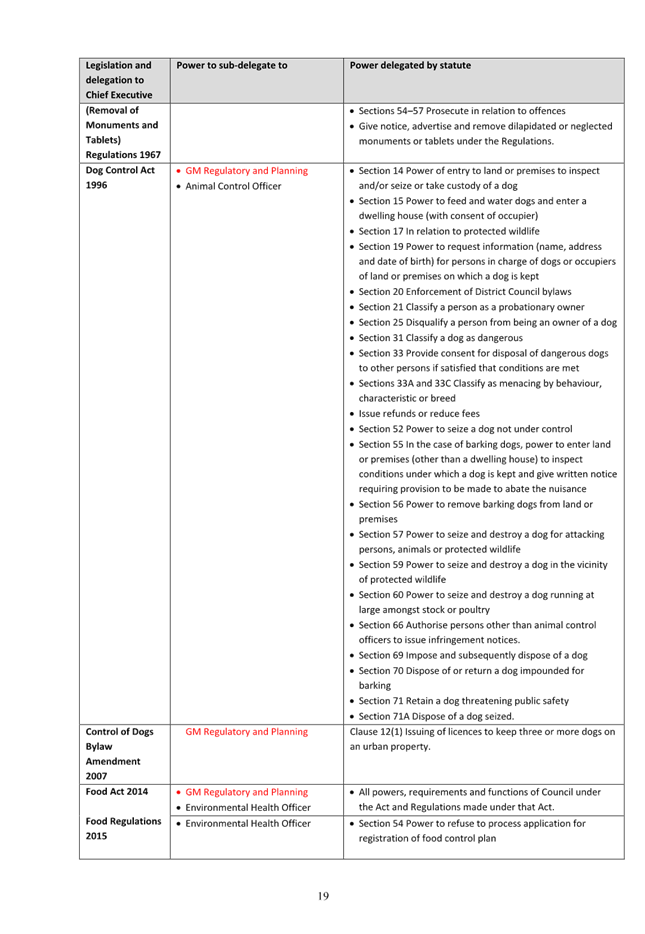
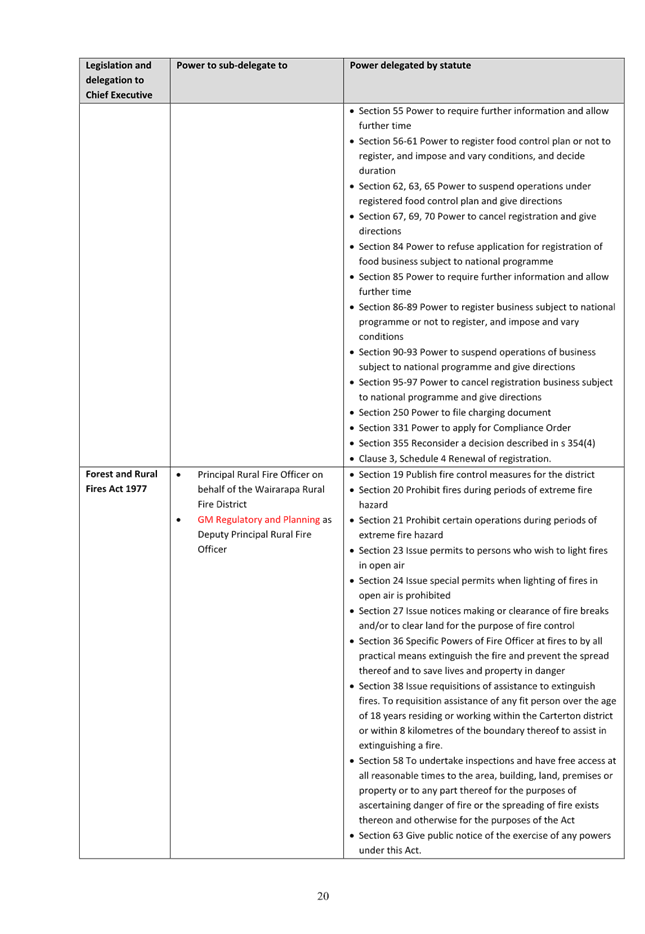
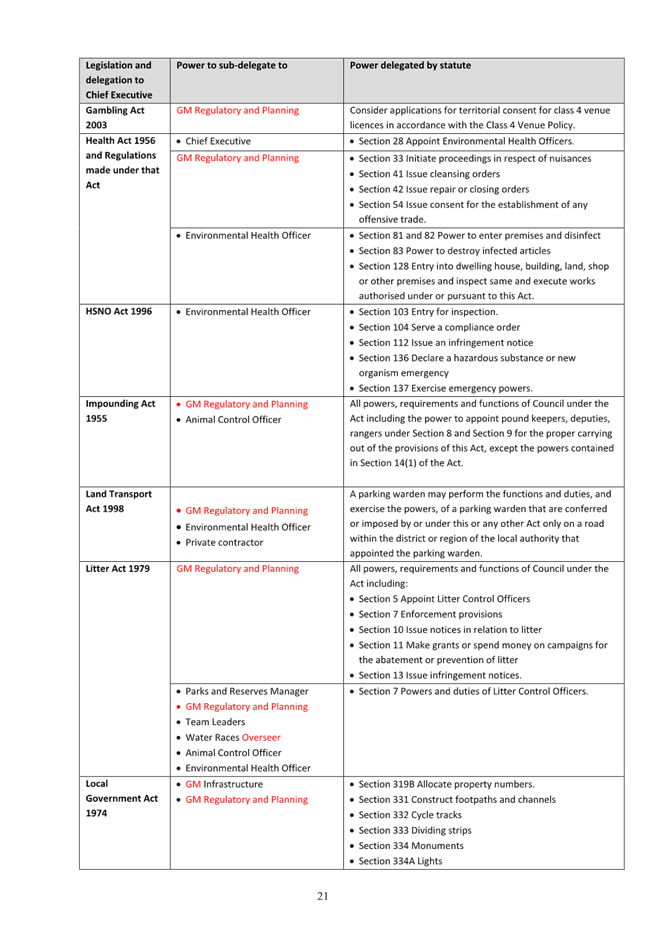
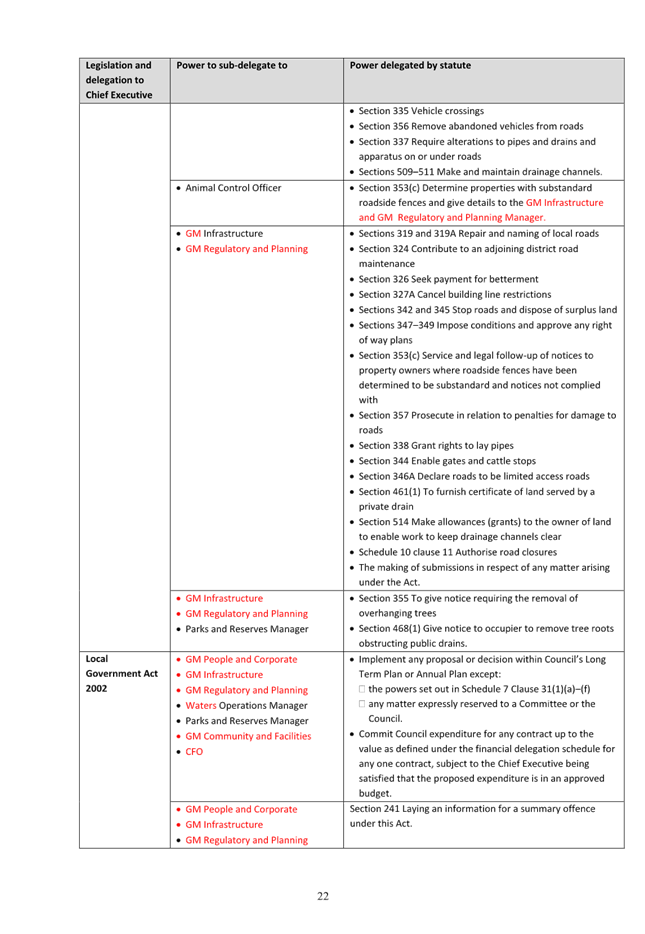
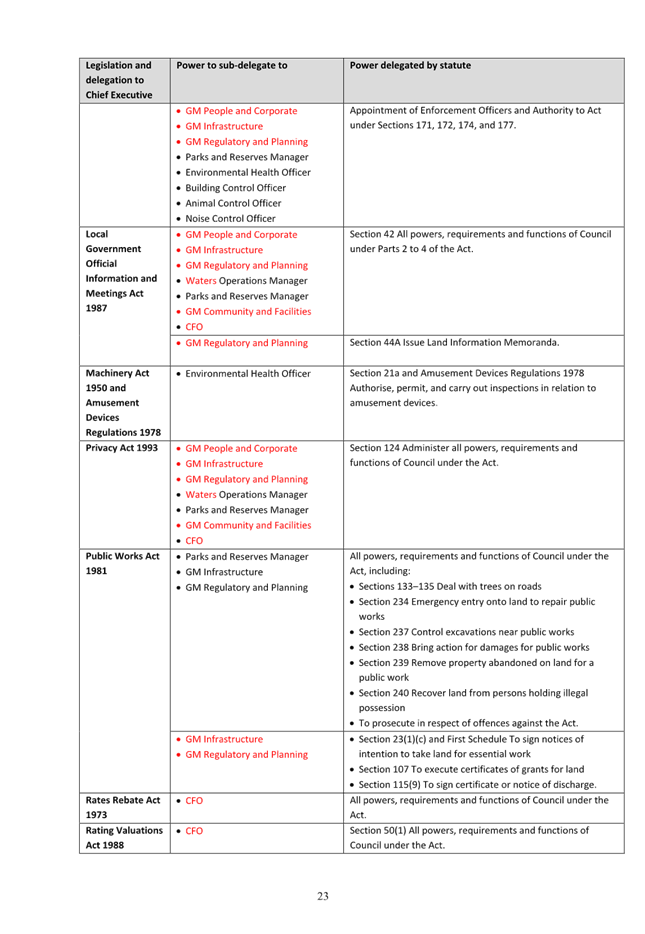
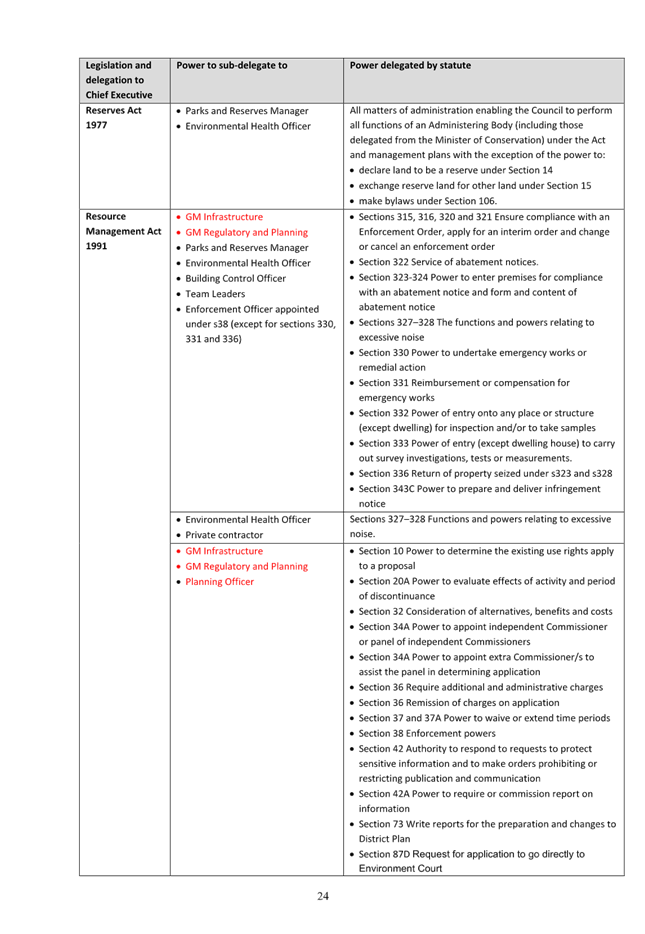
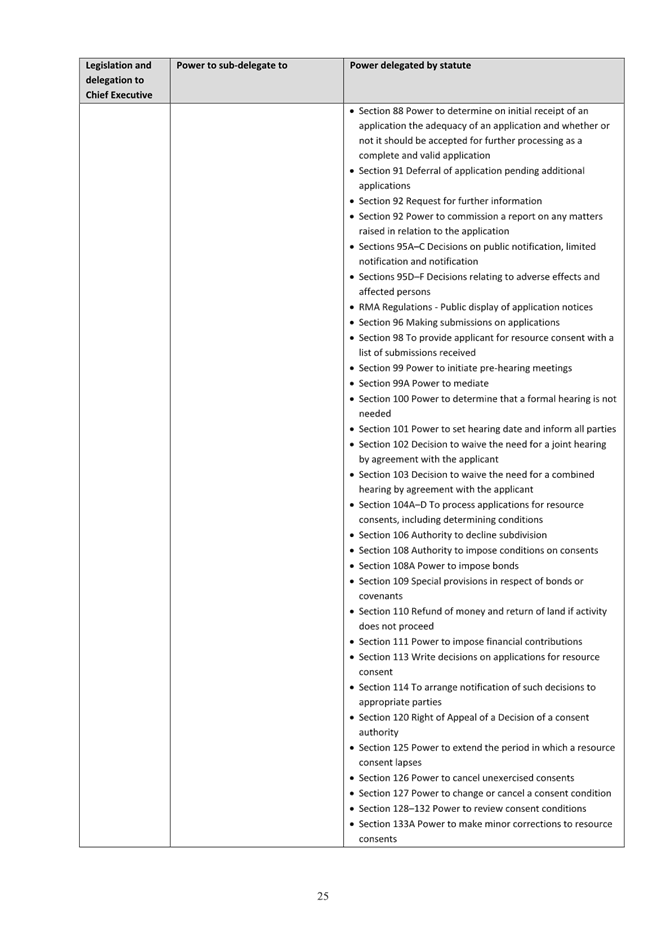
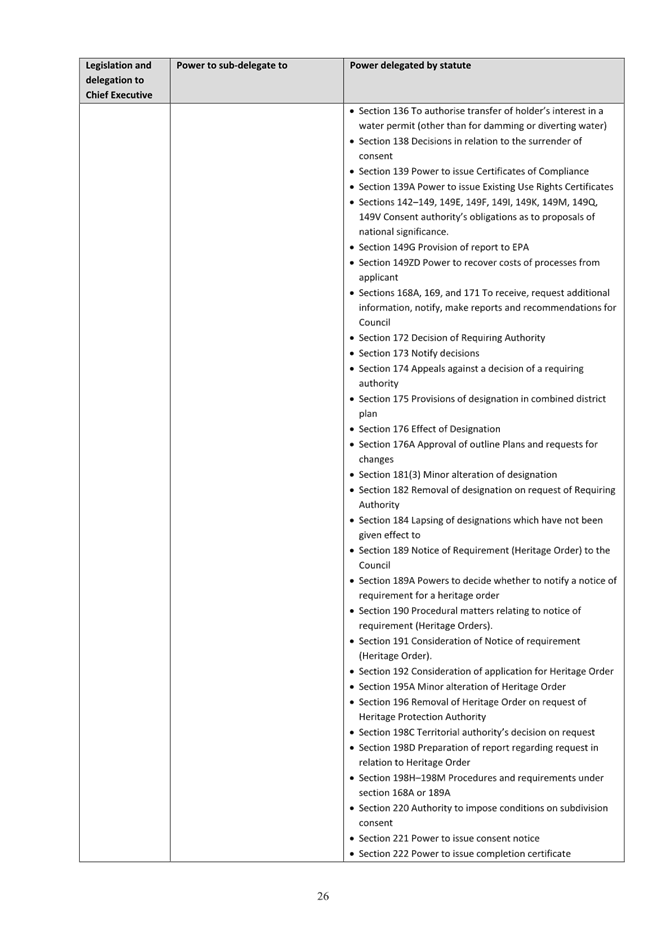
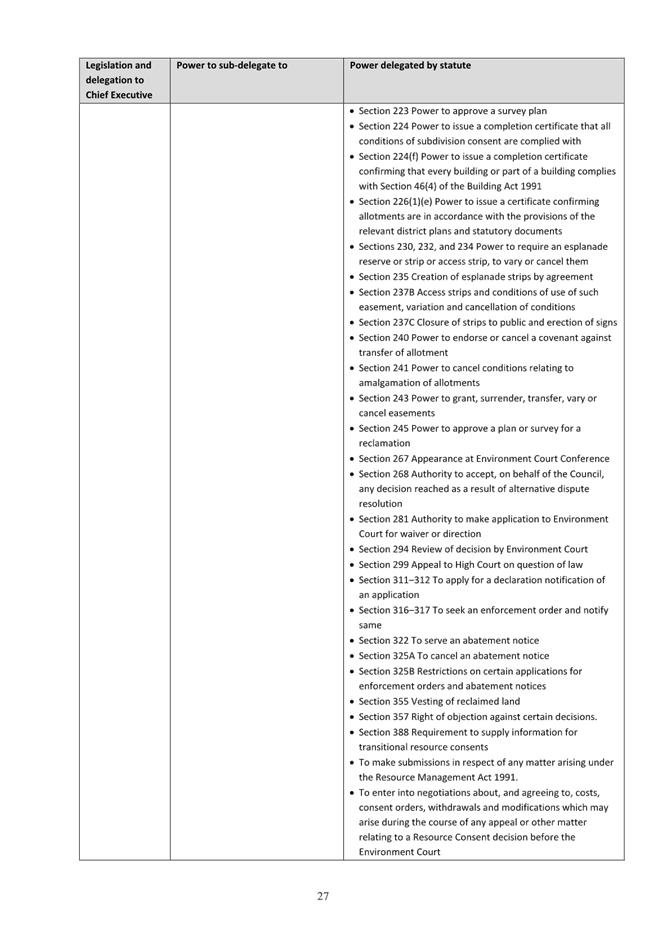
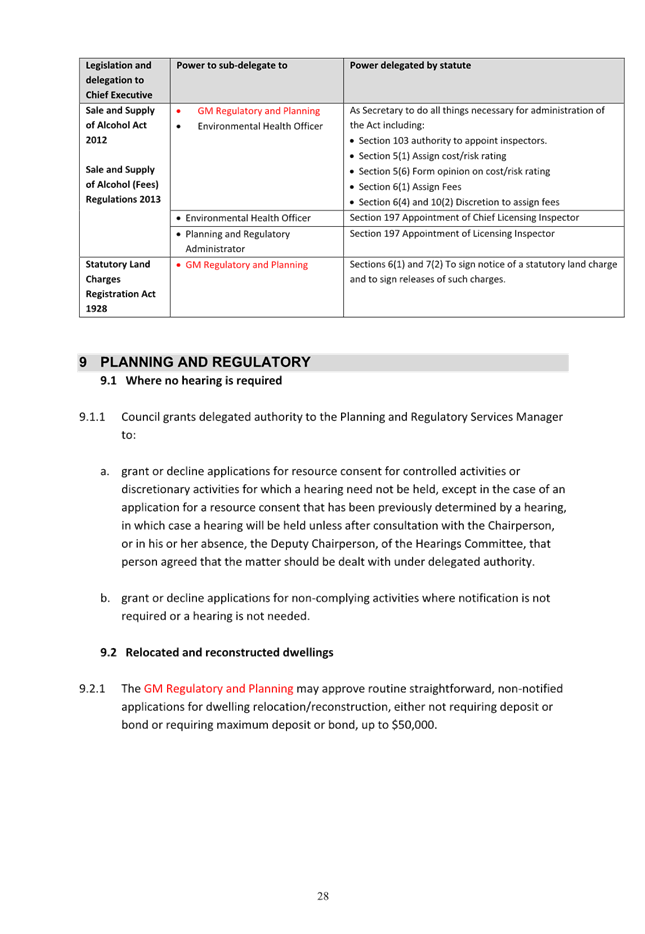
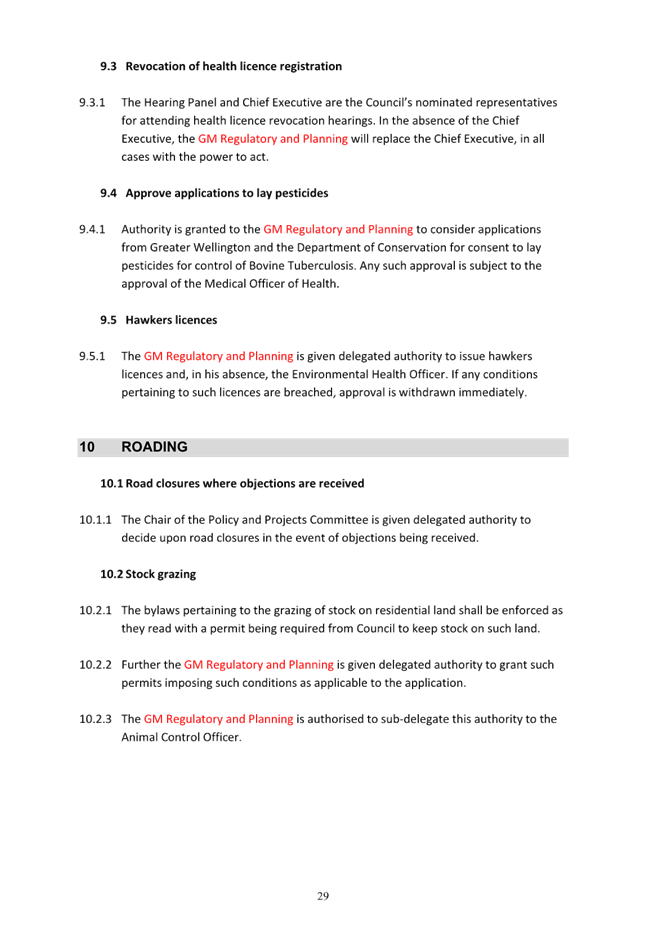

|
Policy
and Projects Committee meeting Agenda
|
18
June 2025
|

7.10 Review
of Emergency Management Plans
1. Purpose
For the Committee to
be updated on the Business Continuity Plan and new Crisis Management Plan.
2. Significance
The
matters for decision in this report are not considered to be of significance
under the Significance and Engagement Policy.
3. Background
It is
essential that CDC can effectively respond to and manage crisis events,
such as a natural disaster or severe weather incident, and continue to deliver
critical functions and operations in the event of these, or any other type of
disruption to our services.
4. Discussion
4.1 Business
Continuity Plan (BCP)
Management
and staff have reviewed the existing BCP (Attachment 1) and, together
with general updates, a number of areas were identified for development.
Traditionally
the BCP has included specific crisis management processes. The plan was also
very heavily focused on managing the delivery of services during the various
phases and restrictions of the COVID-19 pandemic.
The
BCP has now been broadened to capture disruption caused by any type of event
rather than the narrow focus of natural disaster and COVI-19. Potential
disruption may include cyber security attack, power outages, building closure
or damage, and staff shortages. Additionally, the specific crisis
response and management processes have been developed into a Crisis Management
Plan as outlined below.
The
BCP will be a living document that evolves as different circumstances and
disruptive situations occur. Further review of the individual business
unit plans and procedures that support the BCP is now required to be completed
by management.
4.2 Crisis Management Plan (CMP)
The CMP (Attachment 2) has been developed
to guide staff on effective management of crisis events. A crisis event
is that which requires an elevated level of response and coordination above the
capacity of business as usual (BAU) activities. These types of events may
impact, disrupt or harm Council’s reputation, service delivery, or
operational capability and capacity, and require management through the
coordinated Crisis Management Team (CMT).
The CMP also provides
the link to escalated levels of response that require external support
including the activation of the Wairarapa Emergency Operations Centre (EOC).
As this is a new
emergency plan, processes will continue to be reviewed and refined as we
undertake training and exercises to implement the Plan with council staff.
5. CONSIDERATIONS
5.1 Climate change
The
increasing frequency of severe weather events due to climate change means we
are more likely to experience local environmental events such as weather events
and flooding.
5.2 Tāngata whenua
Council’s
Kaituitui has been added to the Crisis Management Team to ensure any
considerations for tāngata whenua are included in responses and plans.
5.3 Financial impact
There
are no budgetary decisions required in this
report.
5.4 Community Engagement
requirements
There are no community engagement requirements required in this report.
5.5 Risks
There are no risk considerations required
in this report.
5.6 Wellbeings
Effective
emergency management plans support the following community wellbeing outcomes:
Social
· A strong and effective council providing trusted leadership
· A caring community that is safe, healthy, happy and connected
· Fit for purpose public facilities, spaces, parks and rural reserves
Cultural
· Te Āo Māori/Māori aspirations and partnerships are
valued and supported
Environmental
· A safe and resilient water supply, and wastewater and stormwater
systems
· Healthy, sustainable waterways
· An environmentally responsible community committed to reducing our
carbon footprint and adapting to the impacts of climate change
· A resilient community capable of responding and recovering from
environmental shocks
Economic
· Quality, fit-for-purpose infrastructure and services that are
cost-effective and meet future needs.
6. Recommendation
That the Committee:
1. Receives
the report.
2. Endorses
the Business Continuity Plan and Crisis Management Plan.
File
Number: 454225
Author: Geri
Brooking, People and Wellbeing Manager
Attachments: 1. CDC
Business Continuity Plan ⇩
2. CDC
Crisis Management Plan ⇩
|
Policy
and Projects Committee meeting Agenda
|
18
June 2025
|
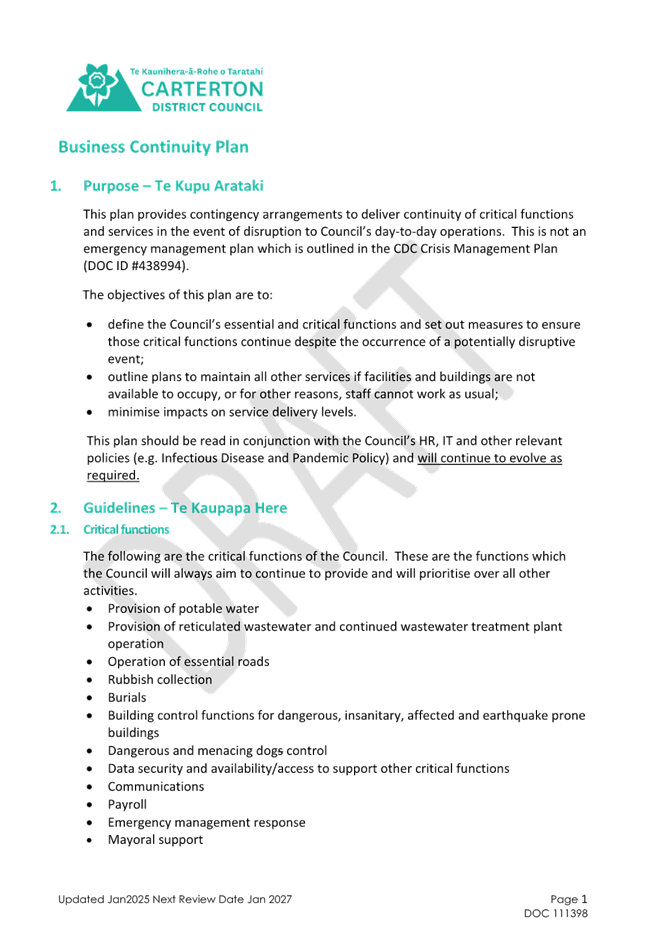
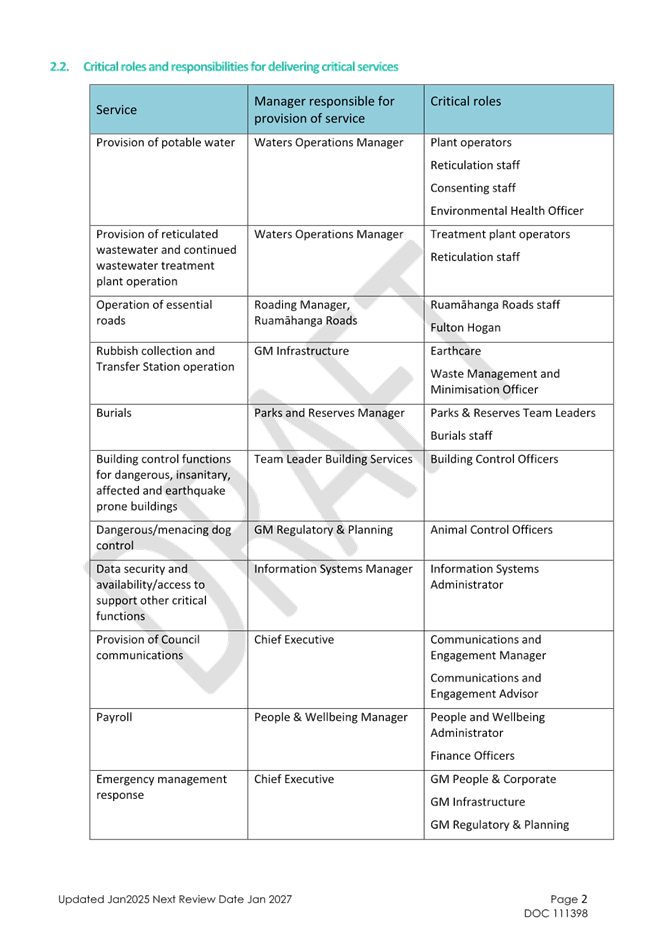
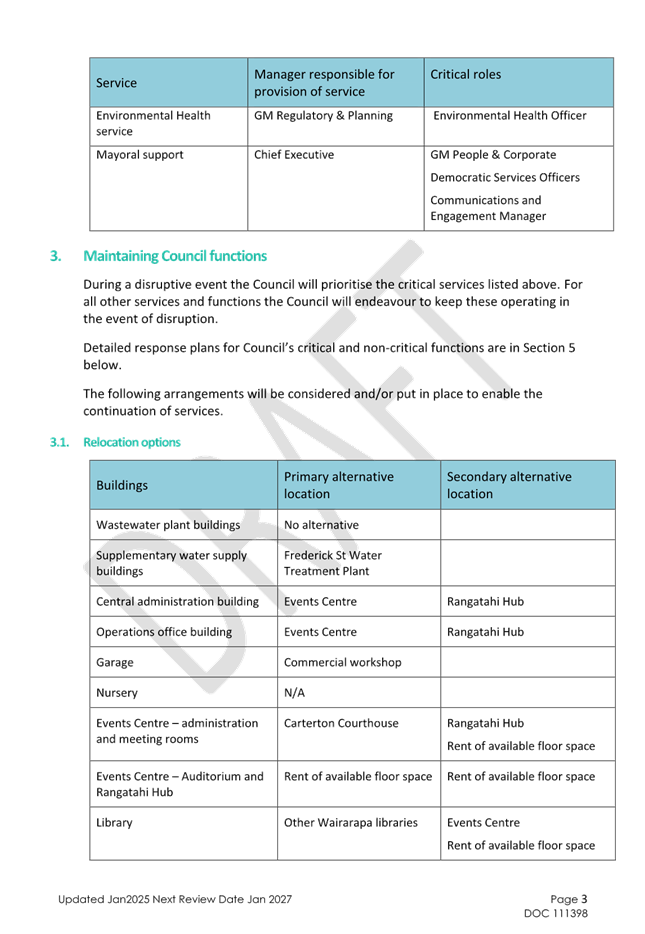
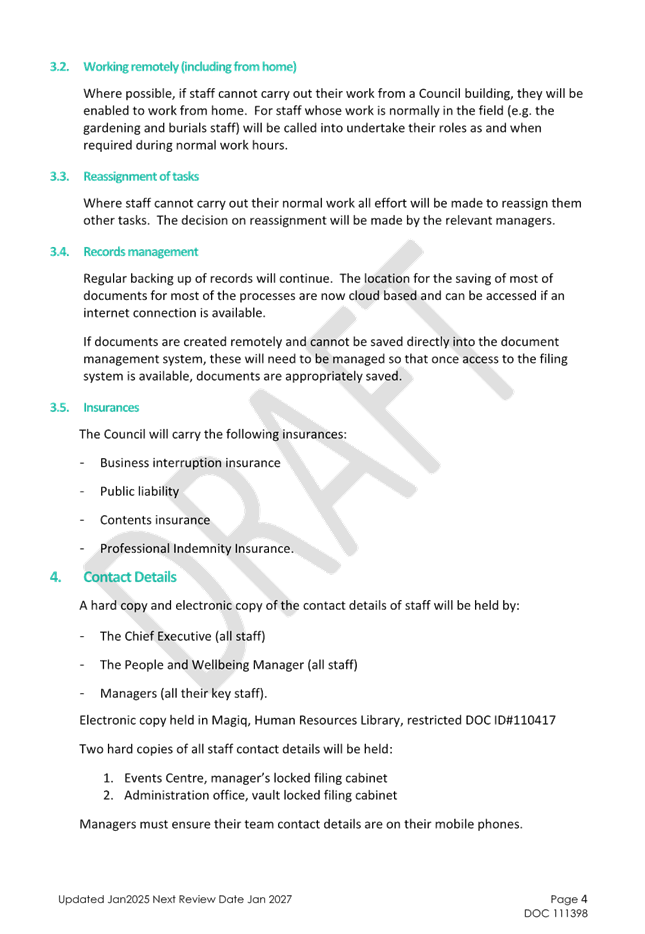
|
Policy
and Projects Committee meeting Agenda
|
18
June 2025
|
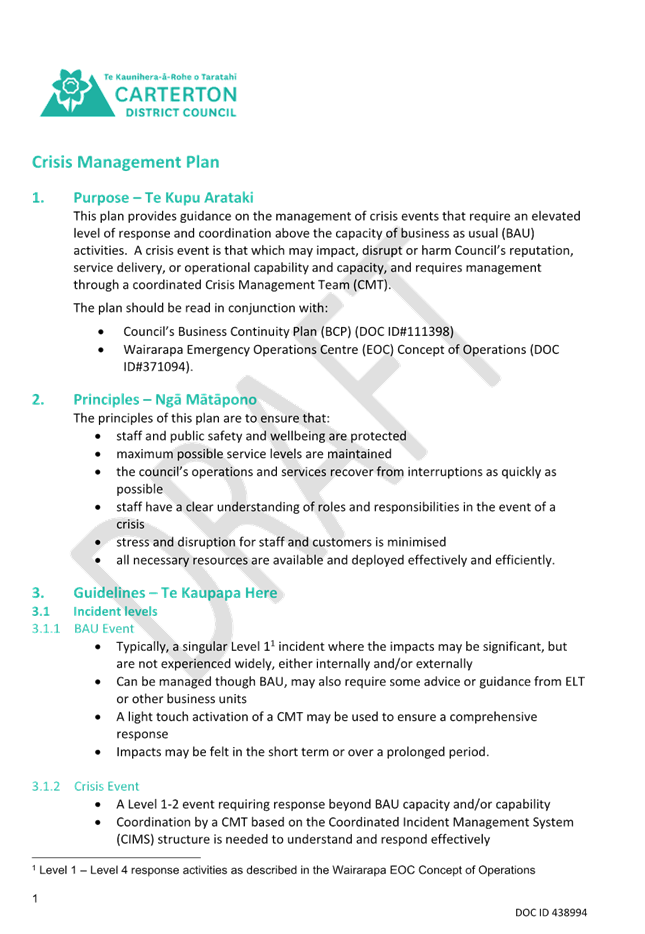
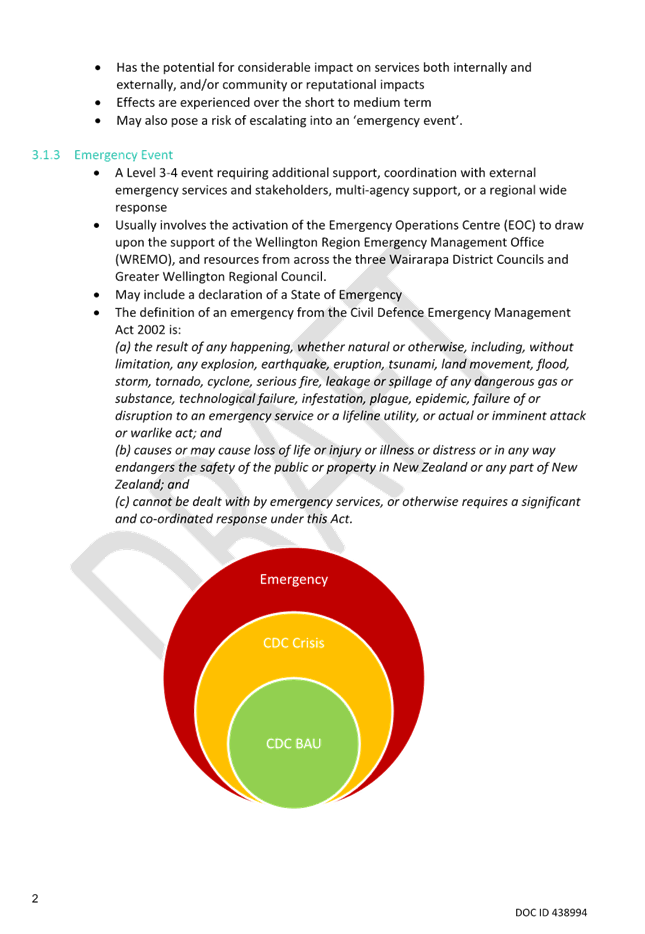
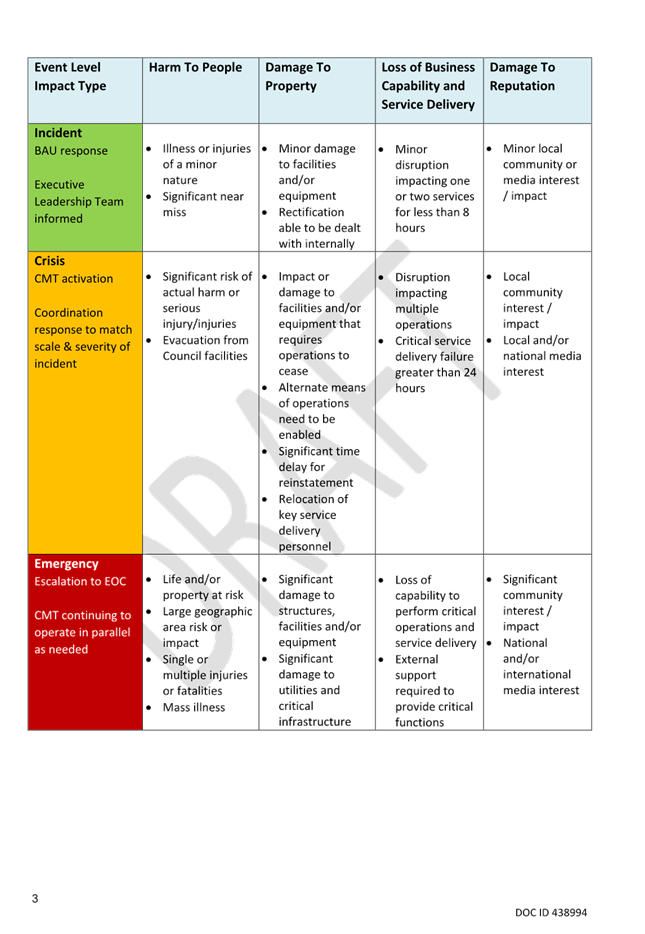
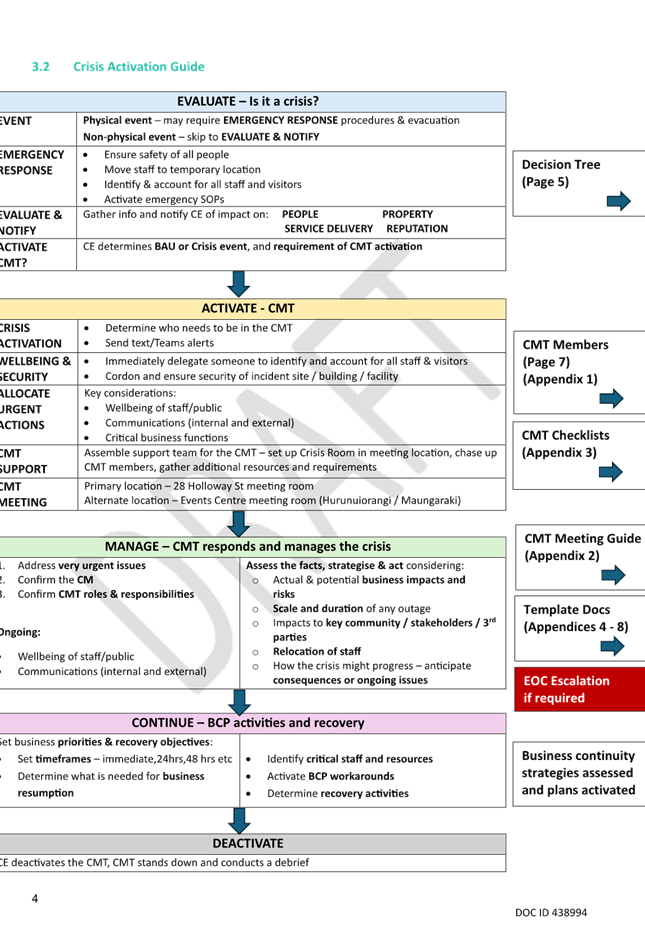
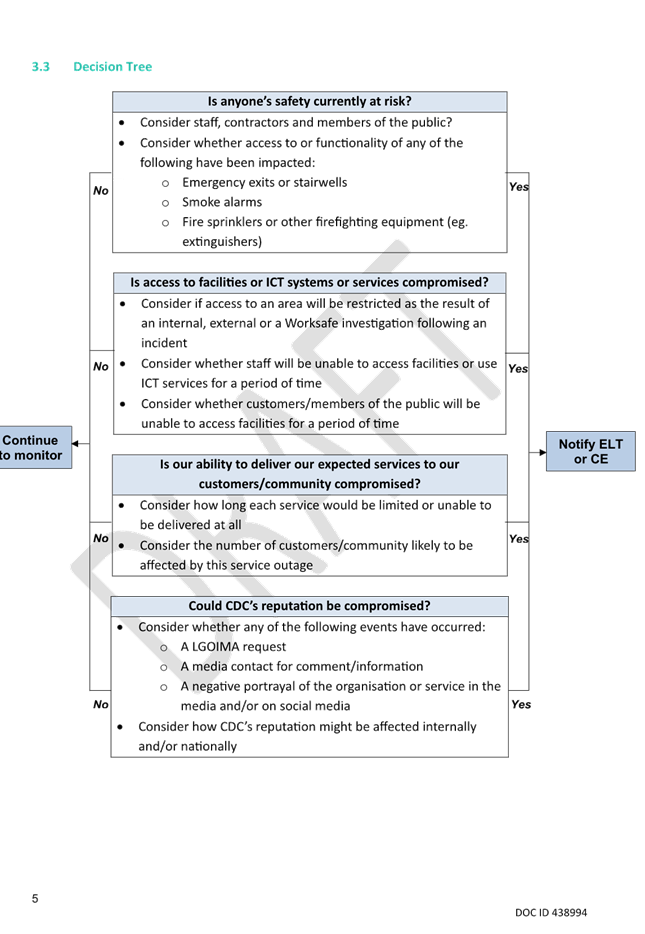
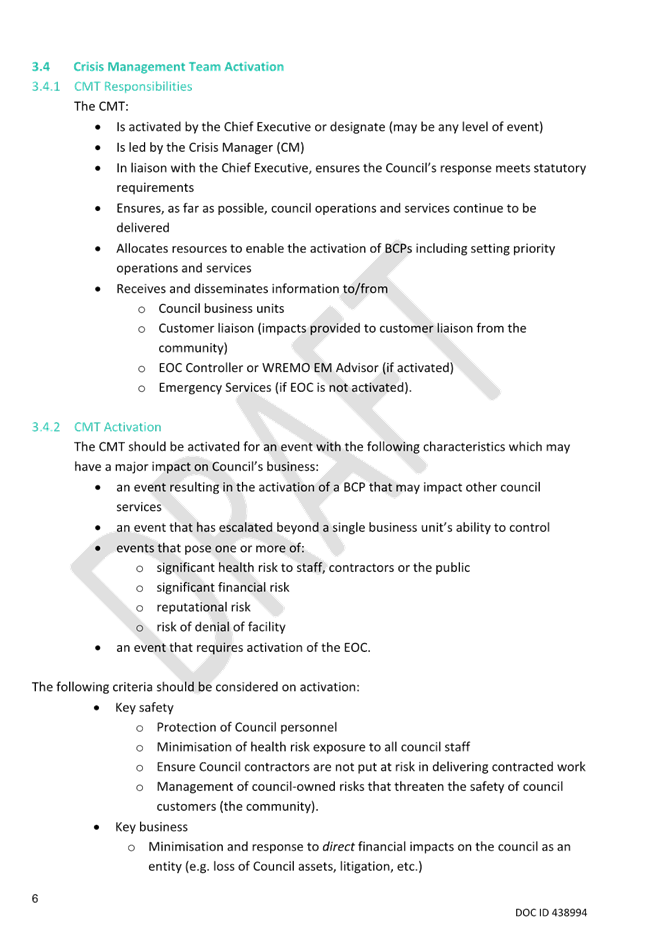
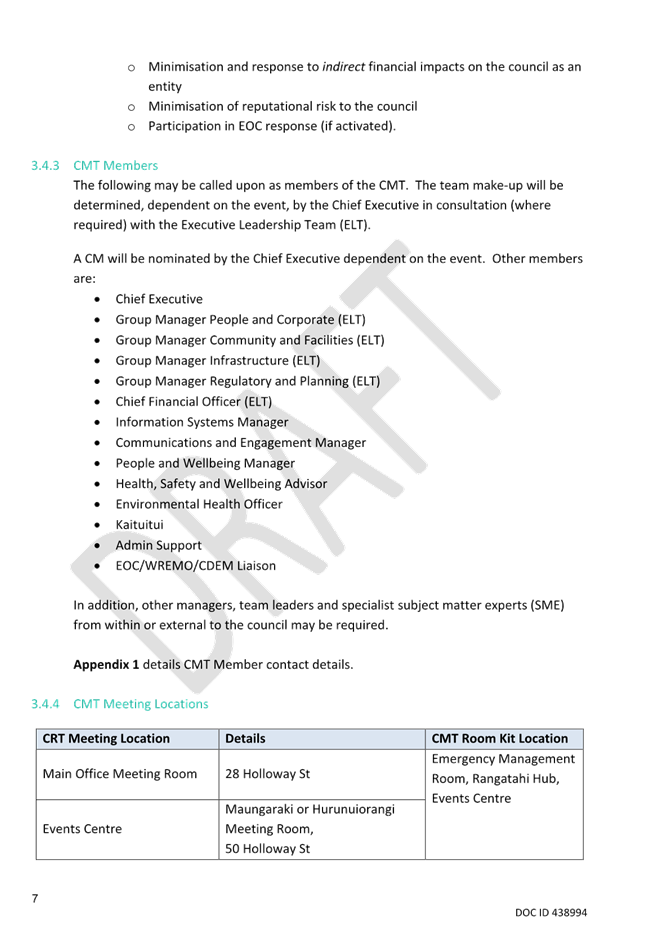
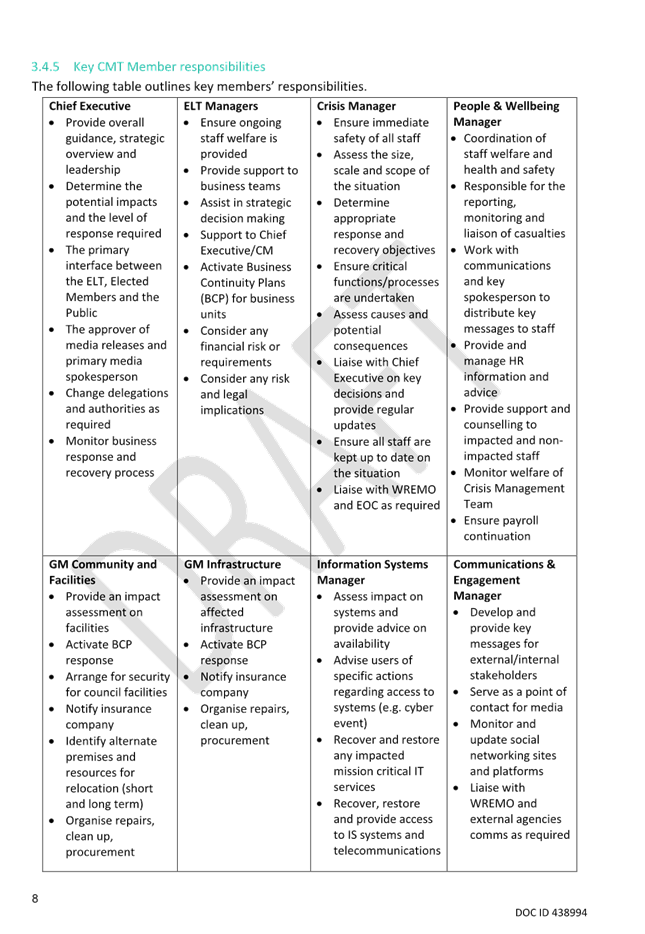
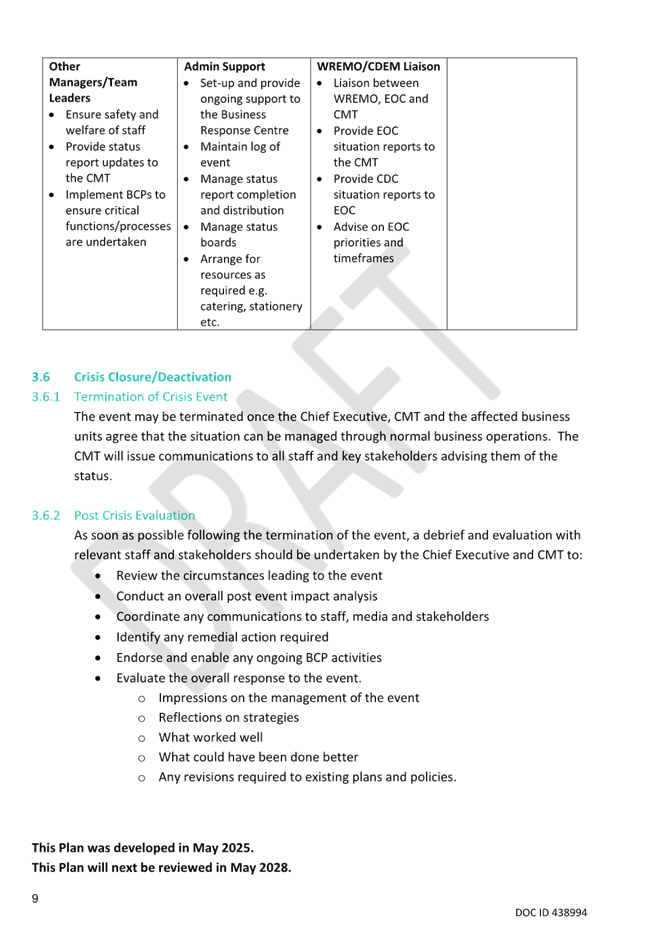
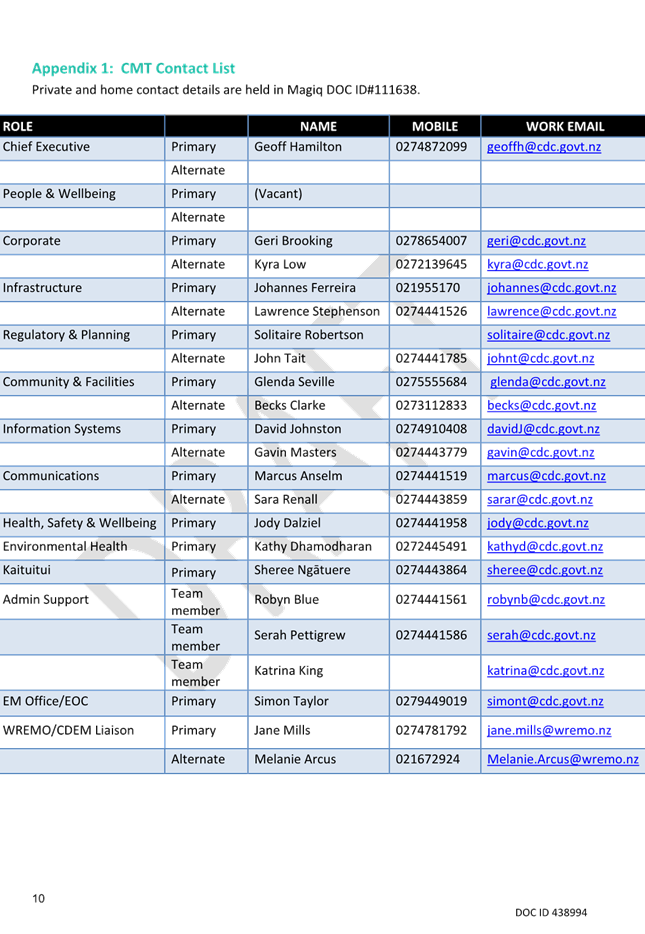
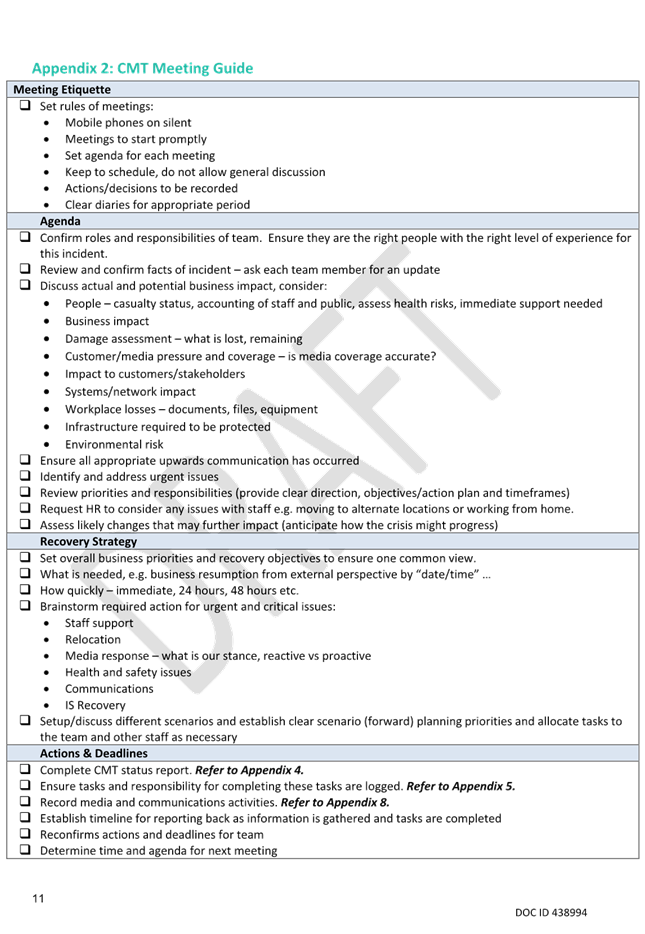
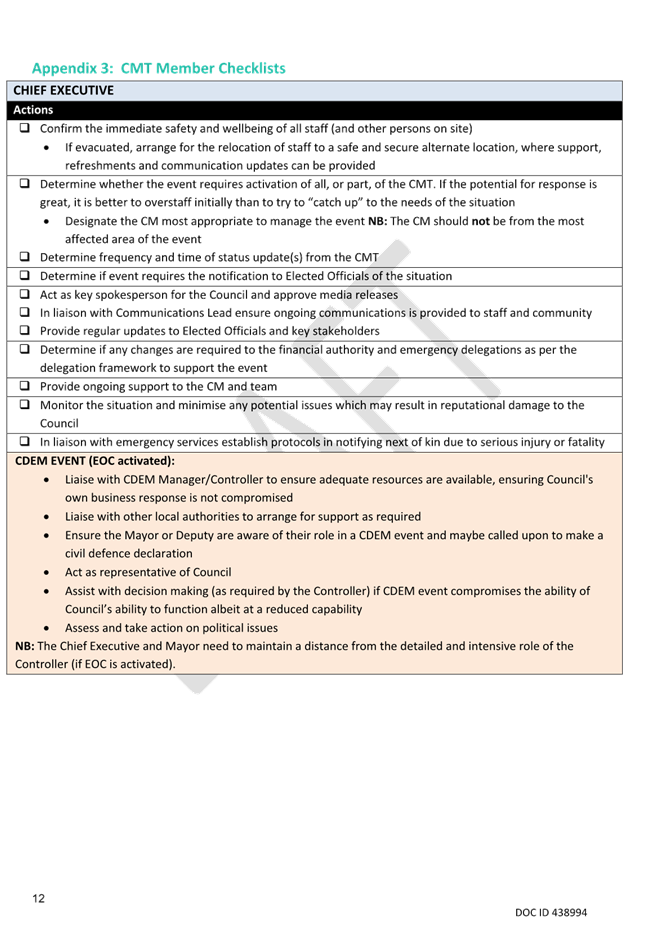
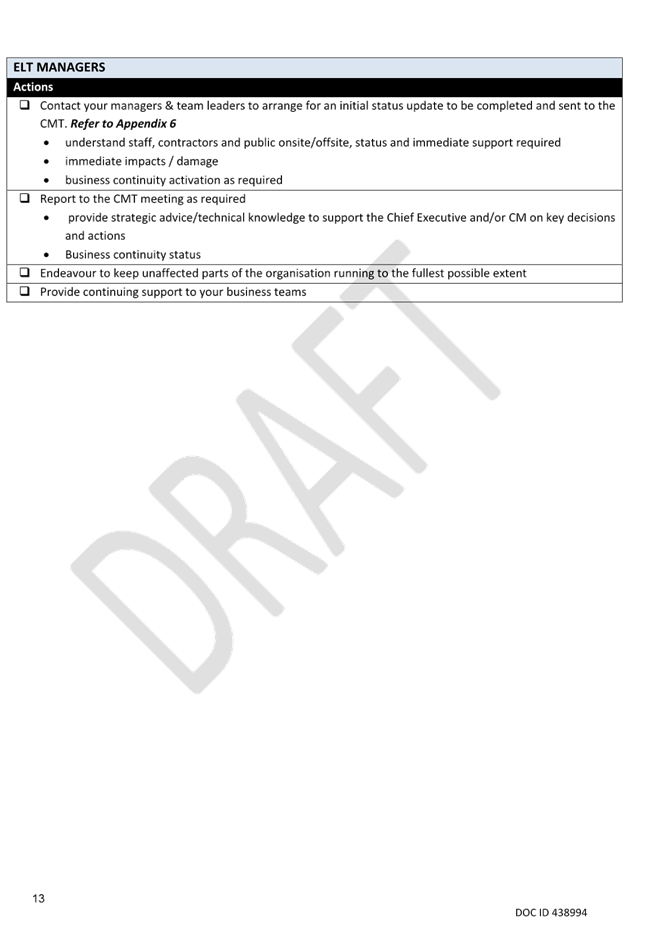
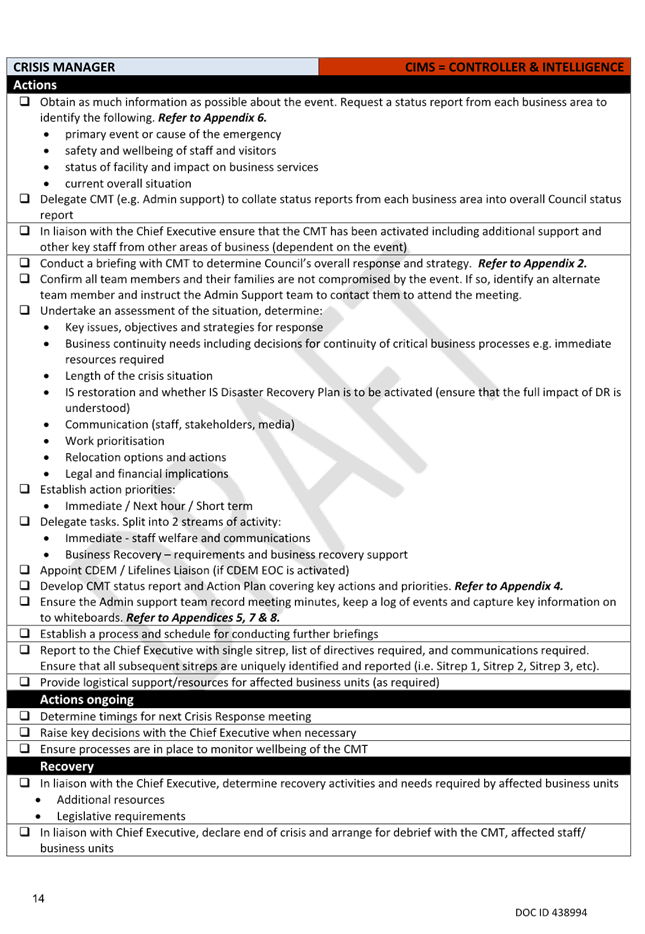
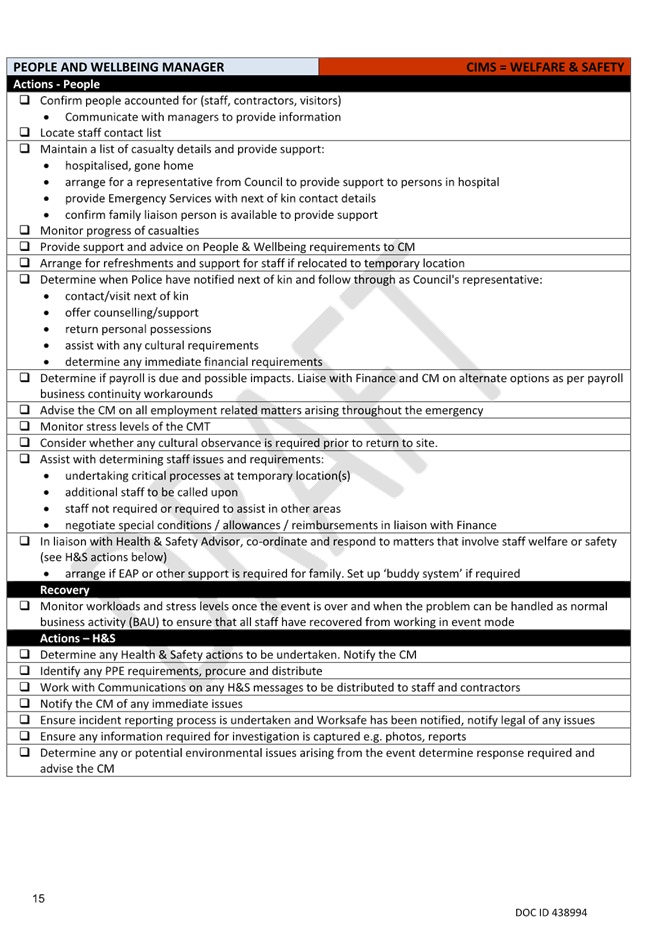
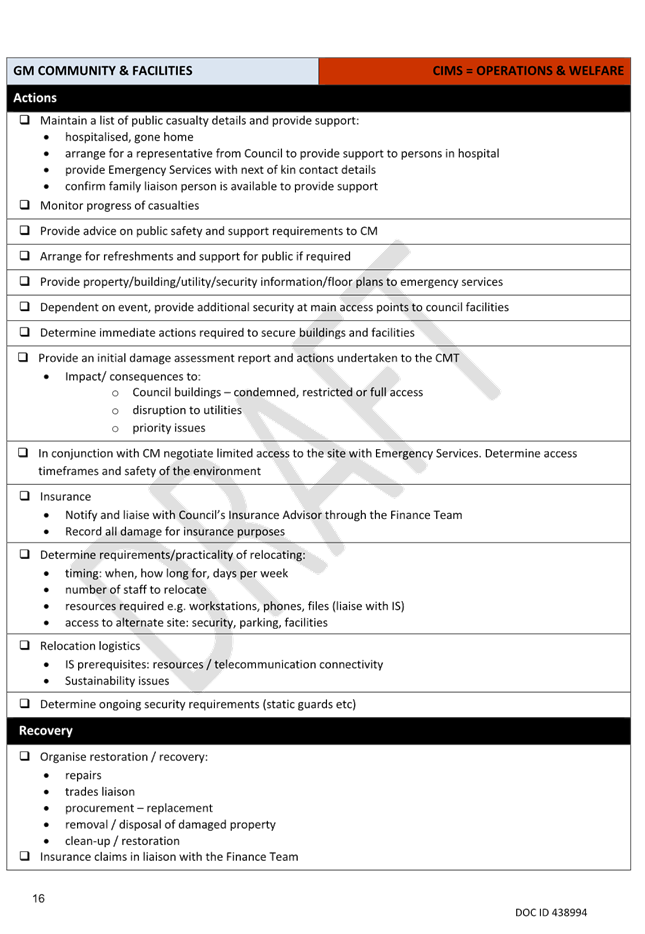
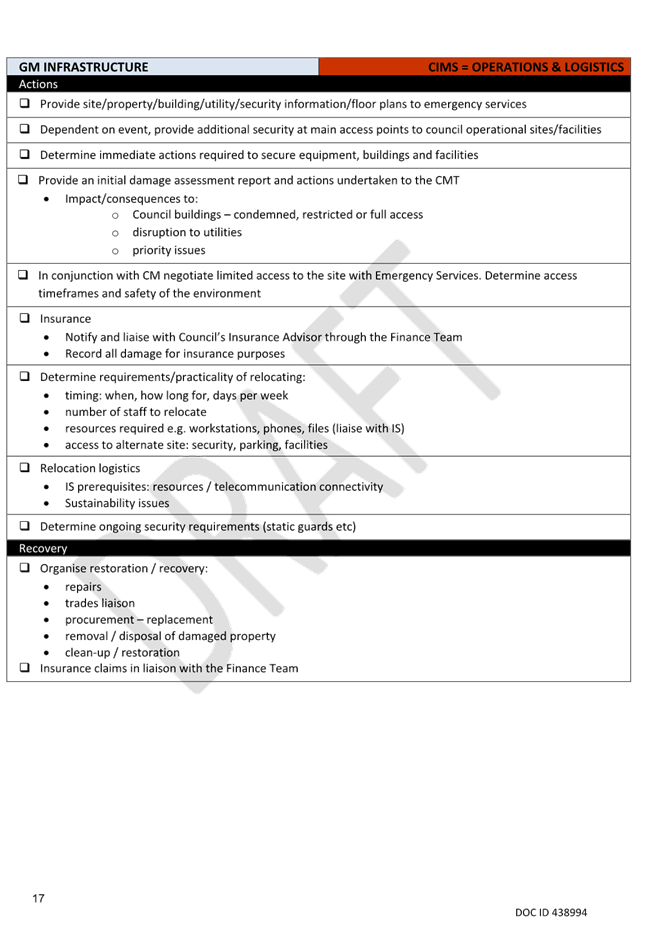
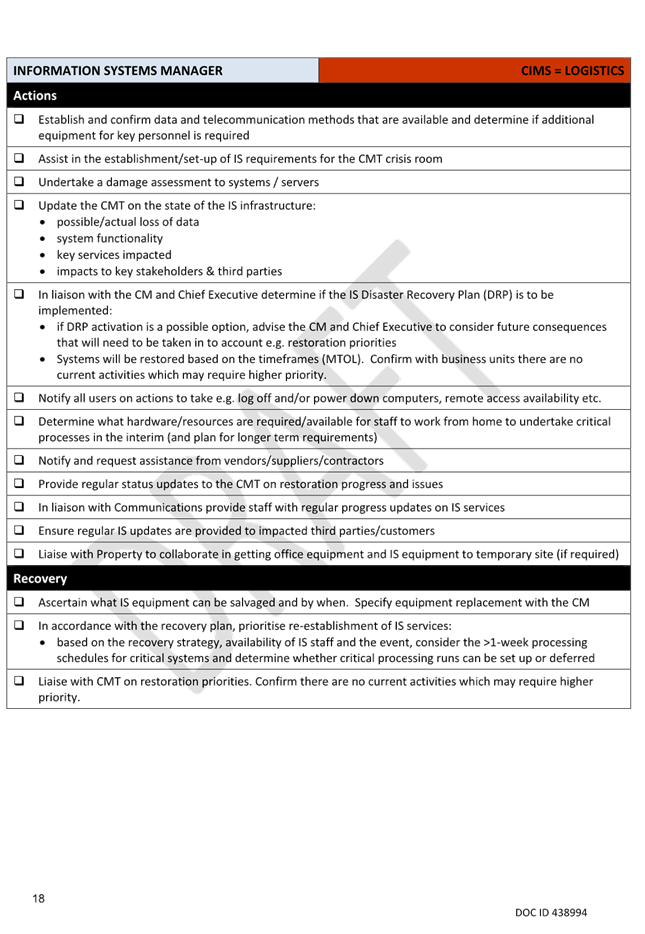
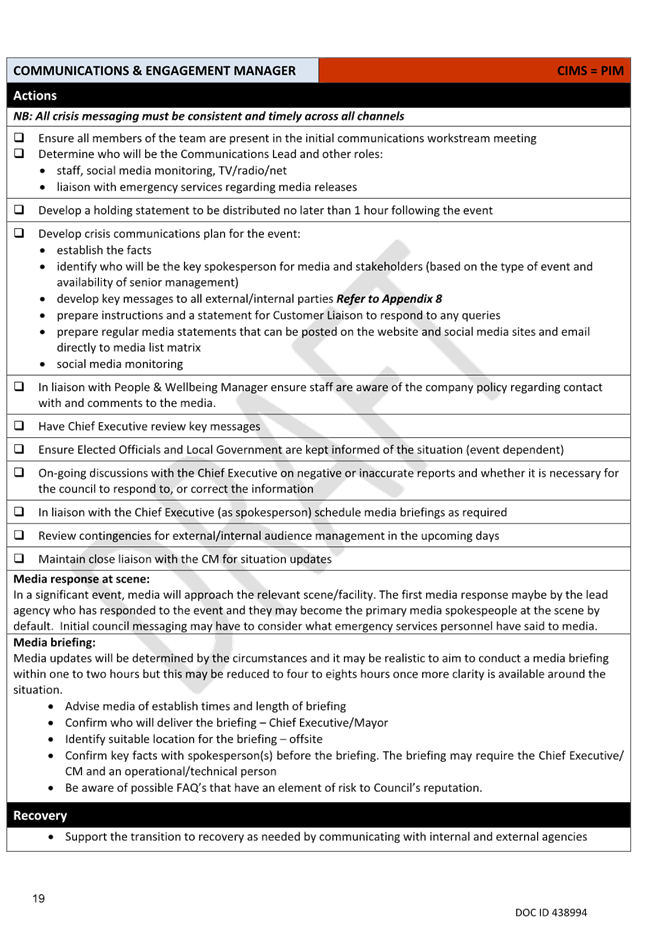
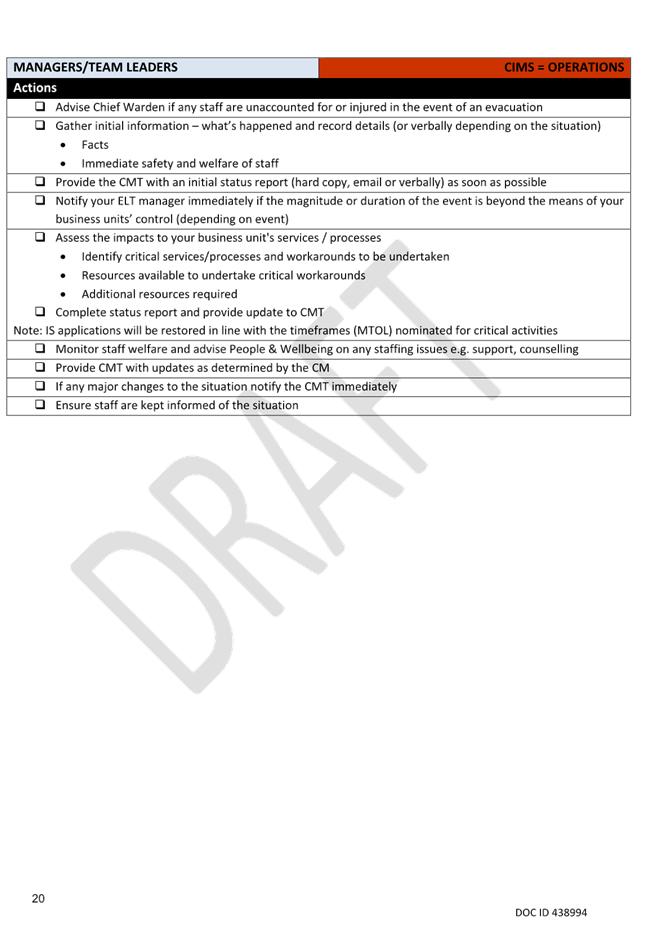
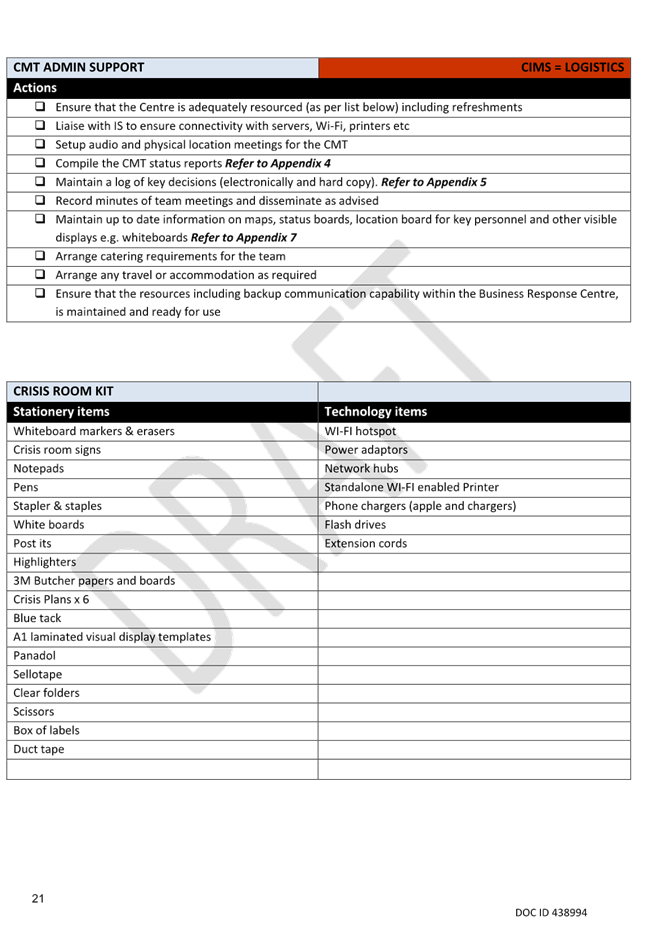
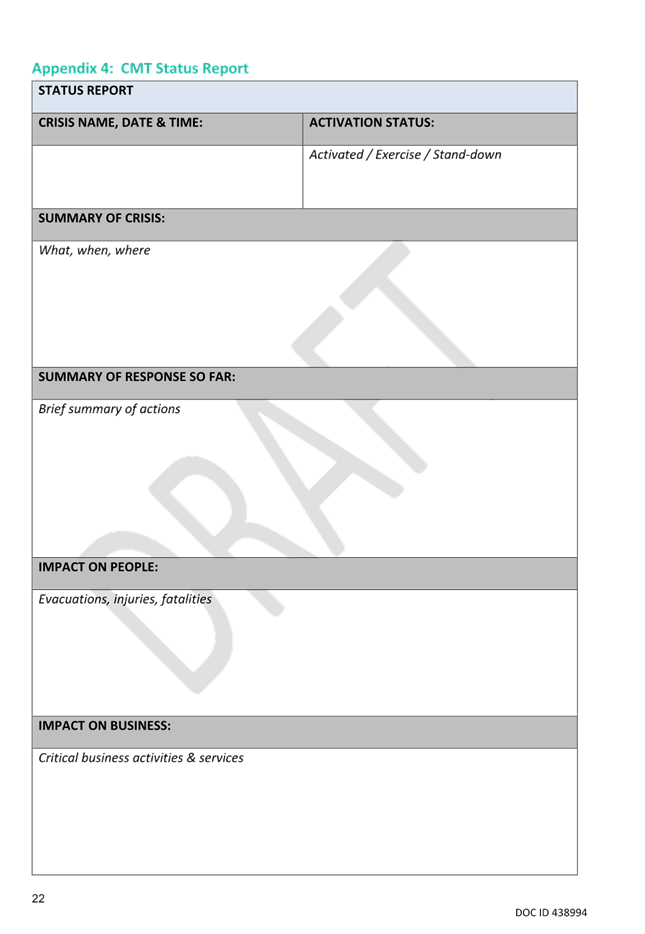
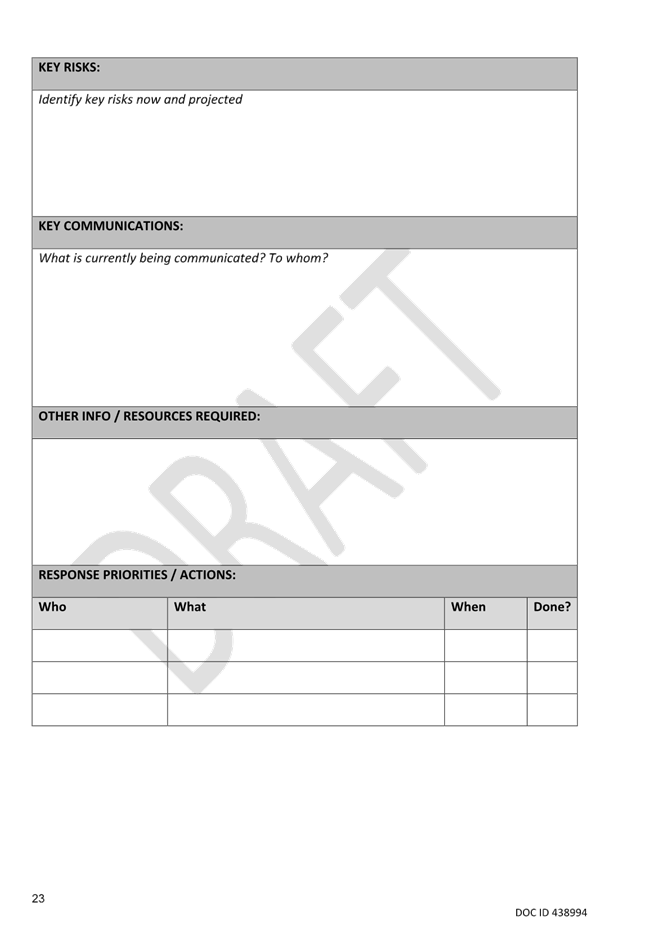
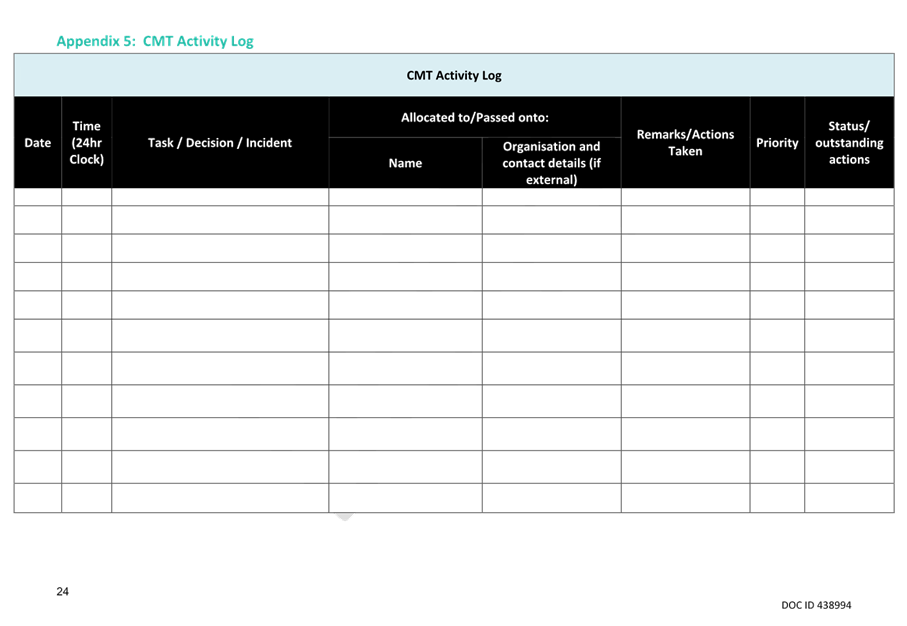
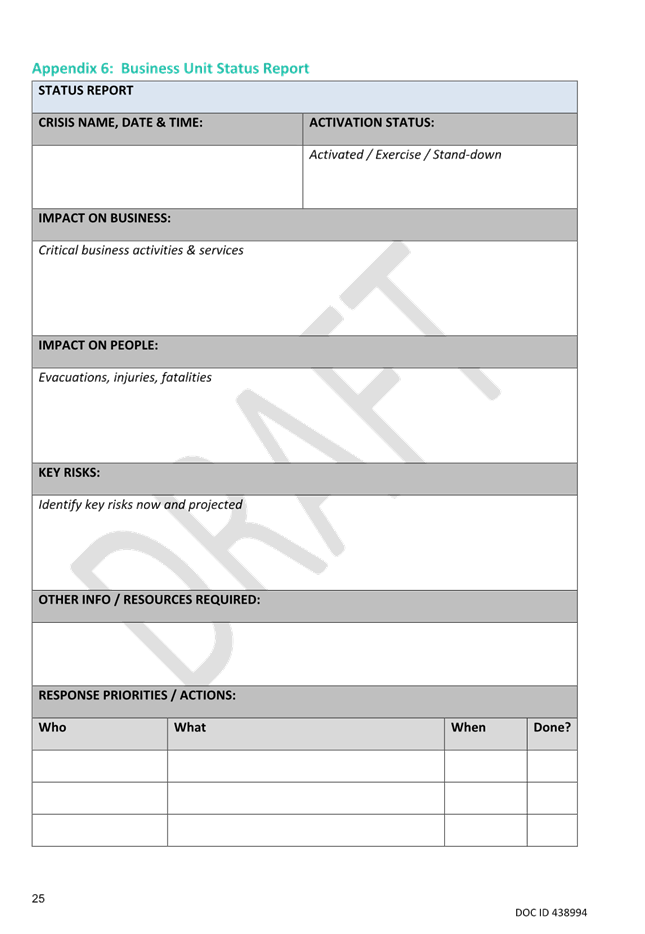
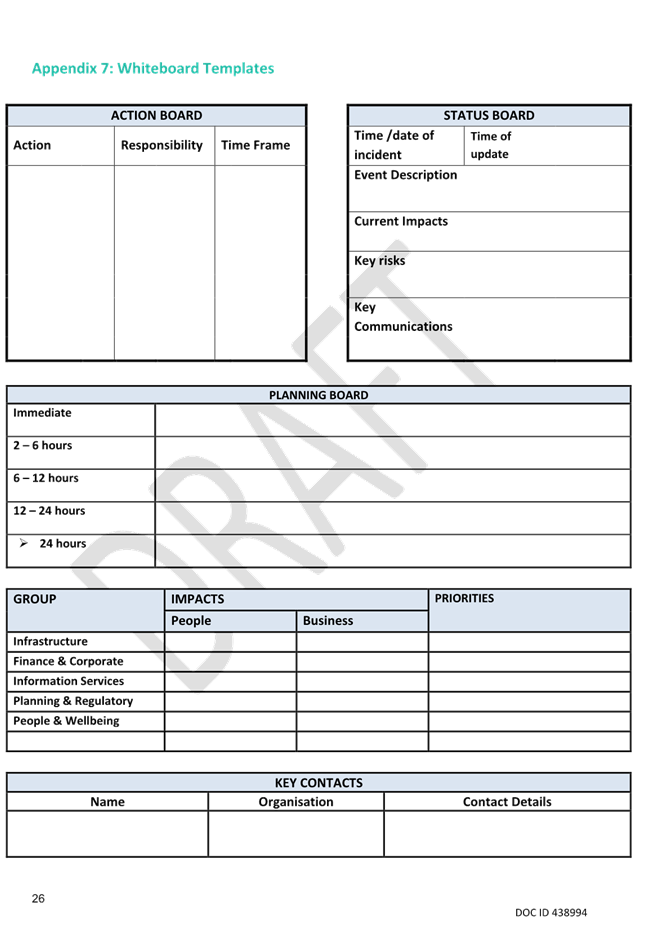
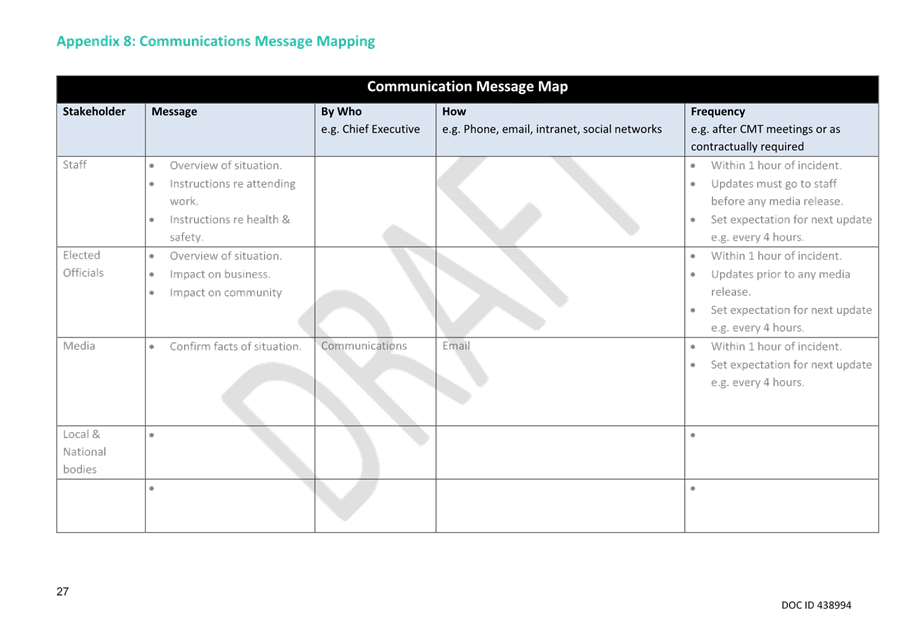
|
Policy
and Projects Committee meeting Agenda
|
18
June 2025
|

7.11 Update
on Planning Resource Consents
1. Purpose
The purpose of this
report is to update the Committee on the resource consents issued since the
previous update.
2. Significance
The
matters for decision in this report are not considered to be of significance
under the Significance and Engagement Policy.
3. Background
The
Terms of Reference for the Policy and Projects Committee include oversight of
implementation of the Wairarapa Combined District Plan. The resource
consents issued since the last report, from 2 April to 10 June 2025, are
included in Attachment 1.
4. CONSIDERATIONS
4.1 Climate change
N/A
4.2 Tāngata whenua
N/A
4.3 Financial impact
N/A
4.4 Community Engagement
requirements
Not applicable as
consultation requirements for resource consents are prescribed under section
95A-95B of the Resource Management Act 1991.
4.5 Risks
N/A
5. Recommendation
That the Committee:
1. Receives
the report.
File
Number: 461236
Author: Solitaire
Robertson, Planning and Regulatory Services Manager
Attachments: 1. Resource
Consents update to 10 June 2025 ⇩
|
Policy
and Projects Committee meeting Agenda
|
18
June 2025
|
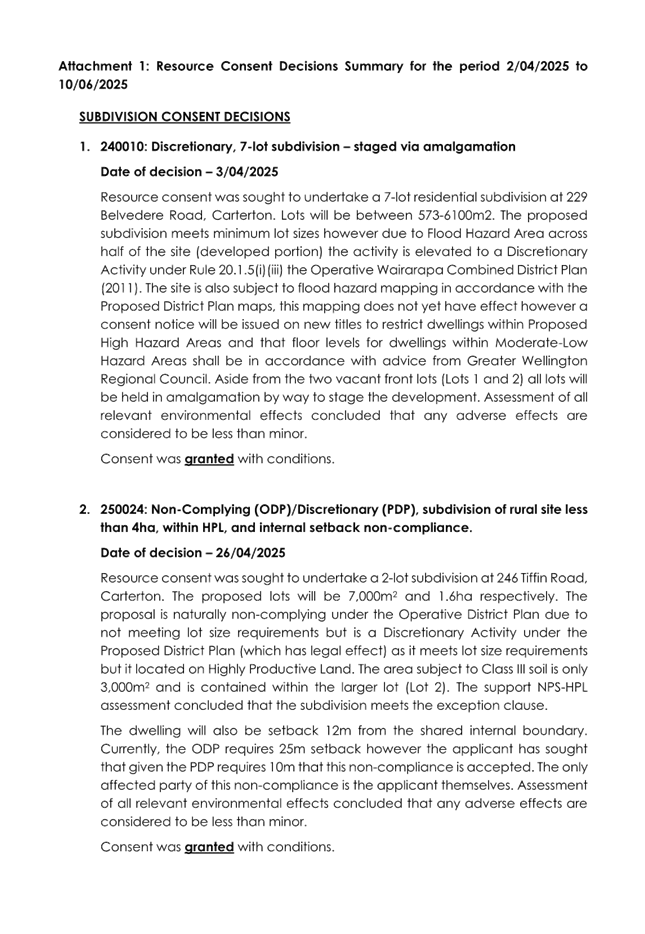
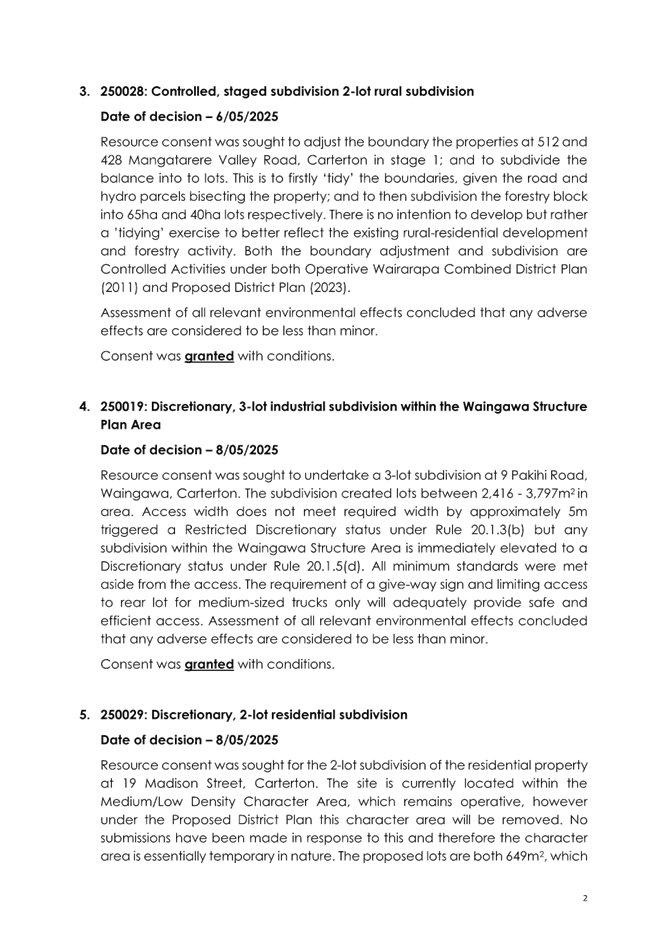
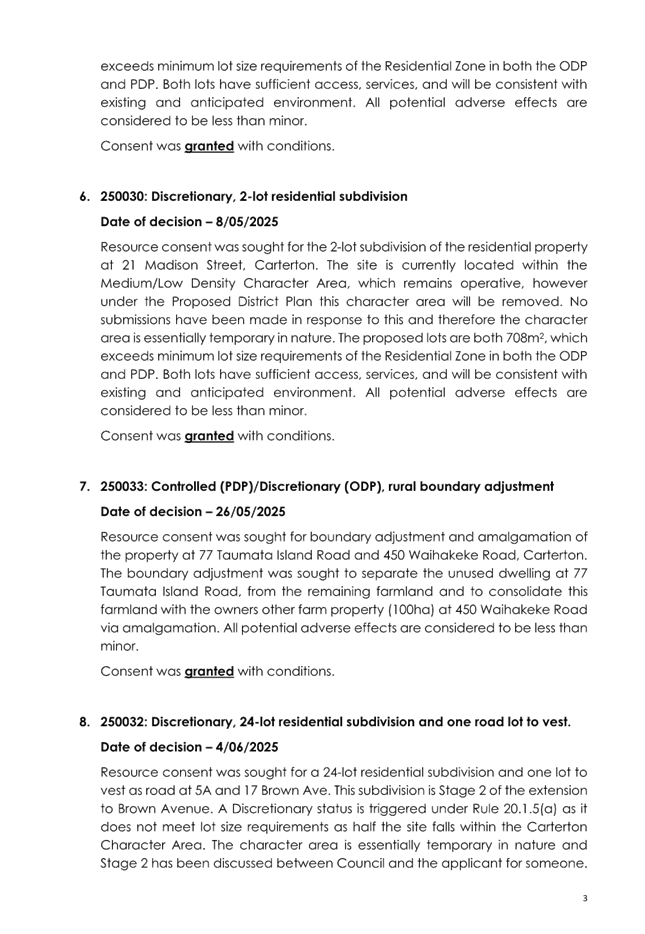
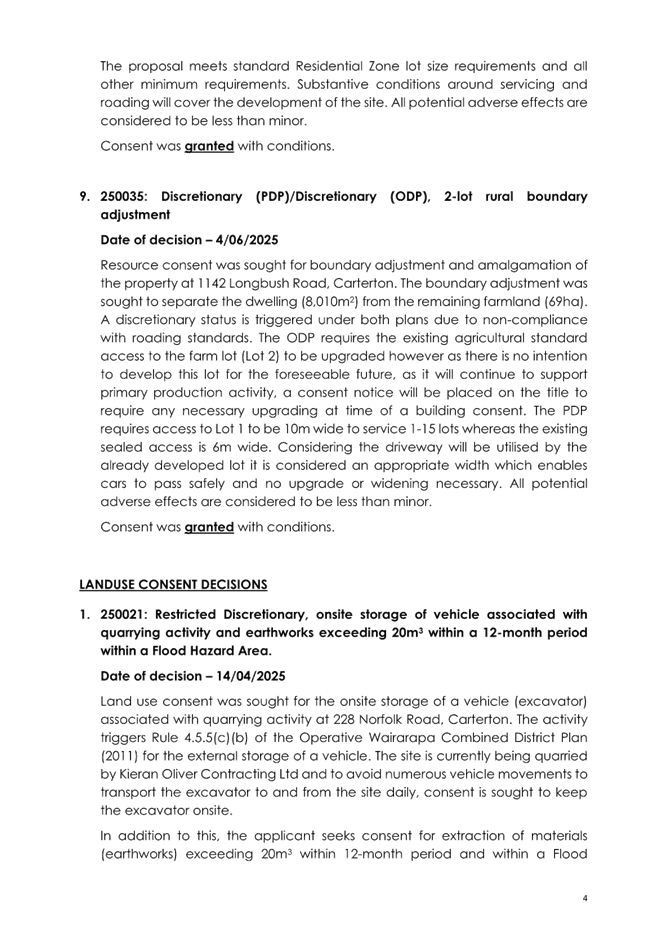
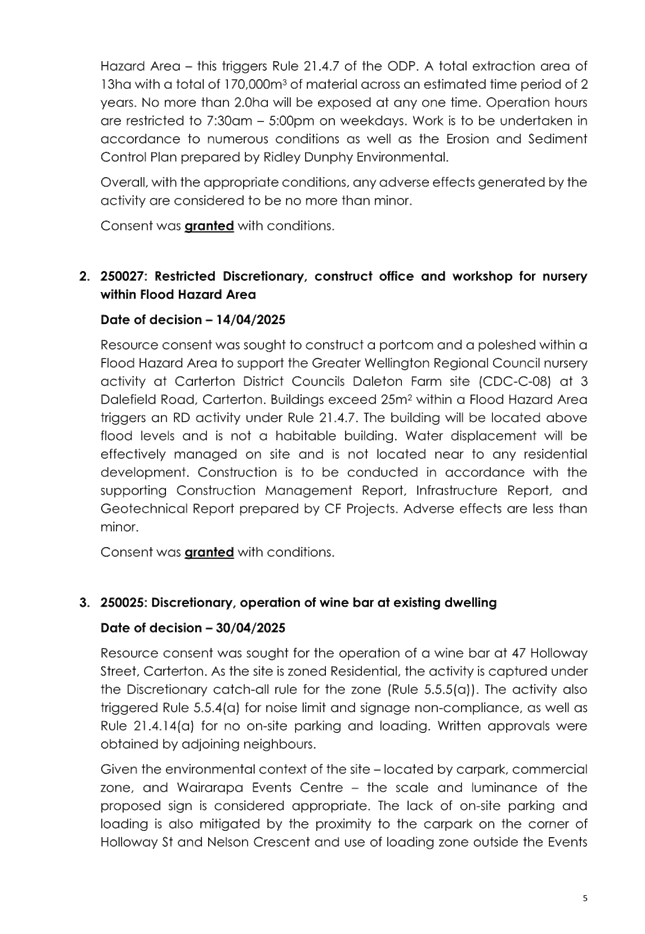
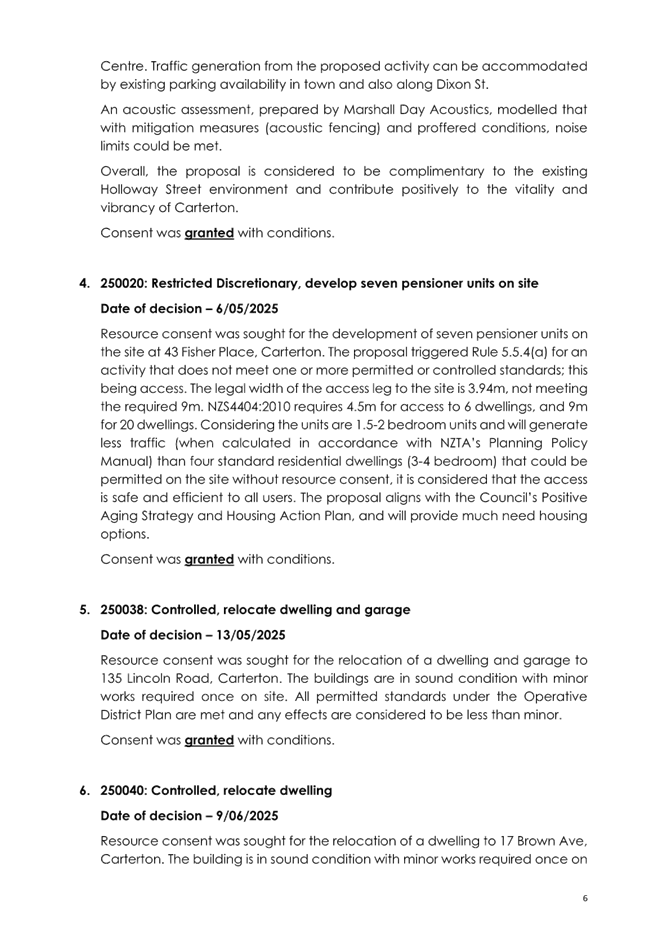

|
Policy
and Projects Committee meeting Agenda
|
18
June 2025
|

7.12 Advisory
Group Updates
1. Purpose
For the Committee to
be updated on activities and highlights from the Advisory Group meetings.
2. Recommendation
That the Committee:
1. Receives
the draft meeting notes from the Walking and Wheels and Rural Advisory Groups.
File
Number: 464187
Author: Robyn
Blue, Democratic Services Officer
Attachments: 1. DRAFT
meeting notes Walking & Wheels Advisory Group 4 June 2025 ⇩
2. DRAFT
meeting notes Rural Advisory Group, 4 June 2025 ⇩
|
Policy
and Projects Committee meeting Agenda
|
18
June 2025
|
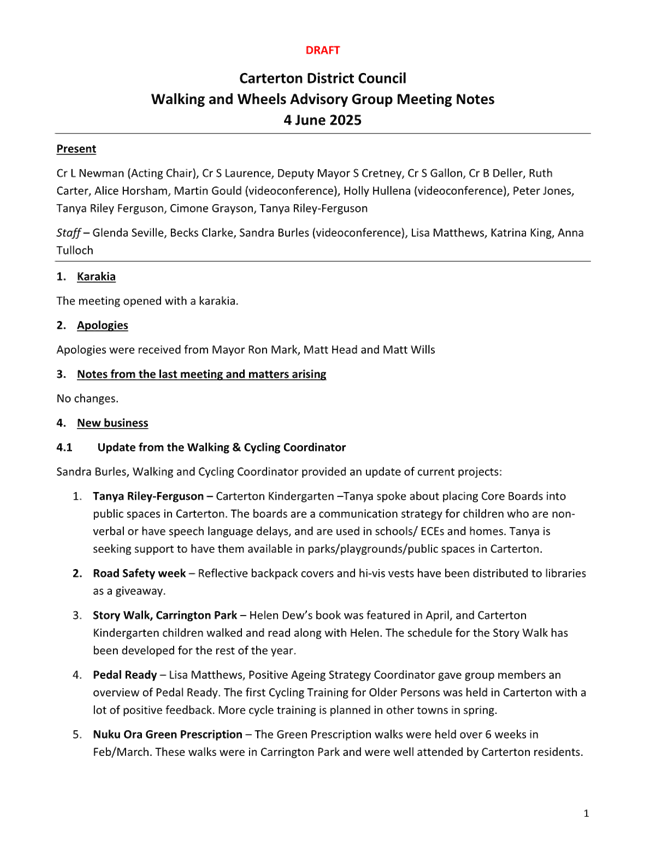
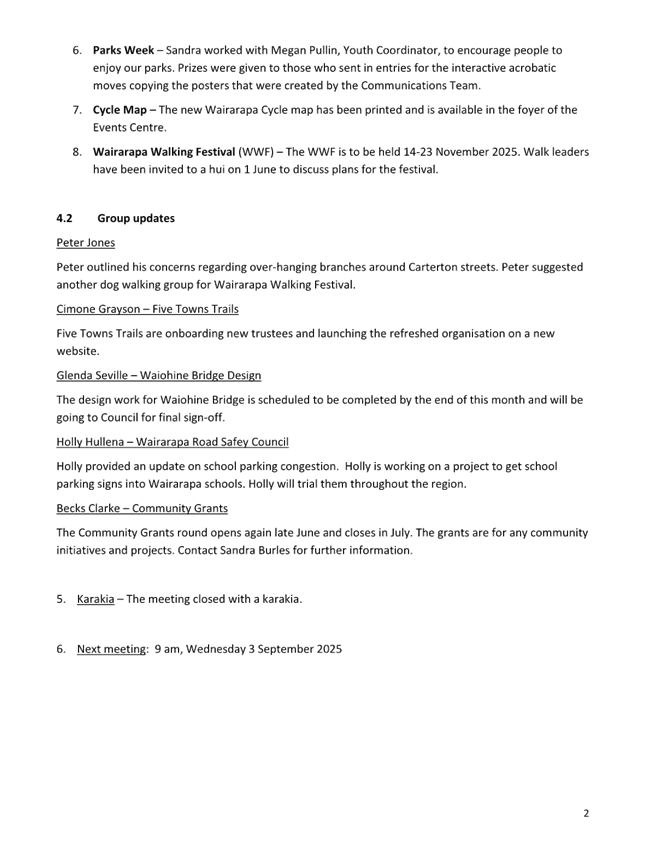
|
Policy
and Projects Committee meeting Agenda
|
18
June 2025
|
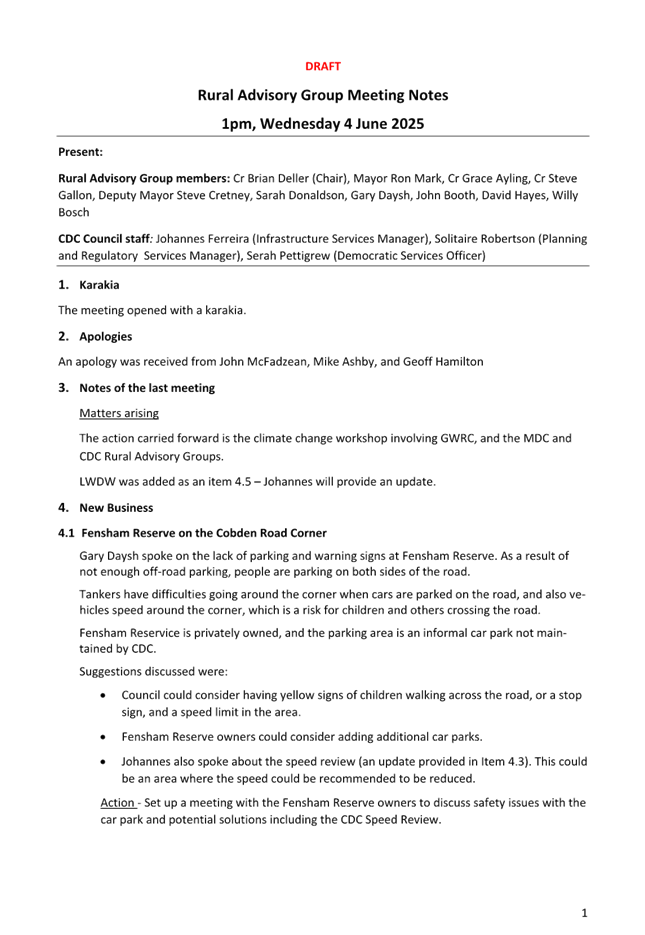
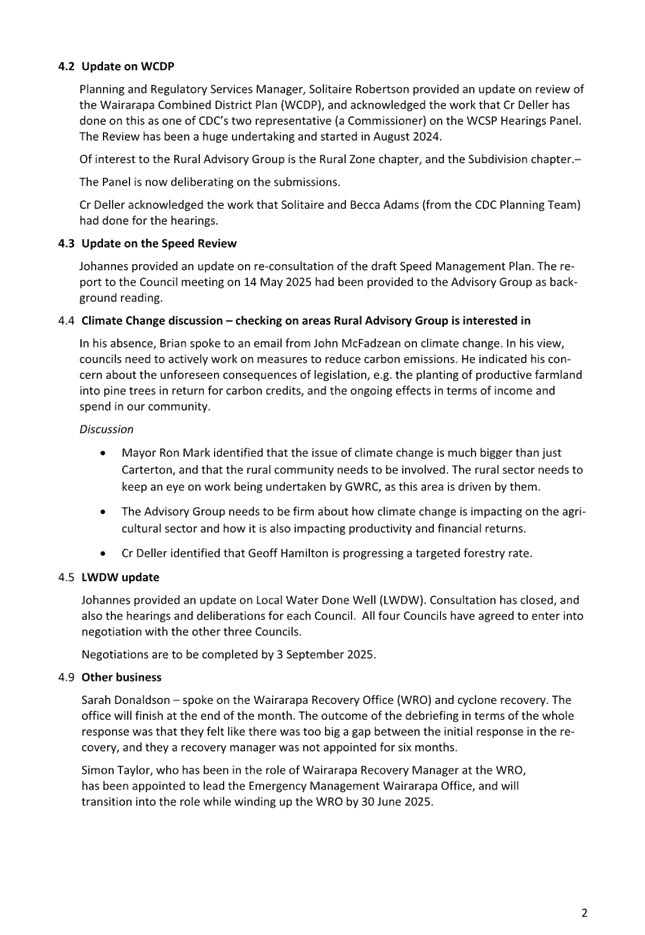
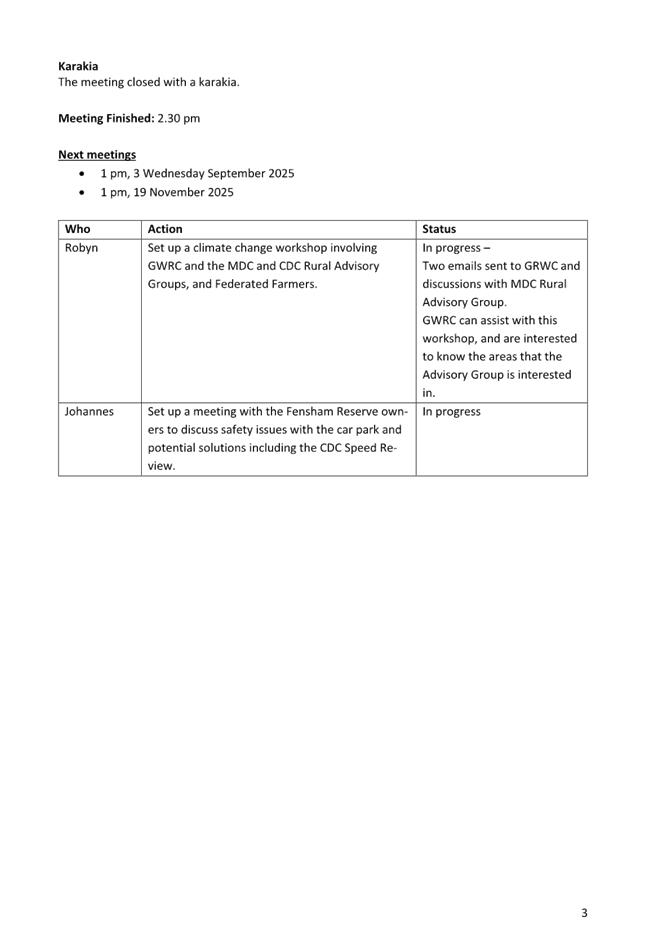
8 Karakia
Whakamutunga
Kia
whakairia te tapu
Kia
wātea ai te ara
Kia
turuki whakataha ai
Kia
turuki whakataha ai
Haumi
ē, hui ē, taiki ē

































































































































